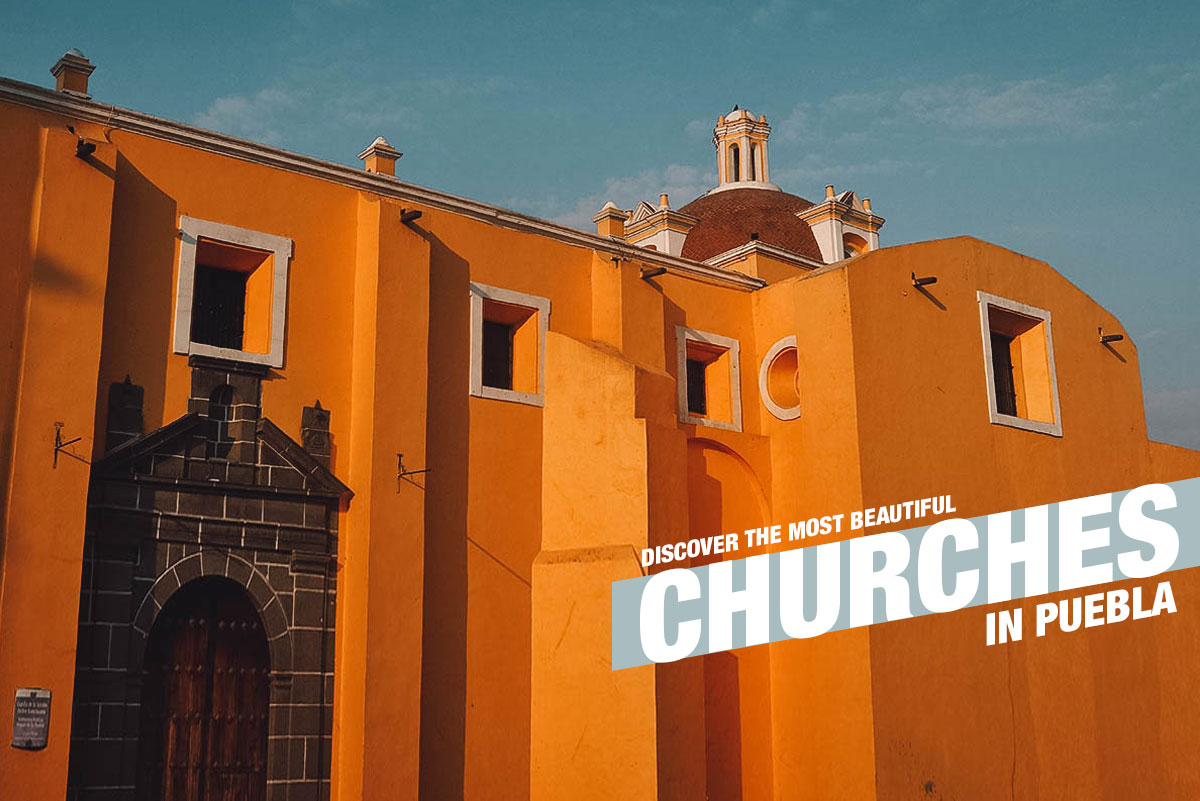The complete name of Puebla City is Puebla de Zaragoza. Not as many foreigners know this, but perhaps even fewer know that Puebla de Zaragoza was originally called Puebla de los Ángeles or “City of Angels”.
According to legend, one of the city’s founders – Bishop Julian Garces of Tlaxcala – had a dream where a group of angels descended from the heavens to map out a city between Veracruz and Mexico City. Together with his Franciscan brothers, he set out on a quest to find this valley. When they did, the City of Angels was born.
So rich in religious heritage is Puebla that several legends point to the presence of angels during its foundation. One popular story claims that it was the angels themselves who raised the 8-ton bell Campana Maria to the top of the Cathedral’s tower.
Today, people say there are as many churches in this city built by angels as there are days in the year. In this article, we’ll show you thirty of the most beautiful.
VISIT PUEBLA QUICK LINKS
TOURS
To help you maximize your time in Puebla, we’ve compiled links to recommended tours and activities here. Click on the link for a guide to some of the best Puebla Tours.
- Guided Tours: Puebla Sightseeing and Food Tours
- Day Trips: Day Trips to Puebla from Mexico City
- Cooking Classes: Puebla Cooking Classes
HOTELS
Top-rated hotels in the Historic Center, the best area to stay for people on their first trip to Puebla. Click on the link for more Puebla hotel recommendations.
- Luxury: Casona de los Sapos Hotel Boutique
- Midrange: Hotel Boutique Casareyna
- Budget: Hostal Casa De Arcos
OTHER SERVICES
- Mexico Tourist Card (FMM)
- Travel Insurance (non-US residents get 5% off)
- Mexico SIM Card / eSIM
- Car Rental
- Mexico Bus Tickets
PUEBLA TRAVEL GUIDE
Check out our in-depth guide to Puebla City to help you make the most of your trip.
Save This on Pinterest!
No time to read this guide on the most beautiful churches in Puebla? Click on the save button and pin it for later!
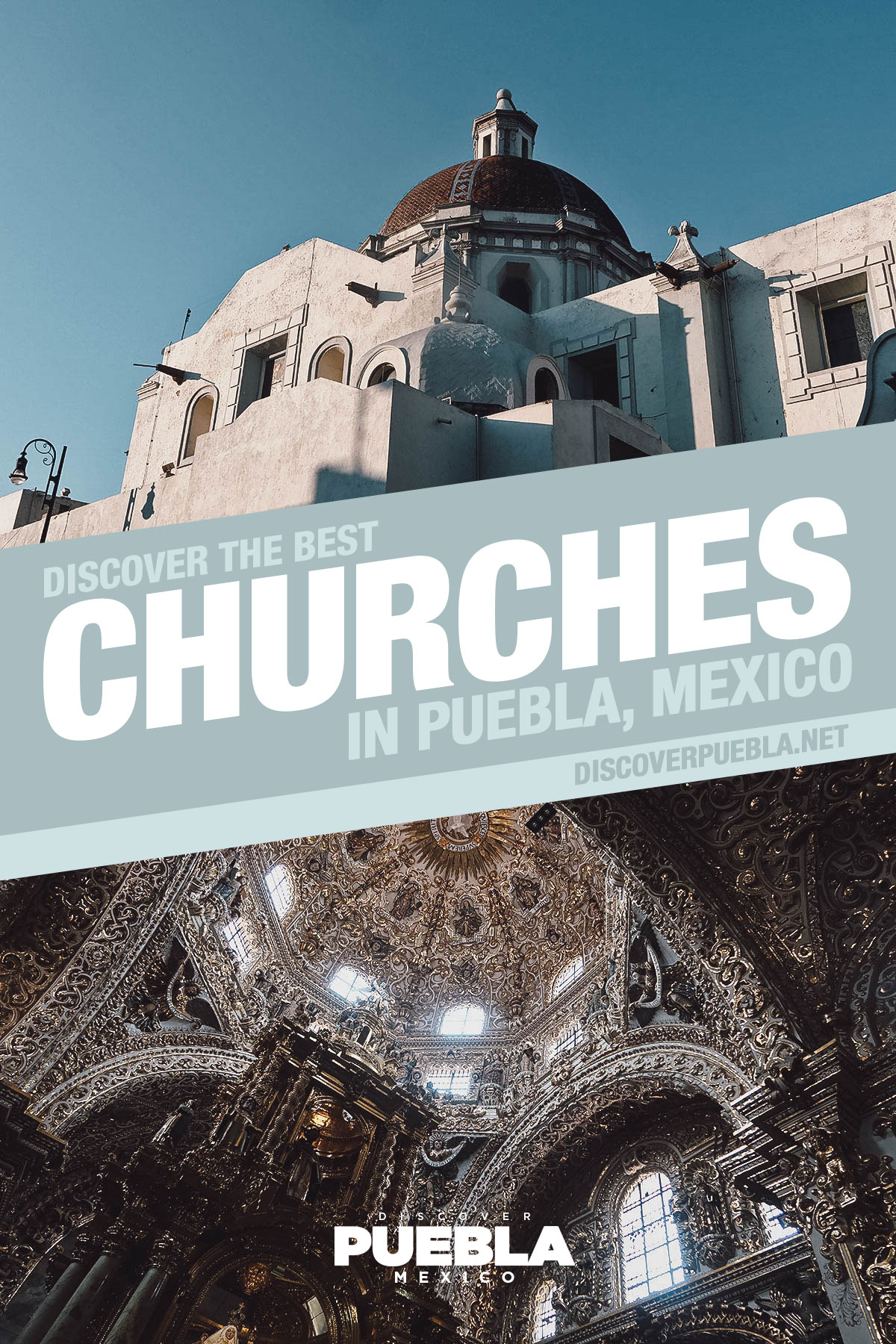
HOW MANY CHURCHES ARE THERE IN PUEBLA, MEXICO?
There are officially 288 parishes in Puebla City. Not exactly one for every day of the year, but it’s still an impressive number considering Puebla covers an area of less than 80 square miles (207 sq km). And that count doesn’t include the many chapels, shrines, and oratories in the city.
So why are there so many churches in Puebla? The reason isn’t entirely clear, but Spanish colonists built so many chapels starting in the 16th century that people believed they were building one for every year. Within the 2.7 sq mile radius (6.9 sq km) of the Historic Center alone, you’ll easily find over three or four dozen.
Puebla is known for its regional cuisine and Talavera pottery, but it’s also home to many stunning churches, many of which you can visit on a day trip from Mexico City. You can refer to the location map at the bottom of this article to see exactly where they are in Puebla.
THE MOST BEAUTIFUL CHURCHES IN PUEBLA, MEXICO
30. Parroquia de Santa Clara de Asís
The Parish of Santa Clara is located along Avenida 6 Oriente, more famously known as “Calle de los Dulces”. This street is known for its many shops selling dulces tipicos or Poblano traditional sweets. This is significant because the nuns of the Santa Clara convent were credited for inventing one of Puebla’s most famous confections – the tortita de santa clara.
Another event in this church’s history stands out. It’s located across the street from the former house of Aquiles Serdan, a Mexican politician and supporter of the rebellion against the Diaz government. When the government sent for him to be arrested on November 18, 1920, a gunfight ensued with many of the police shooting at the house from the roof of this church.
Serdan was killed that day. It’s an historic event that many people believe was the catalyst of the Mexican Revolution. Today, the former Serdan house is one of the most interesting museums you can visit in Puebla.
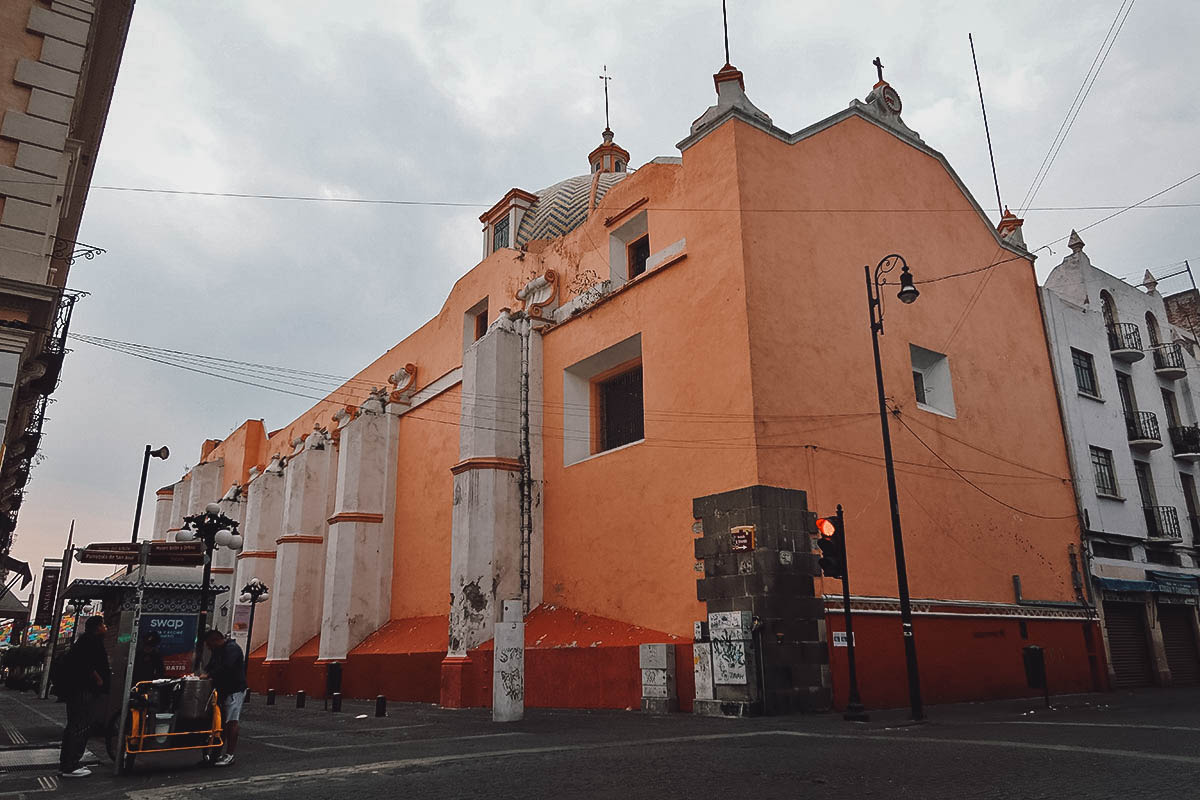
The Parish of Santa Clara looks rather plain from the outside but its interior is a different story. According to the church’s description, the church was built to receive young nuns who had little economic support.
Of all the churches on this list, Parroquia de Santa Clara de Asís was one of the hardest to visit. I went many times but it only seems to open for 9AM mass on Sundays.
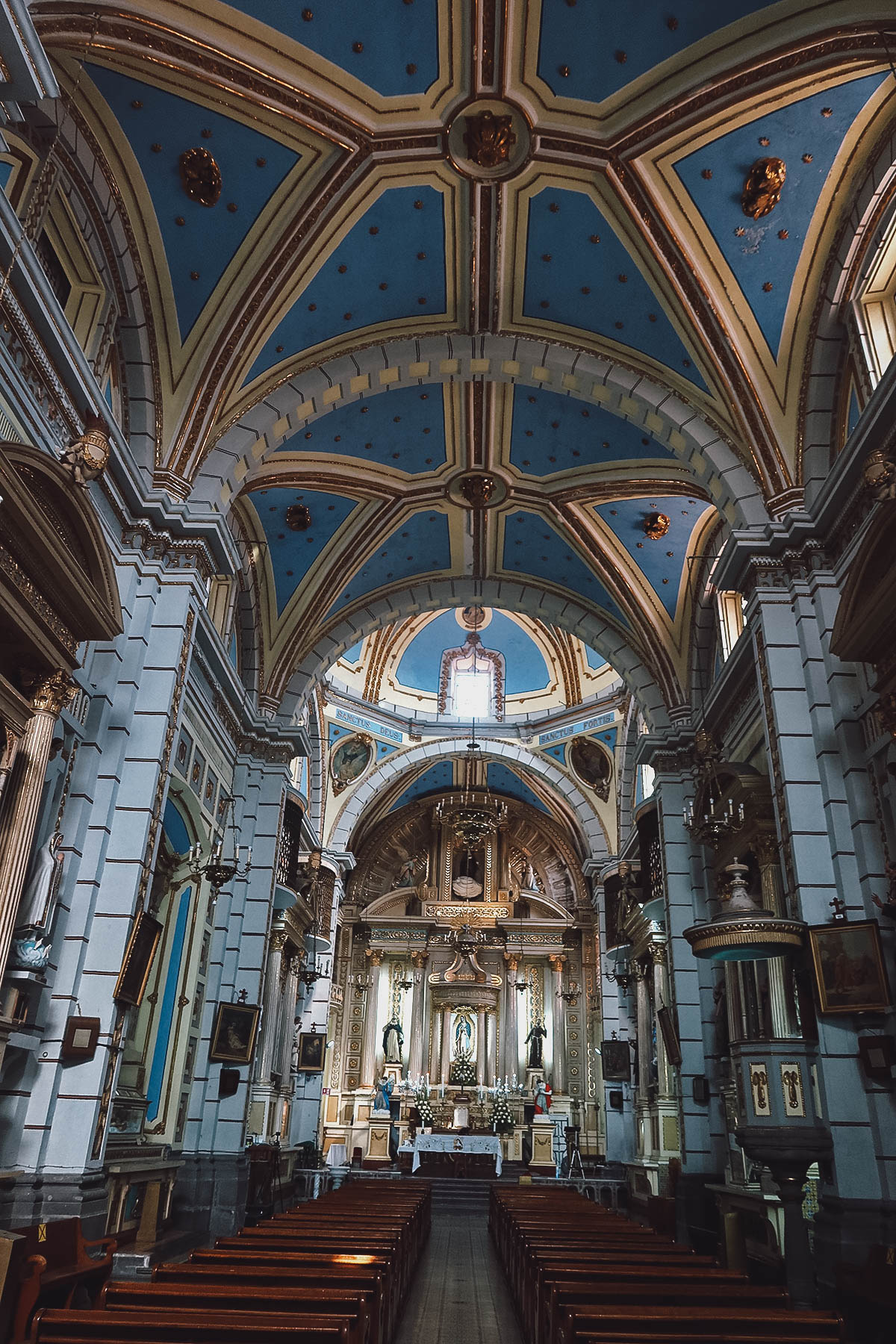
Parroquia de Santa Clara de Asís
Address: Av 6 Ote 201, Centro, 72000 Puebla, Pue.
29. Parroquia del Sagrario Metropolitano (Templo de Nuestra Señora de la Soledad)
I couldn’t find as much information about Parroquia del Sagrario Metropolitano, other than the fact that it was completed and consecrated in 1631. Due to the growth of its congregation, it had to be enlarged and consecrated again in 1749.
This church houses the image of Our Lady of Solitude. It’s flanked on either side by sculptures of Saint John and Saint Mary Magdalene.
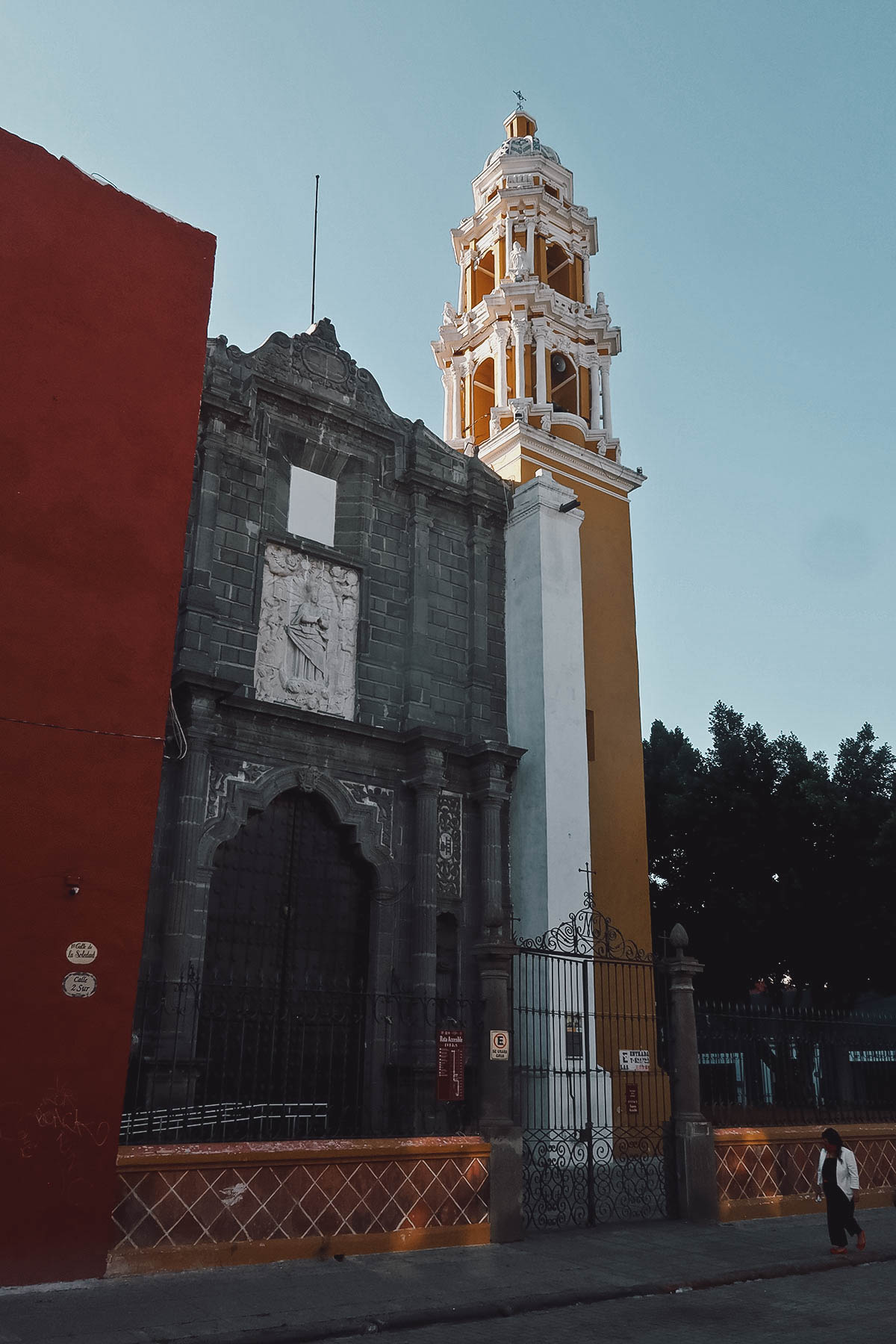
Inside the church are six neoclassical altars dedicated to Our Lady of Guadalupe, Jesus of Nazareth, the Sacred Heart of Jesus, San Antonio de Padua, San Juan Nepomuceno, and San Luis Gonzaga. Each of these altars houses a statue of the apostles brought in from Paris.
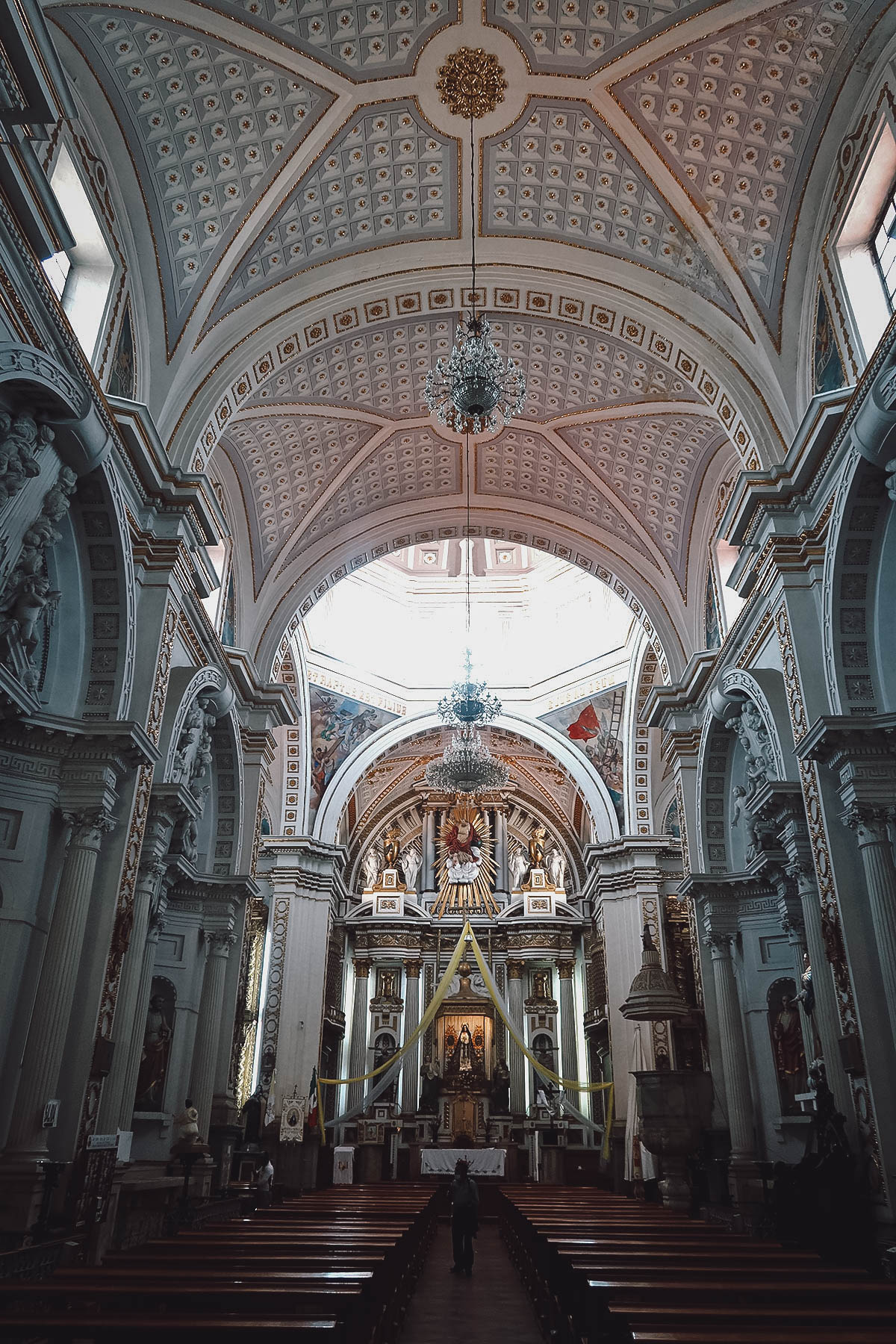
Parroquia del Sagrario Metropolitano (Templo de Nuestra Señora de la Soledad)
Address: Av 2 Sur 1106, Centro histórico de Puebla, 72530 Puebla, Pue.
28. Iglesia del Cielo (Parroquia de Nuestra Señora del Sagrado Corazón)
If you’re willing to walk, then you can visit this beautiful church at the top of Cerro de San Juan (Hill of San Juan). Aptly nicknamed Iglesia del Cielo or “Church of Heaven”, it’s a relatively new church that was built in 1969 and promoted to parish a few years later.
Parroquia de Nuestra Señora del Sagrado Corazón is about 2.2 miles (3.5 km) west of the zocalo (main square). It took me about 45 minutes to get there on foot but it was worth it. It’s in a more upscale residential neighborhood of Puebla with great views of the surrounding areas.

The interior of Iglesia del Cielo is less ornate compared to many of the other churches on this list but it’s no less impressive.
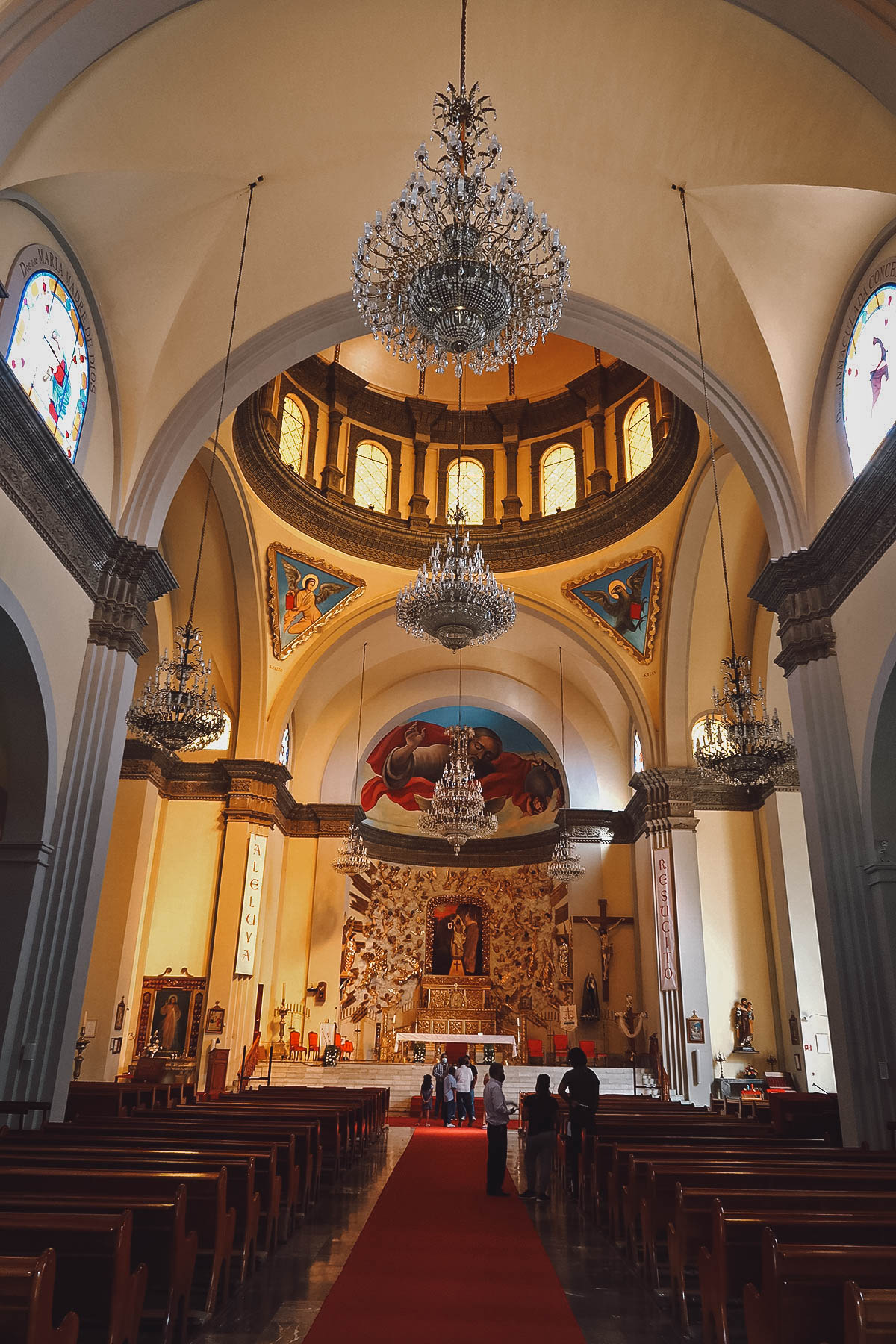
Iglesia del Cielo (Parroquia de Nuestra Señora del Sagrado Corazón)
Address: Esperanza 1, La Paz, 72160 Puebla, Pue.
27. Convento de Clarisas Capuchinas Franciscanas de San Francisco de Asís
Founded in 1704, this Catholic church in the Historic Center of Puebla houses the Capuchin nuns of St. Francis and St. Clare. It’s famous for its image of the Niño Cieguito or “Little Blind Boy”.
According to legend, the image was stolen from a convent in Morelia. When its emerald eyes were torn out, it began to bleed.
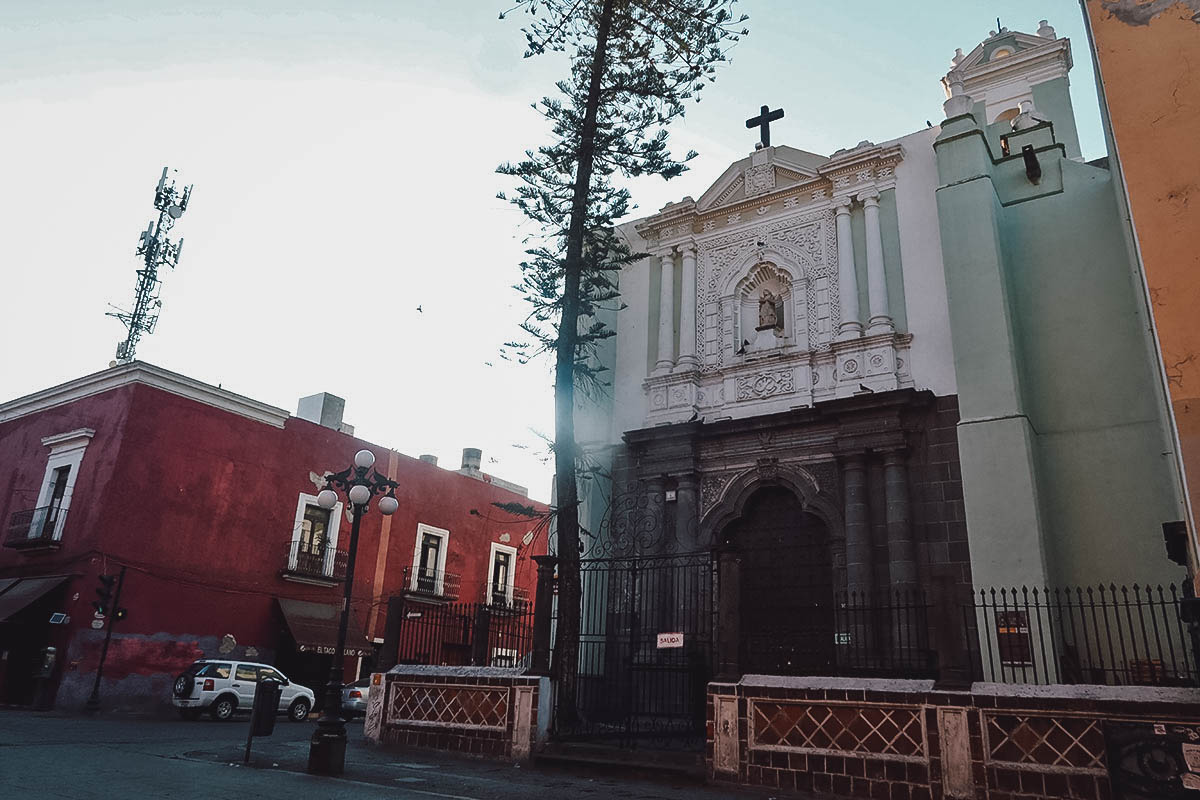
Inside the church are neoclassical altars dedicated to Our Lady of Light, St. Francis of Assisi, the Immaculate Conception, Our Lady of Perpetual Help, Ecce Homo, and St. Joseph and St. Colette.
This church is also home to a famous painting known as “The Christ of the Jew”. According to the church’s description, it was confiscated from Diego de Alvarado, a Mexican Crypto-Jew who was accused by The Inquisition of “folding the canvas and using it as a cushion to sit on”.
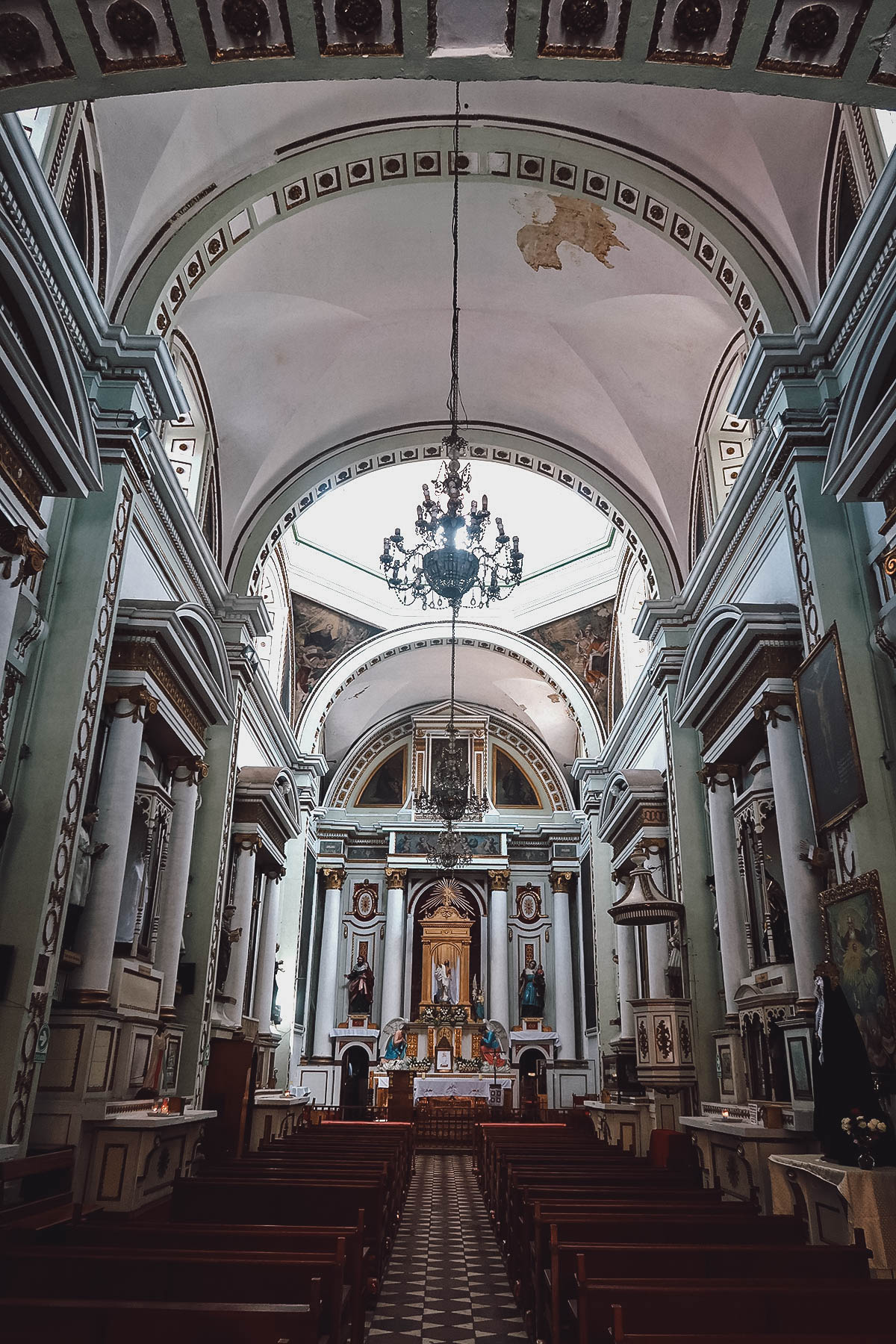
Convento de Clarisas Capuchinas Franciscanas de San Francisco de Asís
Address: C. 16 de Septiembre, Centro histórico de Puebla, 72000 Puebla, Pue.
26. Templo de Santa Monica (Señor de las Maravillas)
Señor de las Maravillas refers to a famous image located inside the Church of Santa Monica. It’s the most revered religious statue in Puebla and used as the main image in the Good Friday procession.
In Spanish, maravillas can mean either “wonders” or “marigolds”. It makes more sense to assume that Señor de las Maravillas translates to “Lord of Wonders”, but after learning of the image’s history, I’m pretty sure it means “Lord of Marigolds”. Keep reading to understand why.

There was a line of people praying in front of the image so I didn’t want to be rude and take a picture. Luckily, I found the one below on Wikipedia. There’s an interesting story behind this image.
According to legend, a woman came everyday to visit her husband who was imprisoned in San Juan de Dios, in front of the Santa Monica Convent. During her daily visits, she noticed a man who never received any visitors. She felt pity for him so she decided to secretly visit him as well after seeing her husband.
After her husband was released, she continued to visit the man and bring him a basket of food. Her husband became suspicious that she was having an affair so he intercepted her. On that day, she was bringing a basket of marigolds (maravillas) to the inmate.
The woman confessed to her husband and together they went to the prison but couldn’t find any trace of the man. They concluded that the inmate must have been Christ sent to test their love.
Before then, this image of Christ was referred to as Señor del Rayo (Lord of Lightning) or Señor de la Caída (Lord of the Fall), but it was later given the name Señor de las Maravillas.
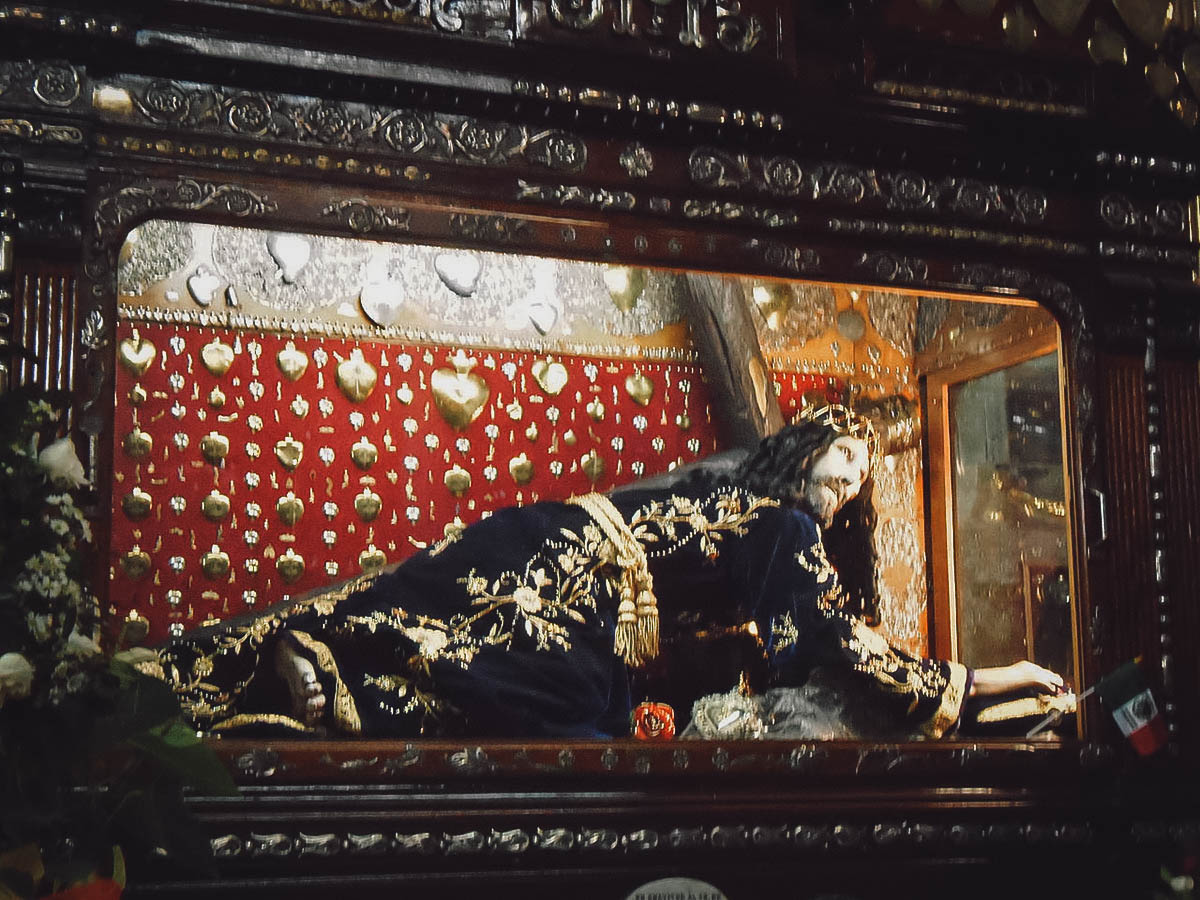
Photo by Patricia Alzuarte Díaz, CC BY-SA 3.0, via Wikimedia Commons / Processed in Photoshop and Lightroom
The image is located behind me in this picture, on the opposite end of the church.
If you like religious art, then you need to visit the Museo de Arte Religioso de Santa Mónica as well. Located just around the corner from this church, it houses one of the biggest and most important collections of religious art in Mexico.
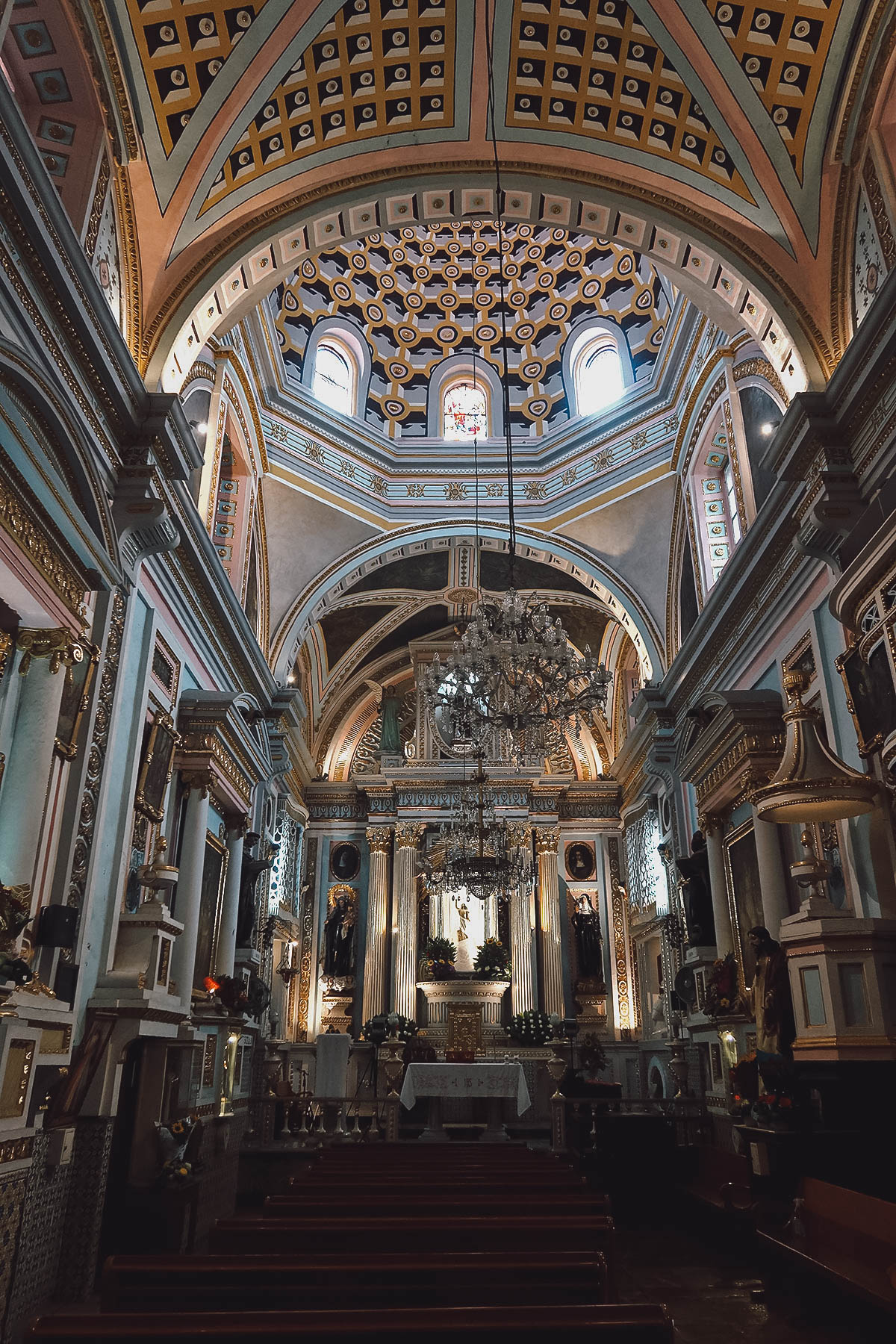
Templo de Santa Monica (Señor de las Maravillas)
Address: Av 18 Ote #2, Centro, 72089 Puebla, Pue.
25. Parroquia Santiago Apóstol
Parroquia Santiago Apóstol is a lovely church located right next to Santiago Park in Barrio de Santiago. It’s about 1.3 miles (2.1 km) southwest of the zocalo. If you plan on walking to Iglesia del Cielo (#28), then you can make a stop here along the way.
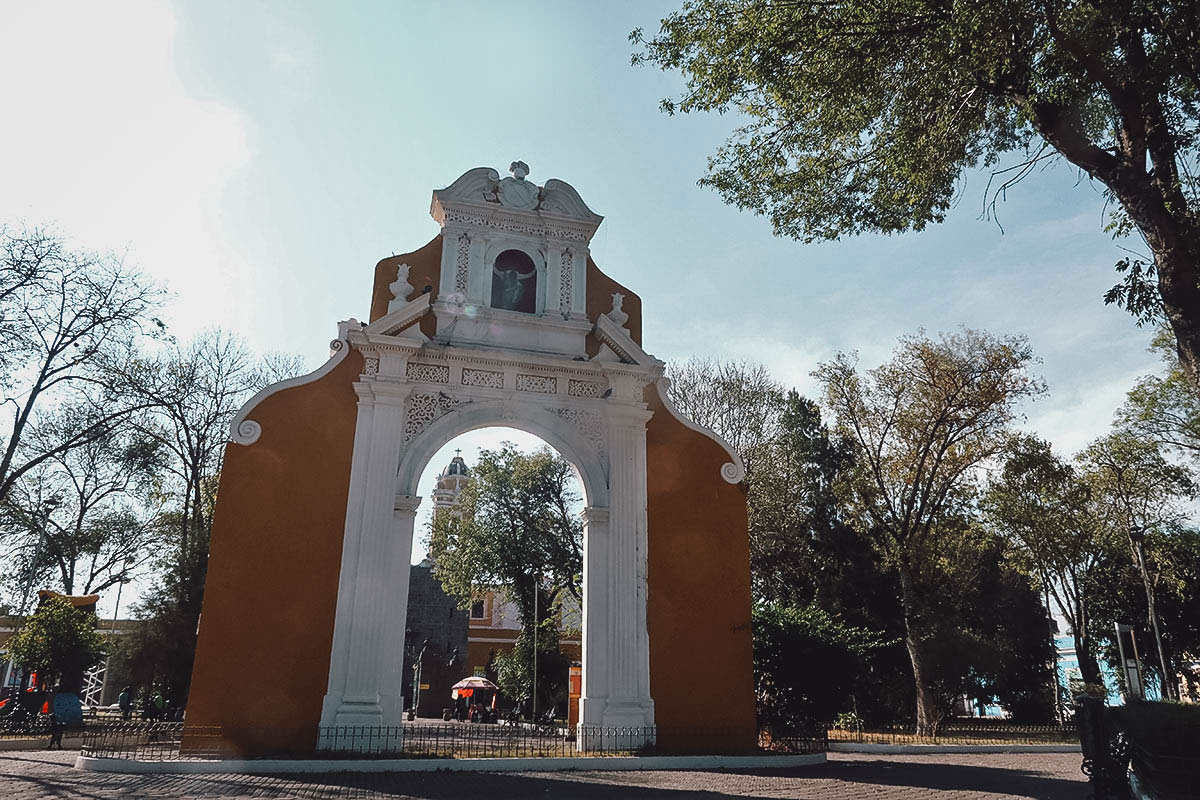
I visited the church early in the morning and there were plenty of vendors just outside the main gate. It’s a lovely park and a great place to just sit and while away the time.
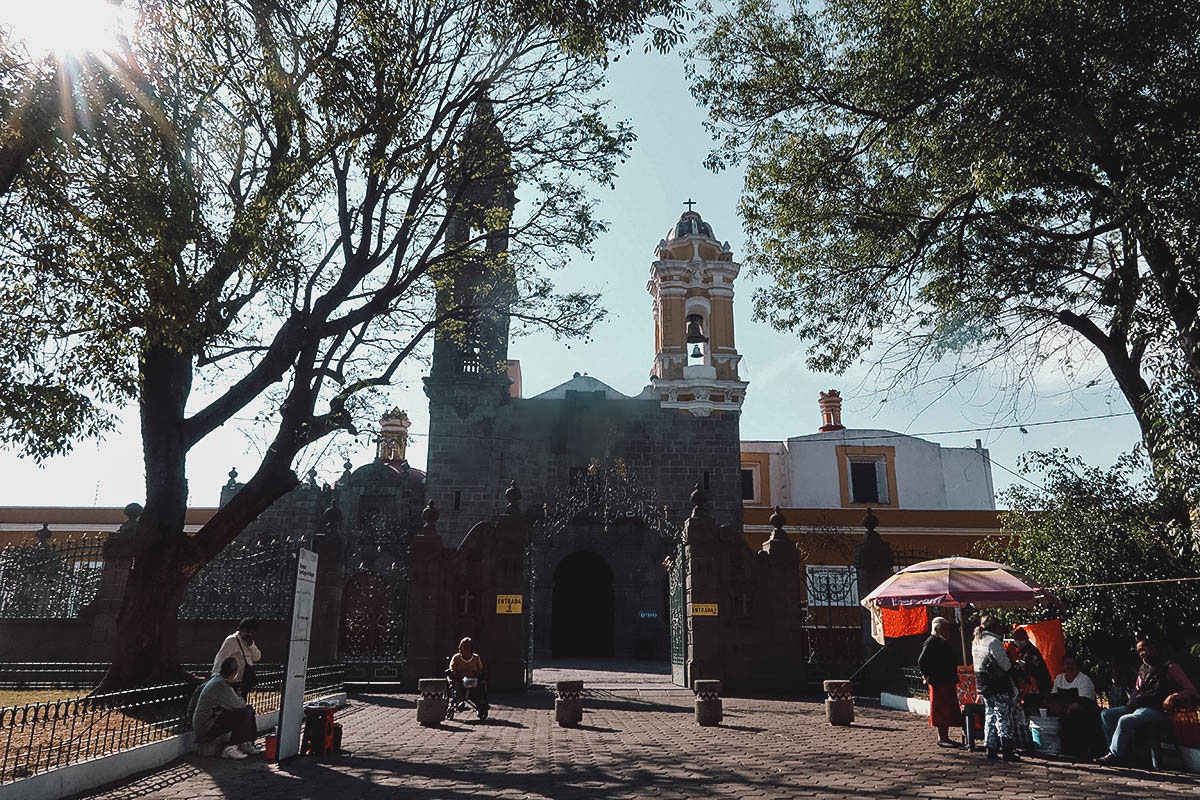
A good amount of gold leaf adorns the insides of the church. The altars at Parroquia Santiago Apóstol are dedicated to James the Pilgrim, The Crucified Christ, and Our Lady of Fatima and St. Sebastian, among others.

Parroquia Santiago Apóstol
Address: C. 15 Sur 1704, Barrio de Santiago, 72580 Puebla, Pue.
24. Iglesia de San Agustín
Iglesia de San Agustín is an impressive church that dates back to the mid-16th century. Construction of the church began in 1555 but due to its size, it wasn’t completed until 1612.
The version of the church you see today has undergone significant reconstruction. Originally built in the Baroque style, much of the church was damaged in the Siege of Puebla in 1863 and in earthquakes in 1874 and 1999.
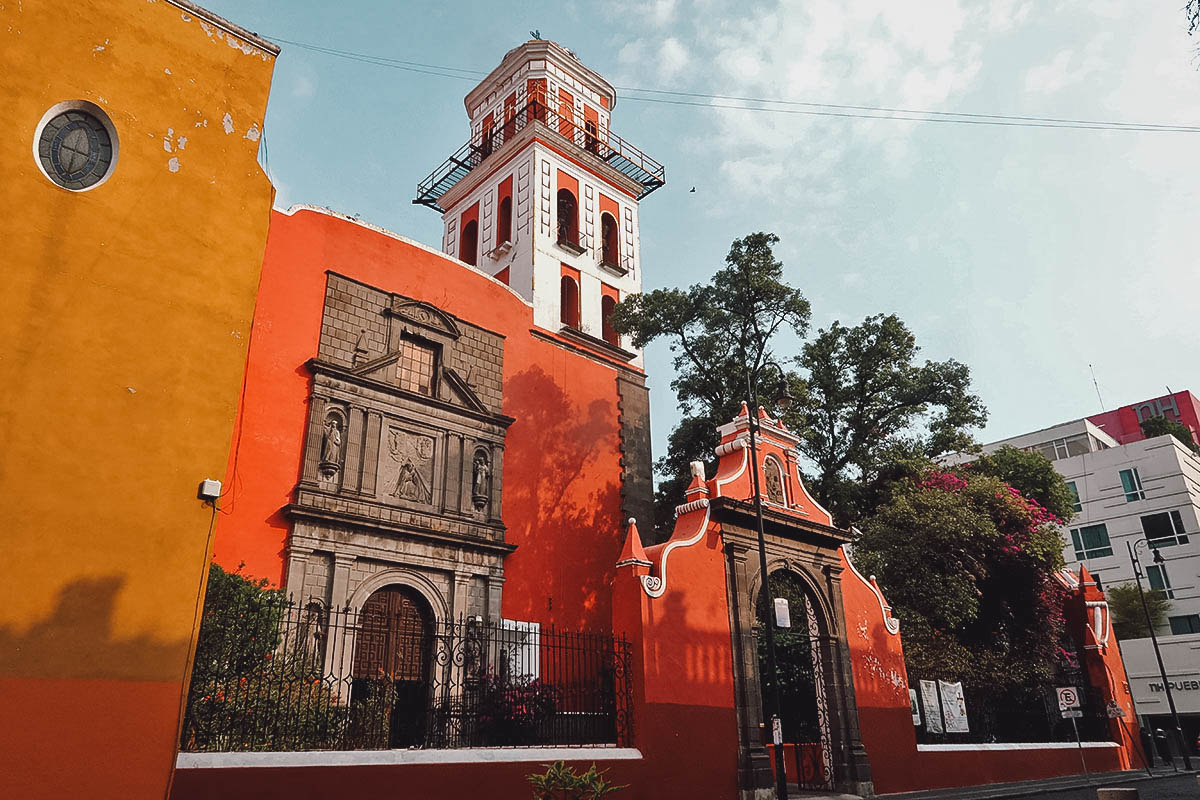
The interior of Iglesia de San Agustín is simpler and more subdued than most of the other churches on this list.
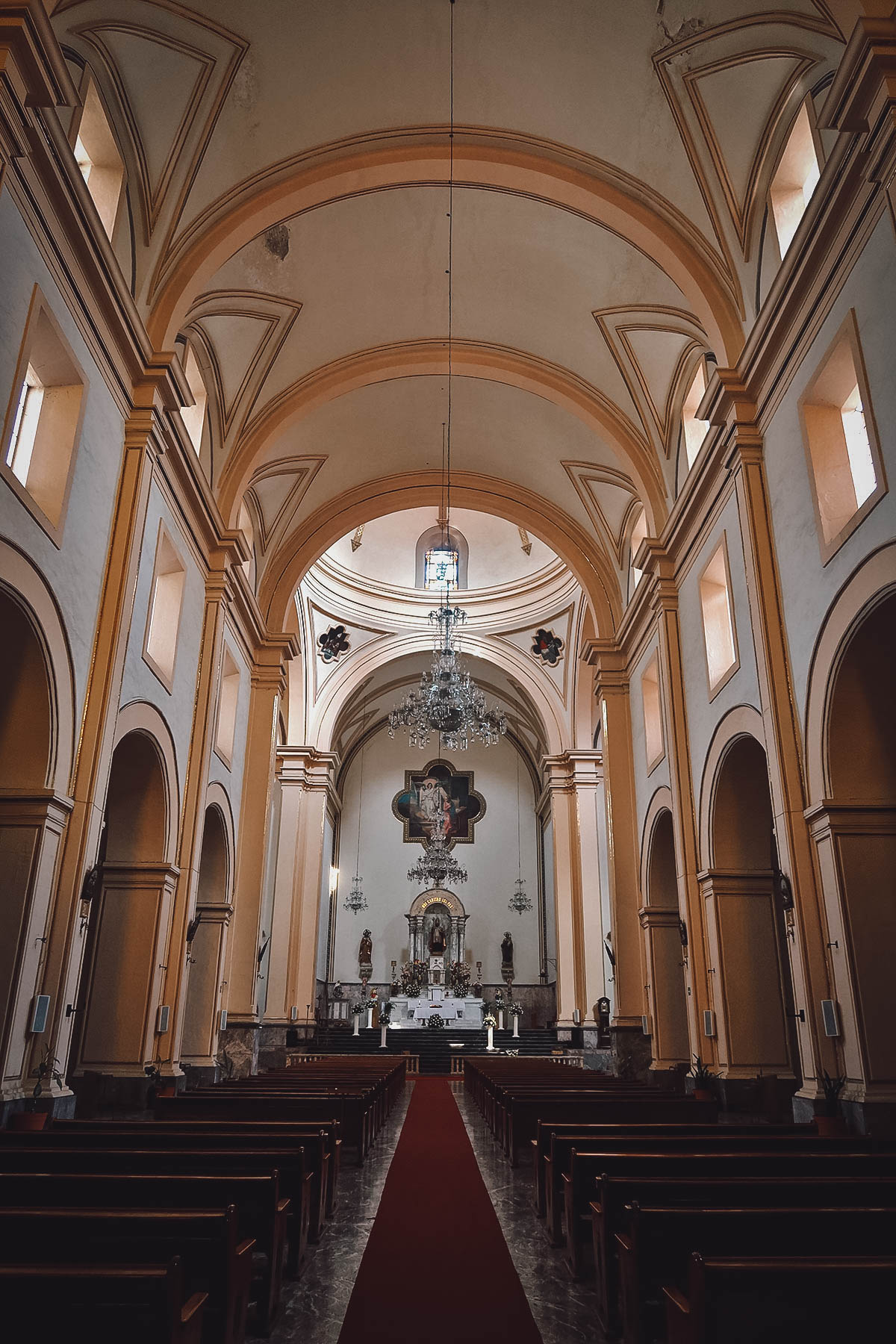
Iglesia de San Agustín
Address: Av 3 Pte 505, Centro histórico de Puebla, 72000 Puebla, Pue.
23. Templo del Ex-Hospital de San Roque
Built in 1672, the Temple of San Roque once served as a church, convent, and hospital, hence the name. It gave shelter to convalescent patients who arrived on Spanish ships at the Port of San Juan de Ulúa.
For many years, it also served as a hospital for the mentally ill before being converted in recent years to the Handicraft Center of the State of Puebla.
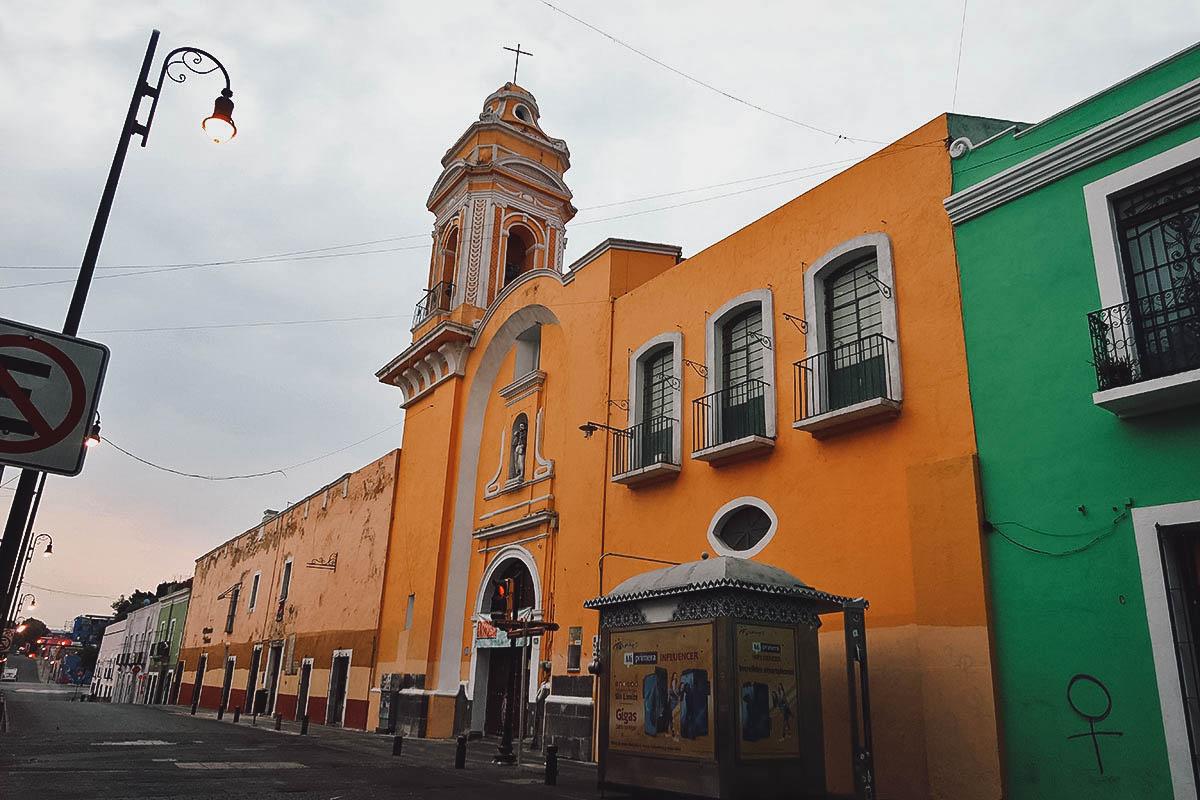
This church is only open for a few hours each day, from 9AM until noon and 4-5:30PM on Tuesdays to Saturdays. On Sundays, it’s open from 9:30AM until noon and 4-5:45PM. Like most churches in Puebla, it’s closed on Mondays.
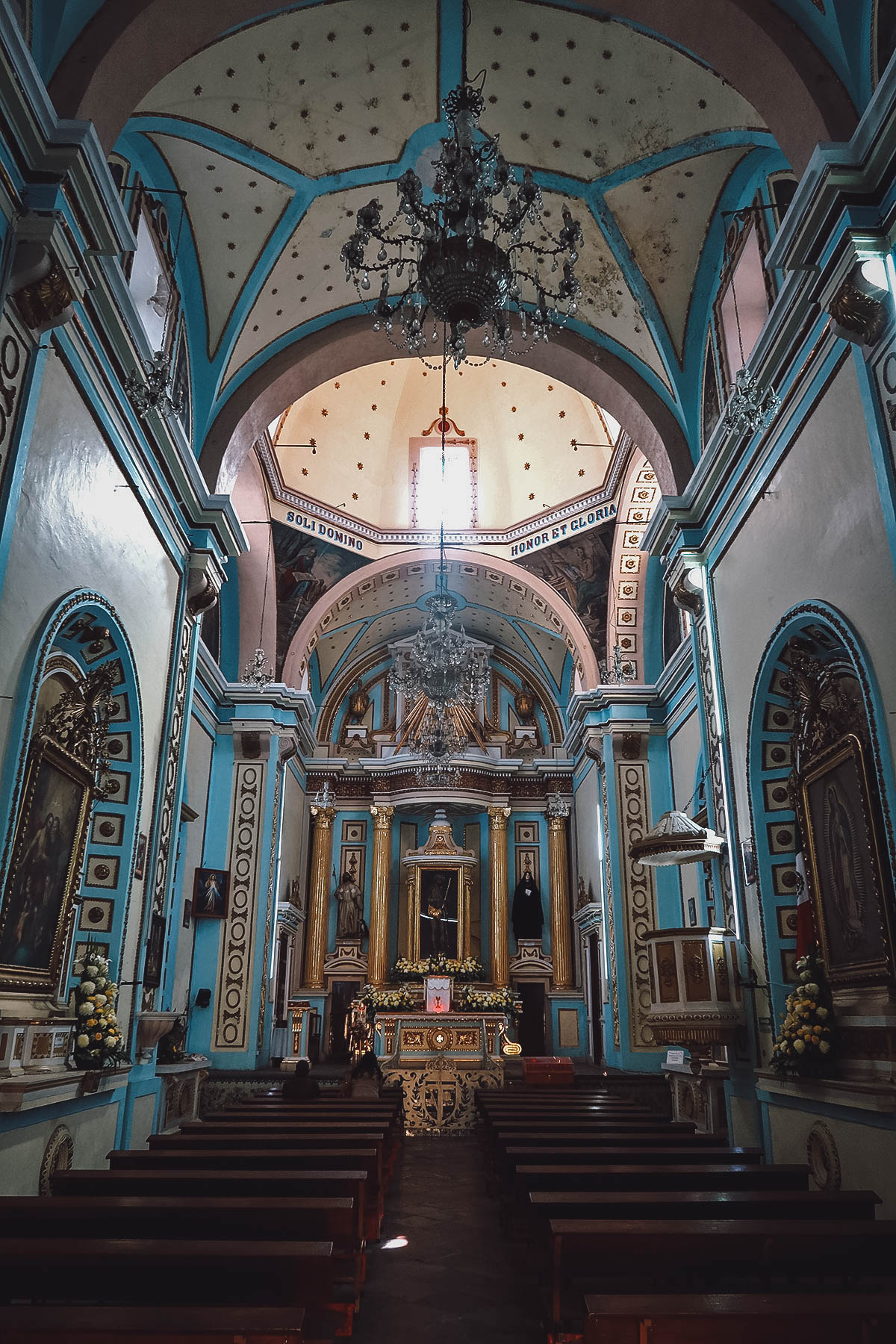
Templo del Ex-Hospital de San Roque
Address: Av. Don Juan de Palafox y. Mendoza 605, Centro histórico de Puebla, 72000 Puebla, Pue.
22. Templo del Ex-Hospital de San Pedro
Like the previous church on this list, the Temple of San Pedro once served the hospital located right next to it – the Hospital of San Pedro. There isn’t much information about this church but both the hospital and the church may have been constructed and completed at the same time, around the turn of the 16th century.
According to the description on the church’s wall, the Temple of San Pedro “fulfilled the spiritual needs of the adjoining hospital.”
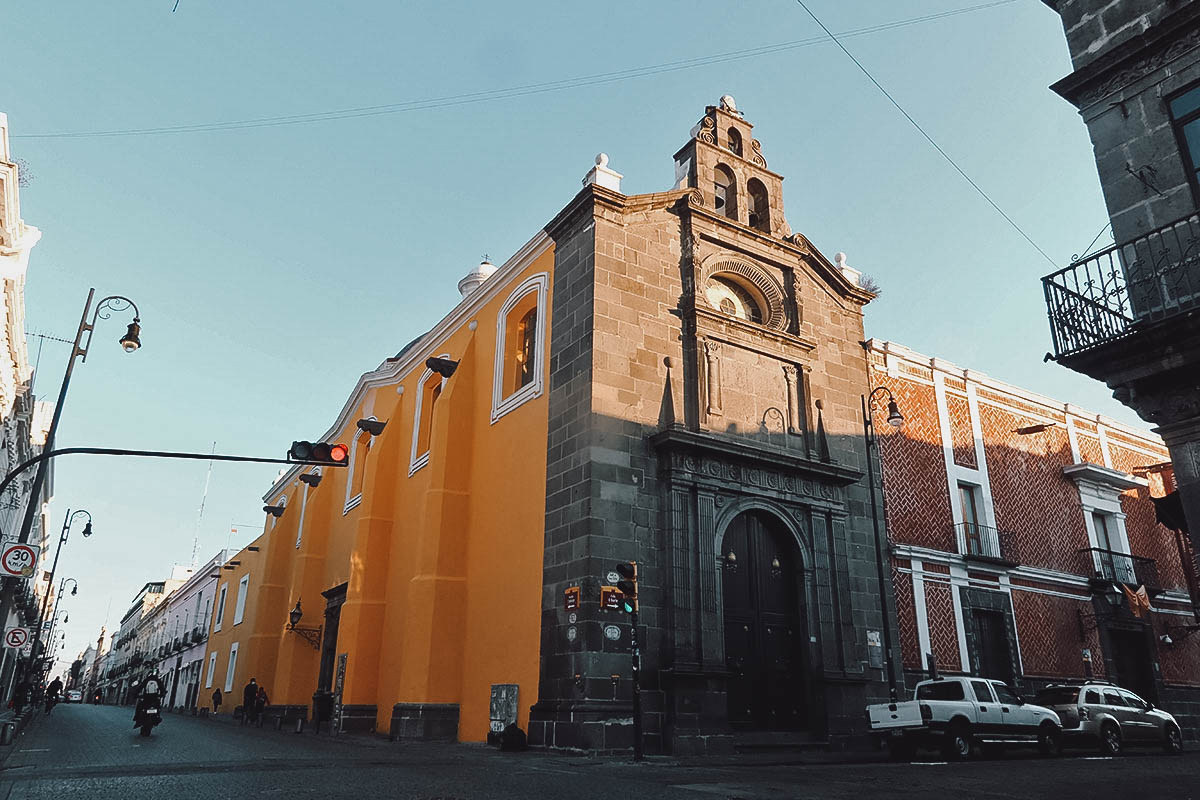
Inside the nave are several large paintings, some of which date back to the early 19th century. You’ll also find a few sacred objects, one of the most notable being an homage to the Franciscan saint – San Antonio de Padua.
On his feast day (June 13), people searching for a life partner can write their wishes on three sheets of paper. They tie them together with red ribbon and leave them by the saint’s image, hoping that their wishes be fulfilled.

Templo del Ex-Hospital de San Pedro
Address: Calle 4 Norte, Av 2 Ote y, Centro histórico de Puebla, 72000 Puebla, Pue.
21. Iglesia de Santa Inés
Iglesia de Santa Inés is a small but lovely church located in colorful Barrio de Xanenetla. It was built in 1776 and has served as a shelter for children and people with disabilities since the 1970s.
Barrio de Xanenetla was once considered a rough neighborhood in Puebla. It’s since been transformed and is now known for its many colorful and elaborate murals. If you like street art, then this is one of the best areas you can visit in Puebla. Many of the murals here are spectacular.
With that said, Xanenetla did have a reputation for being a dodgy neighborhood at one point. You can refer to this Tripadvisor thread for more information.
Personally, I’ve never felt unsafe in Xanenetla when visiting during the day. If you’d like to visit this church and neighborhood, then you’ll need to proceed at your own risk.
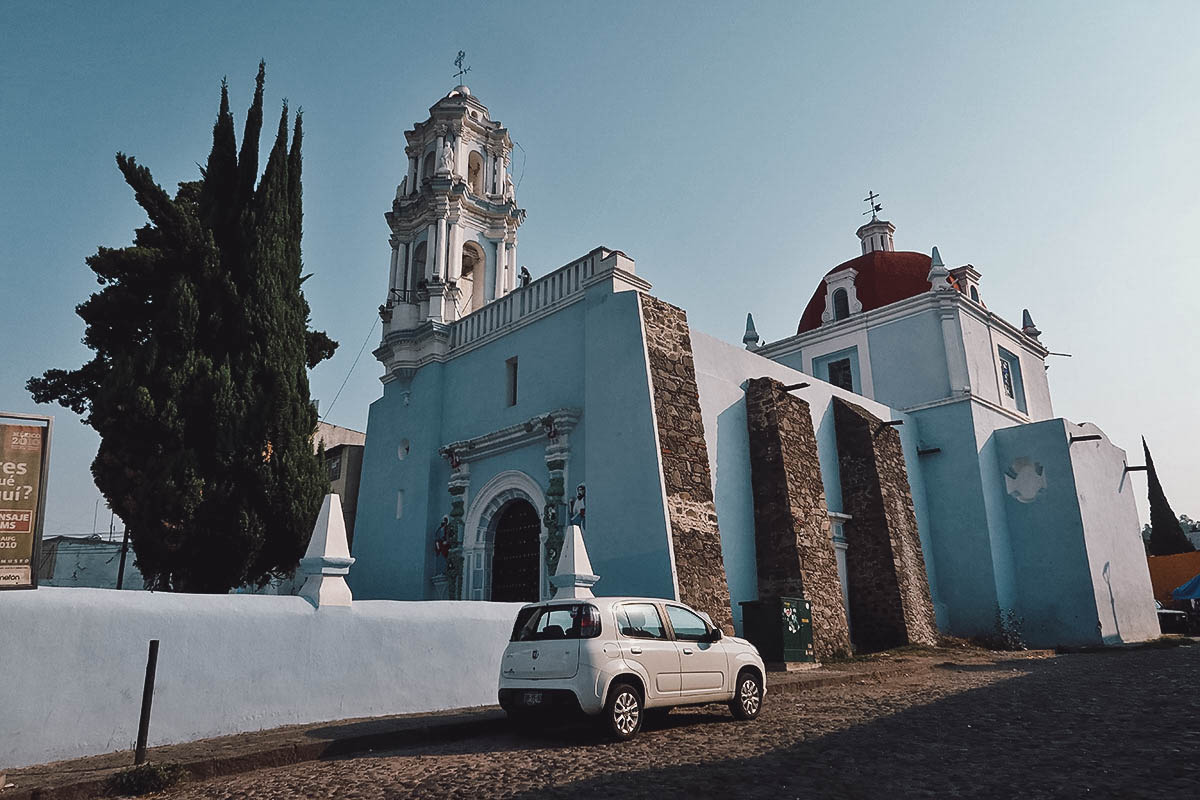
Iglesia de Santa Inés
Address: Esquina Del Chirimoyo, Plazuela Santa Inés 3017, Xanenetla, 72290 Puebla, Pue.
20. Parroquia del Sagrado Corazón de Jesús
Parroquia del Sagrado Corazón de Jesús is a large church located in the northwestern portion of the Historic Center. Unfortunately, there isn’t much information about it online but it is a lovely church that you may want to visit if you venture into this part of town. It’s located about a 10-minute walk west of Mercado 5 de Mayo.
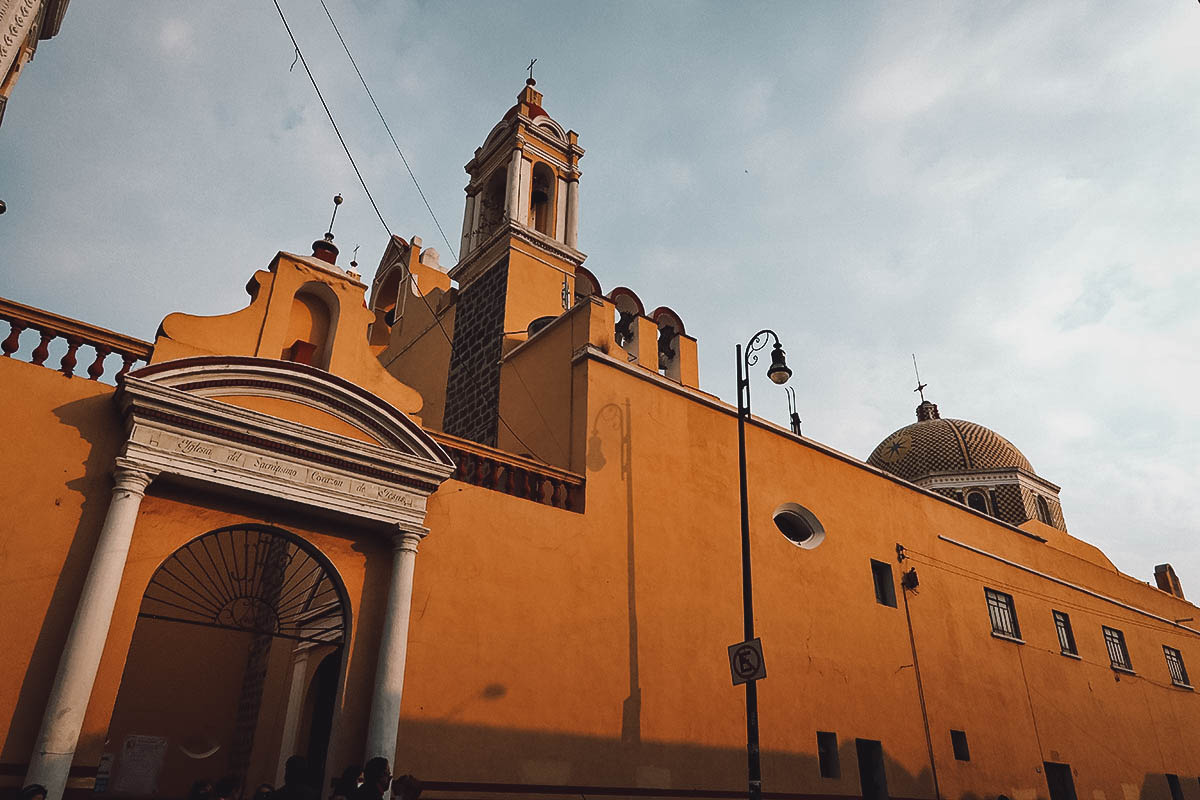
You may or may not know this, but in some Catholic countries, people often make three wishes when entering a church for the first time. Keep that in mind when you visit these churches in Puebla.
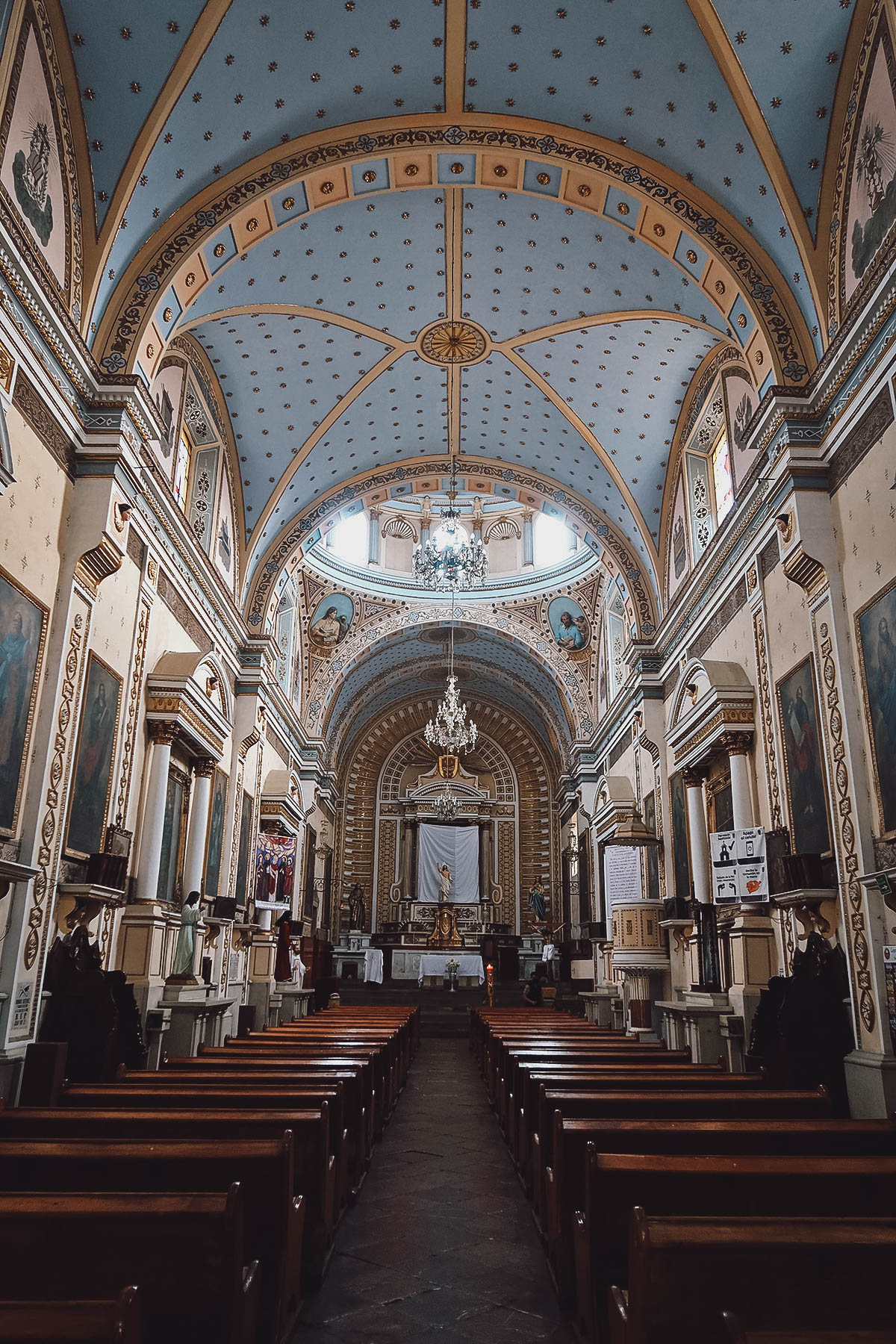
Parroquia del Sagrado Corazón de Jesús
Address: Calle 9 Nte, San Pablo de los Frailes, 72090 Puebla, Pue.
19. Templo Conventual de San Jerónimo
Built in the 17th century, the Conventual Church of St. Jerome is a neoclassical church and convent dedicated to Jerónimo de Estridón.
Interestingly, a physician was commissioned by the authorities of this convent in the 18th century to do a study on nuns who were suffering from continuous epileptic seizures. Though the doctor’s results were deemed inconclusive, his findings became the first manual for scientifically treating this disease.
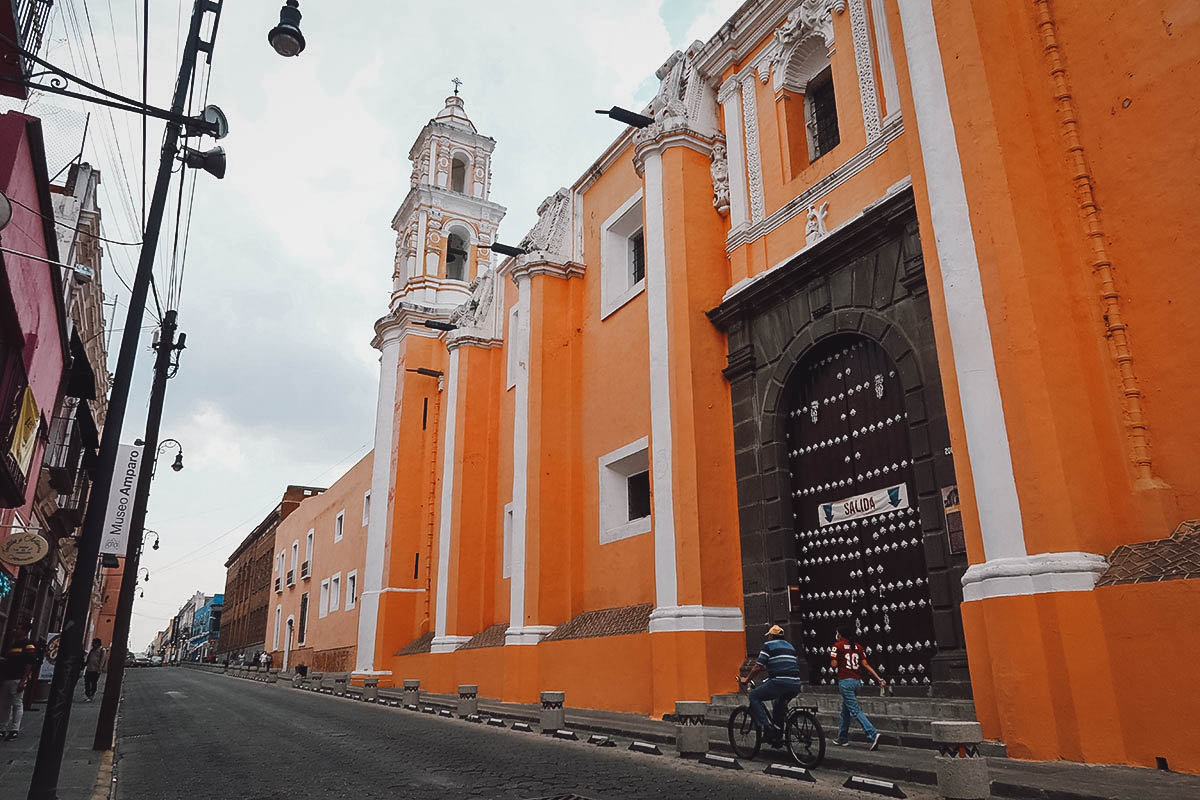
The Conventual Church of St. Jerome is located just a few blocks from the zocalo. It’s one of the easiest churches to get to but unfortunately, it isn’t the easiest to enter. Like the Parish of Santa Clara (#30), I’ve only seen it open for 9AM mass on Sundays.
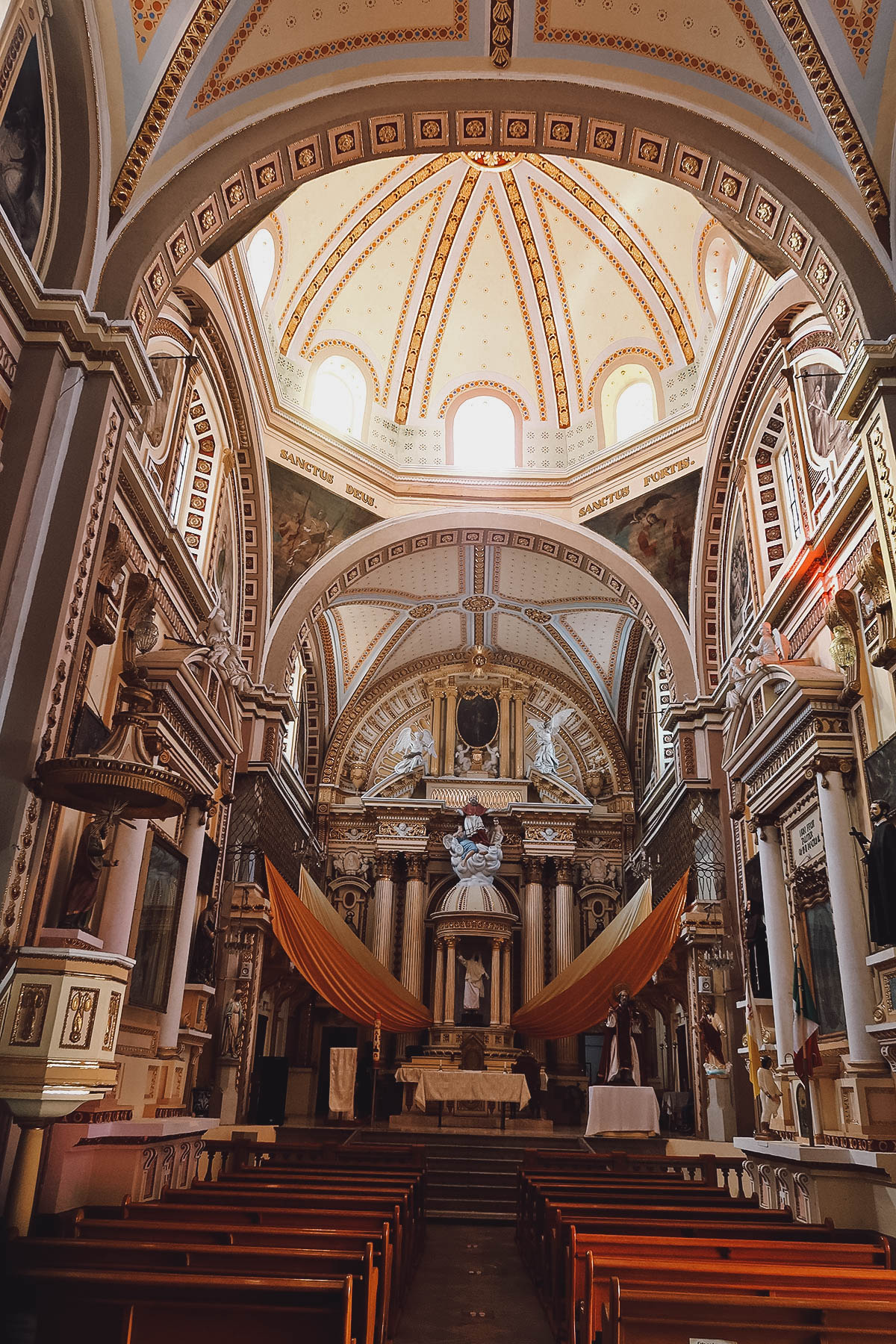
Templo Conventual de San Jerónimo
Address: Esq Calle 4 Sur, Av 7 Ote 206, Centro Histórico, Centro histórico de Puebla, 72000 Puebla, Pue.
18. Templo Conventual de la Limpia Concepción de Nuestra Señora
The Immaculate Conception Church was built in 1596 for the nuns of an adjoining convent of the same name. They belonged to the religious order of the Immaculate Conception, one of the best known in the city at that time.
One of the most famous nuns who lived in the convent was María de Jesús de Tomelín y del Campo. Also known as El Lirio de Puebla (The Lily of Puebla), she was a miracle worker and mystic who’s now in the process of being canonized and beatified.
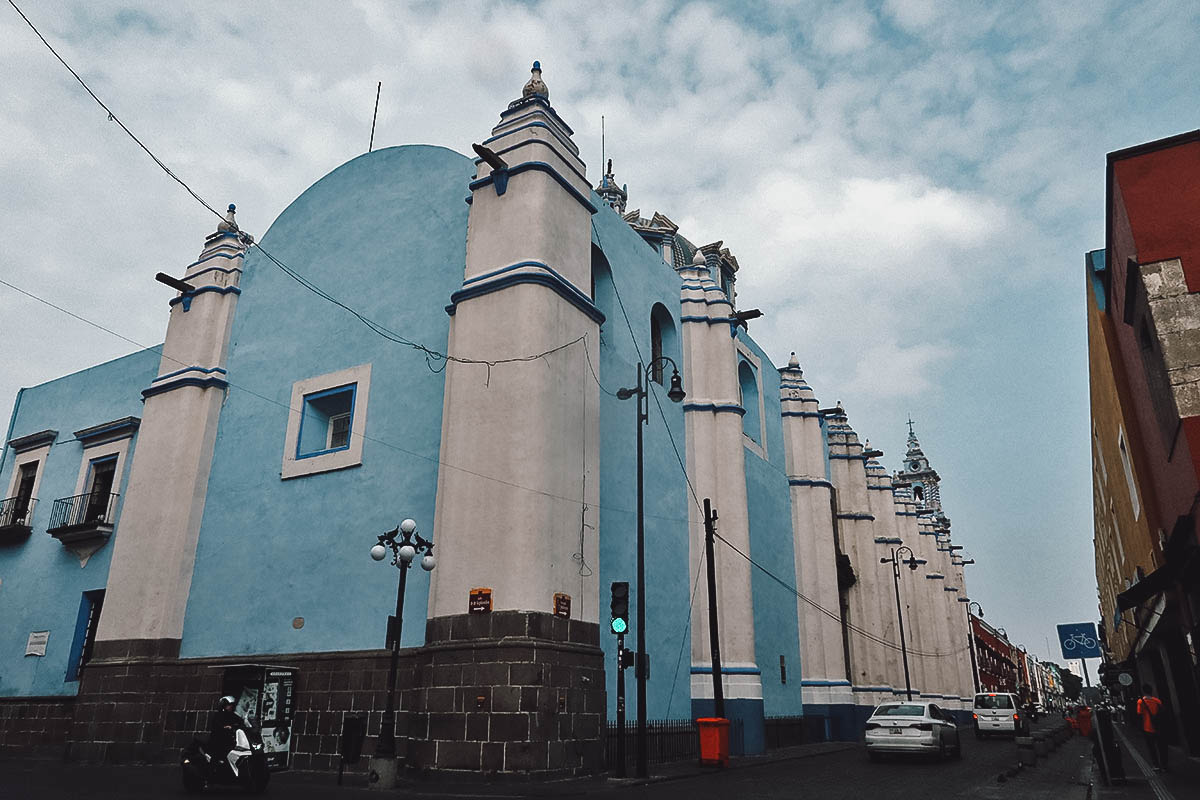
The interior of the Immaculate Conception Church was initially decorated in the Baroque style but it underwent a neoclassical transformation sometime in the 19th century.
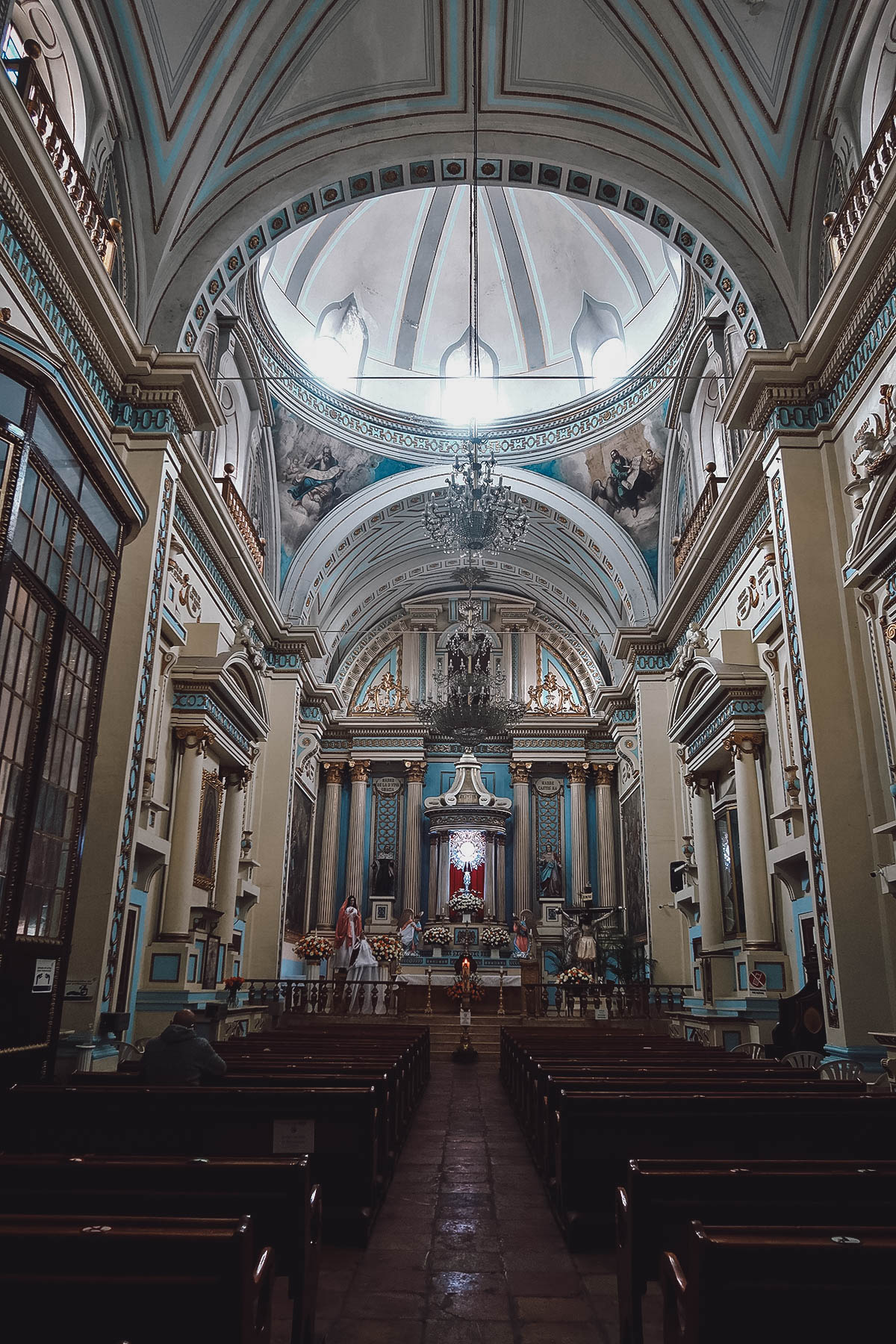
Templo Conventual de la Limpia Concepción de Nuestra Señora
Address: Esq. 16 Semptiembre, Av 7 Pte 701, Centro histórico de Puebla, 72000 Puebla, Pue.
17. Iglesia de San Cristóbal
Built in 1687, the Church of San Cristobal is a Baroque church dedicated to the Immaculate Conception of Mary and to St. Christopher. It’s renowned for its two towers with intricate filigree designs.
The original towers were destroyed in a siege in 1856 but reconstructed over a hundred years later.
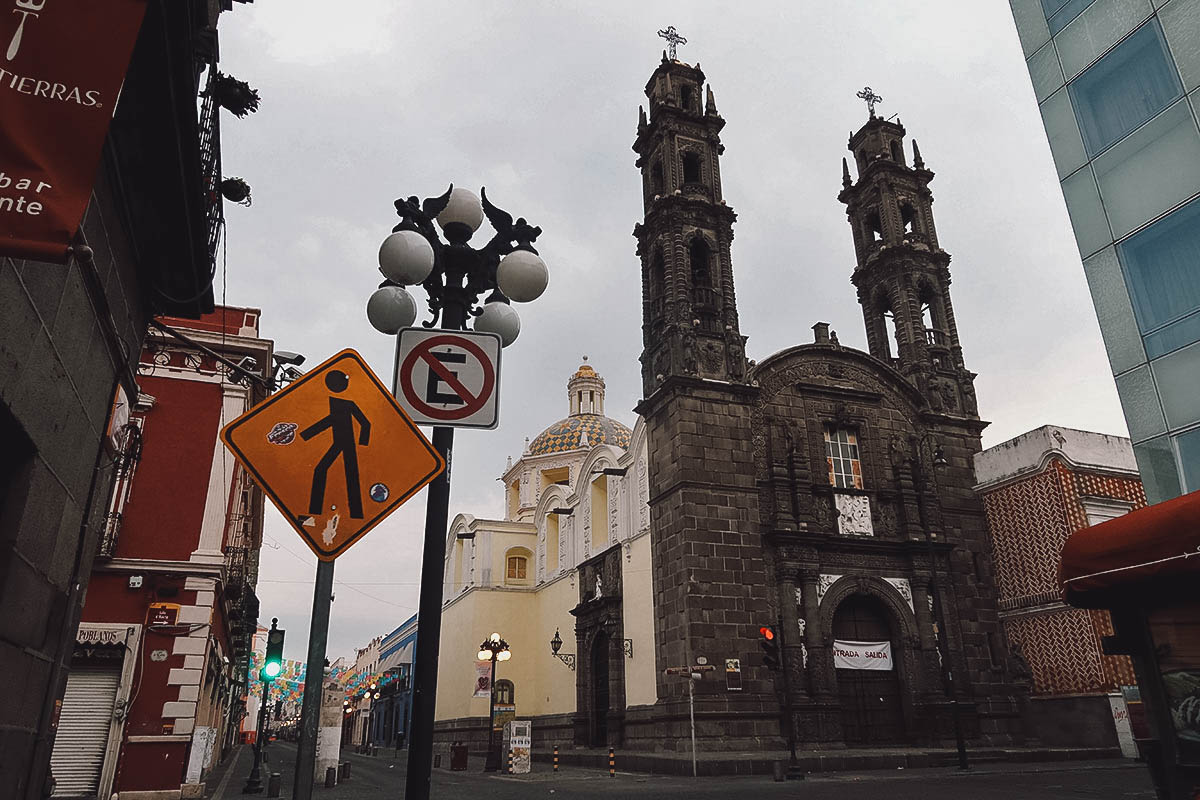
The interior of San Cristobal Church is known for its many images featuring the Blessed Virgin Mary.
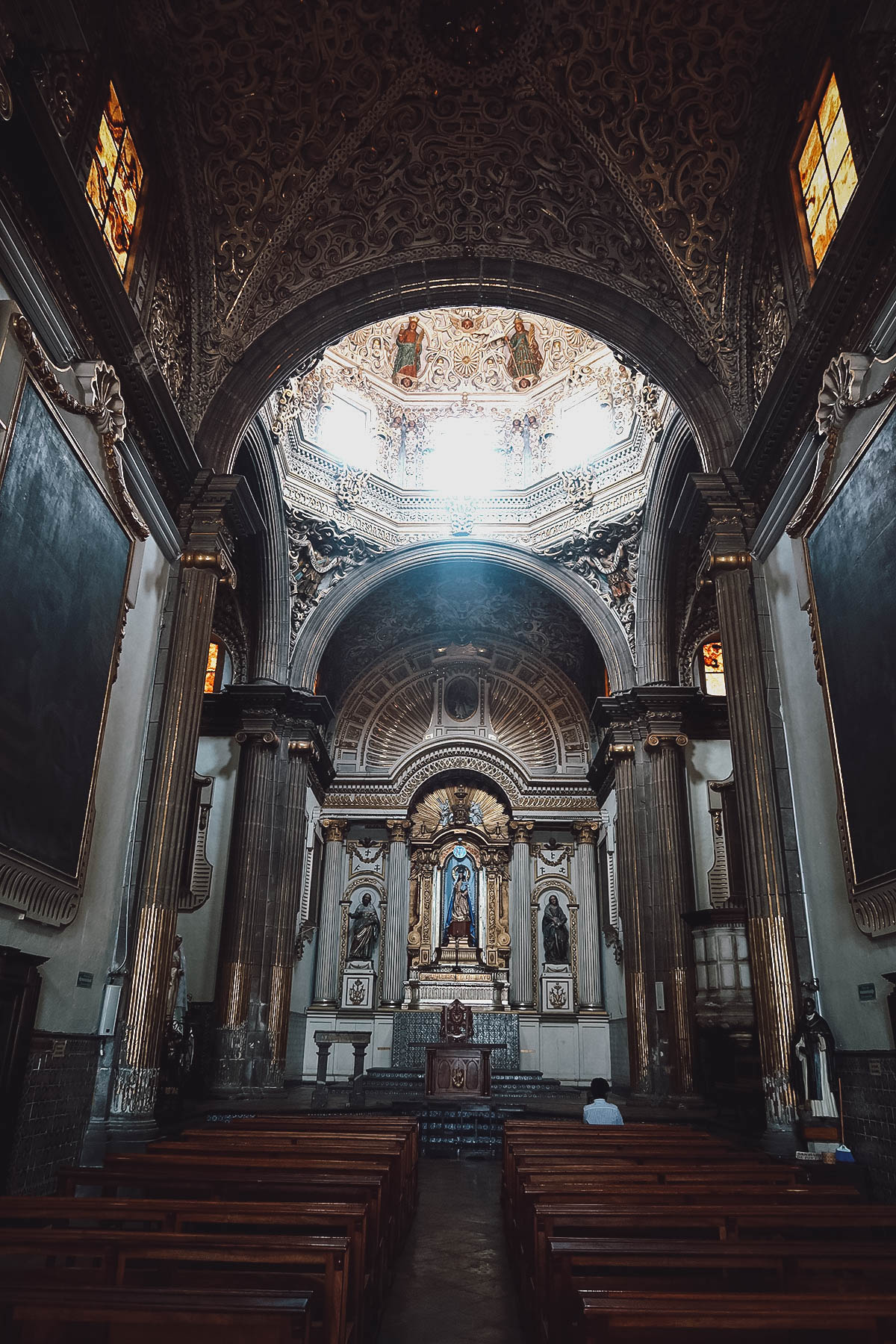
Iglesia de San Cristóbal
Address: Calle 4 Norte, Av 6 Ote esquina, Centro histórico de Puebla, 72000 Puebla, Pue.
16. Templo San Felipe Neri La Concordia
El Templo San Felipe Neri La Concordia is one of the oldest churches in Puebla. It was built in the 16th century and served briefly as the city’s provisional cathedral when the first Basilica Cathedral was undergoing repairs in 1556.

According to the church’s description, it once served as a retreat house for clergymen who were trying to patch up disagreements. It’s for this reason why the church became known as La Concordia (The Concord).
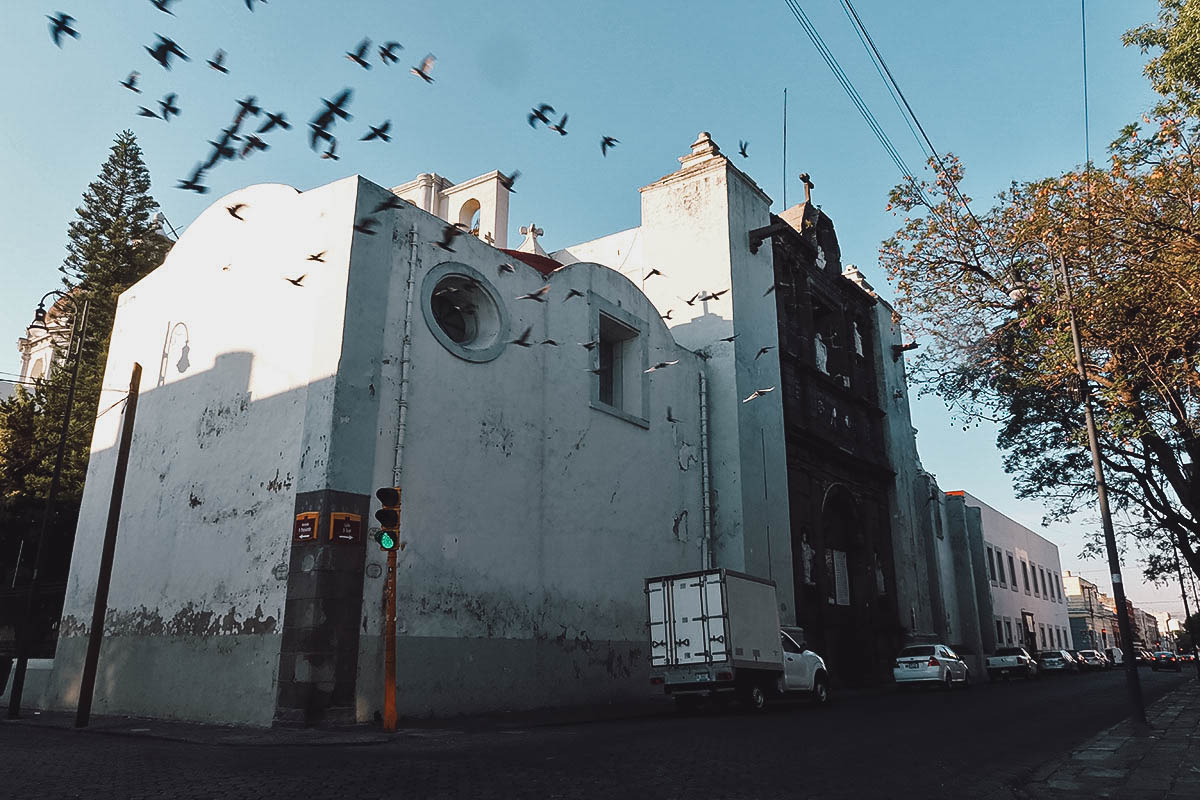
The interior of the church was originally decorated in the Baroque style but it’s since been transformed to neoclassical.
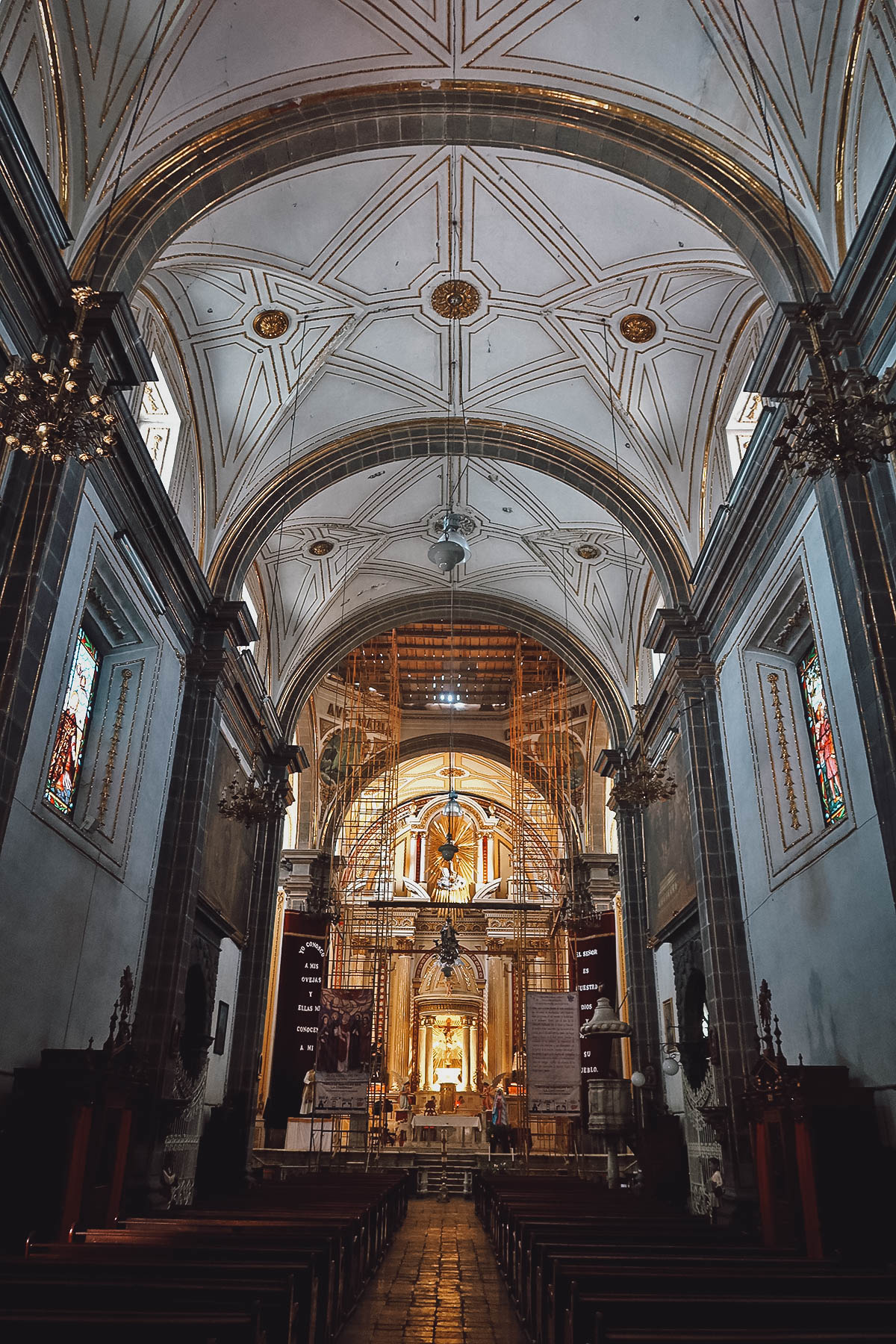
Templo San Felipe Neri La Concordia
Address: Calle 3 Sur S/N, Centro histórico de Puebla, 72000 Puebla, Pue.
RELATED ARTICLE: Discover 20 Awesome Things to Do in Puebla, Mexico
15. Parroquia de Nuestro Señor San José
Like the previous church on this list, Parroquia de Nuestro Señor San Jose is one of the oldest curches in Puebla. It dates back to 1556, just 25 years after the foundation of Puebla.
The Parish of St. Joseph had humble beginnings. It started off small with wooden roofs before being reconstructed and growing over time to the magnificent church that it is today. From the outside, you can’t help but admire its beautiful Poblano brick facade.
According to the church’s history, the city of Puebla faced a serious problem with lightning during its early years. In the hopes of remedying the problem through divine intervention, the city council built this church and chose St. Joseph as the patron saint against lightning.
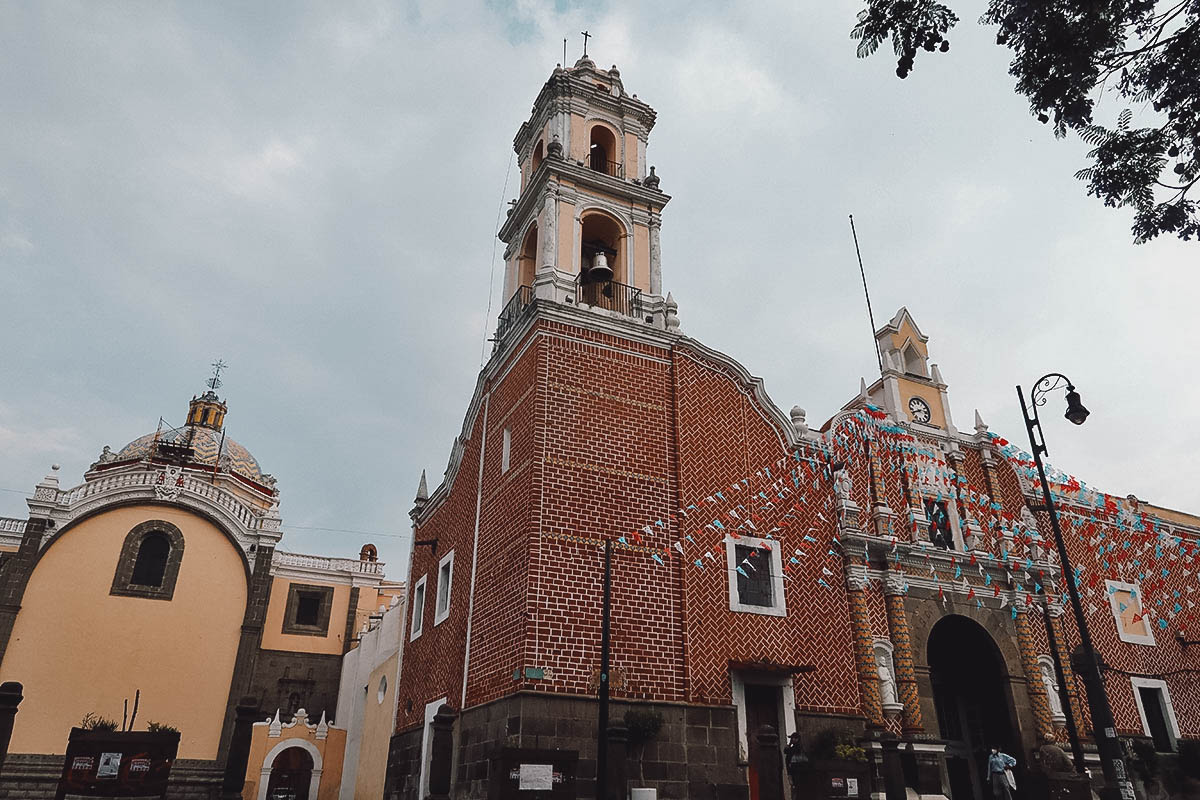
Inside the Parish of St. Joseph are three naves separated by arches. The main altar is neoclassical but the altarpieces are still decorated in the Baroque and Churrigueresque style.
The church is home to a number of sculptures and oil paintings by Novo-Hispanic and 19th-century masters while its sacristy is described as being the most beautiful in Puebla.
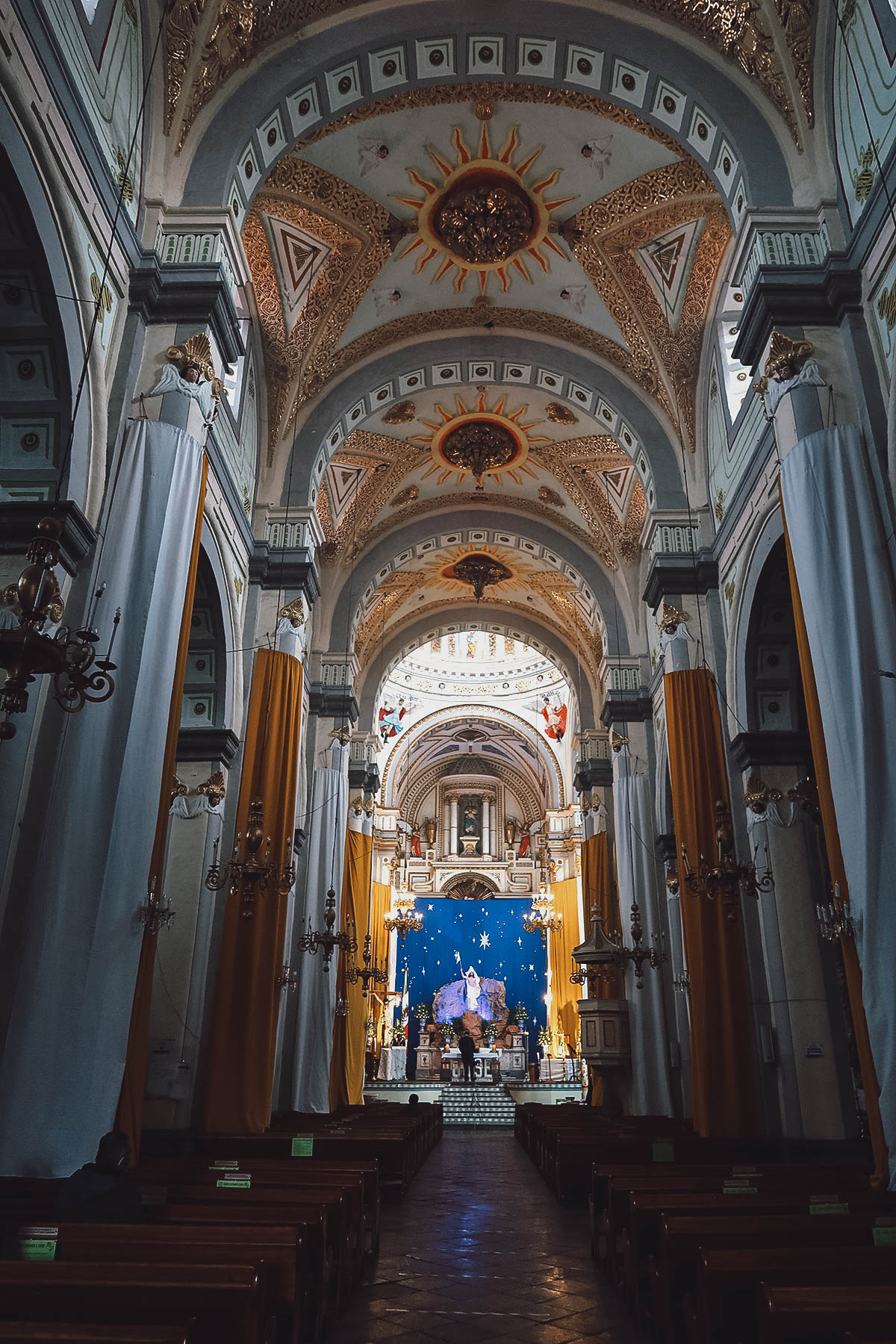
Parroquia de Nuestro Señor San José
Address: Calle 2 Nte No. 1803, Barrio de San Antonio, 72000 Puebla, Pue.
14. Capillas del Via Crucis
You’ve heard of hidden restaurants, but have you heard of a hidden church? That’s how I like to think of Capillas del Via Crucis.
Because even after arriving at the spot where Google Maps says it should be, it still isn’t obvious where it is. You have to turn left, go up a flight of steps and through an arched doorway to find the church. It really does feel like a hidden oasis in Puebla.
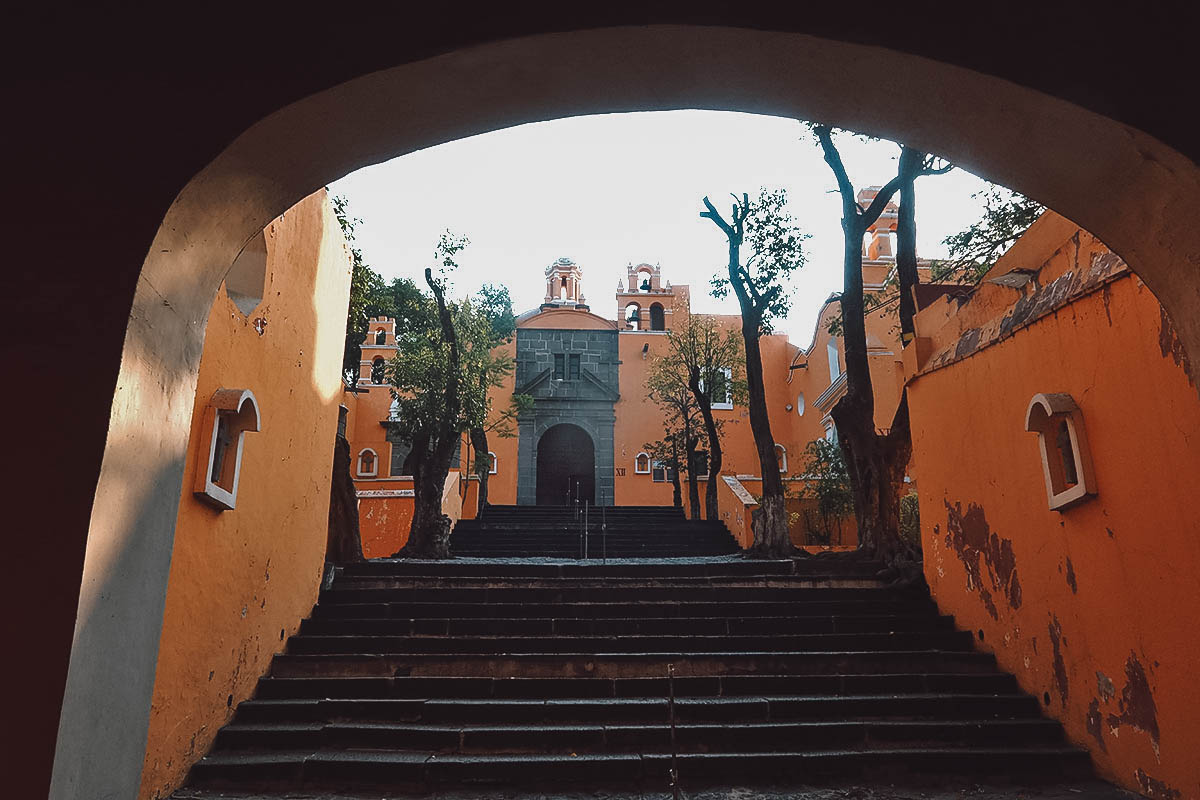
As its name suggests, Capillas del Via Crucis was designed to mimic the Stations of the Cross – a 14-step Catholic devotion that commemorates Jesus Christ’s last day on Earth. It consists of several small buildings going up a hill and to the main chapel at the very top which is dedicated to the moment Jesus was nailed to the cross.
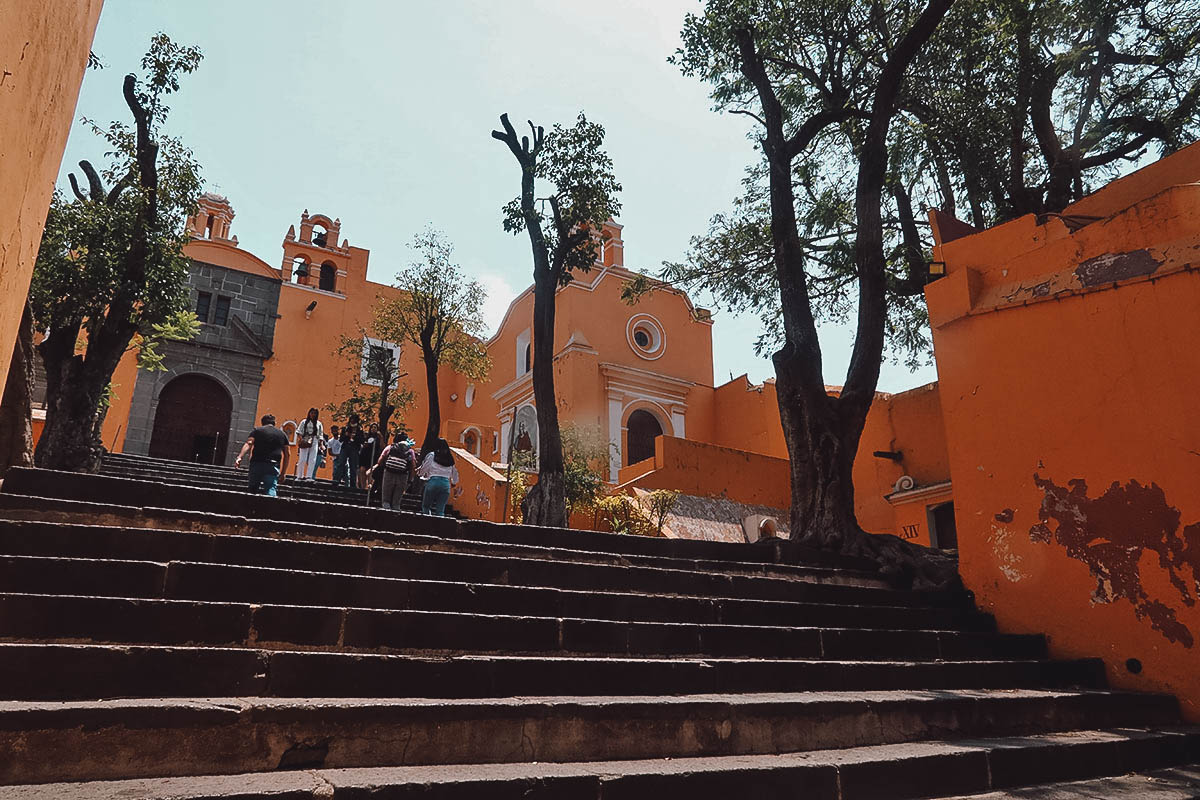
This is what the main chapel looks like. It’s small and much more modest compared to the other churches on this list.

I didn’t go inside every building but I assume most if not all of them houses a different chapel.
Capillas del Via Crucis isn’t as breathtaking as some of the more majestic churches and cathedrals in Puebla but it’s definitely one of the most interesting and unique. It felt very peaceful here.
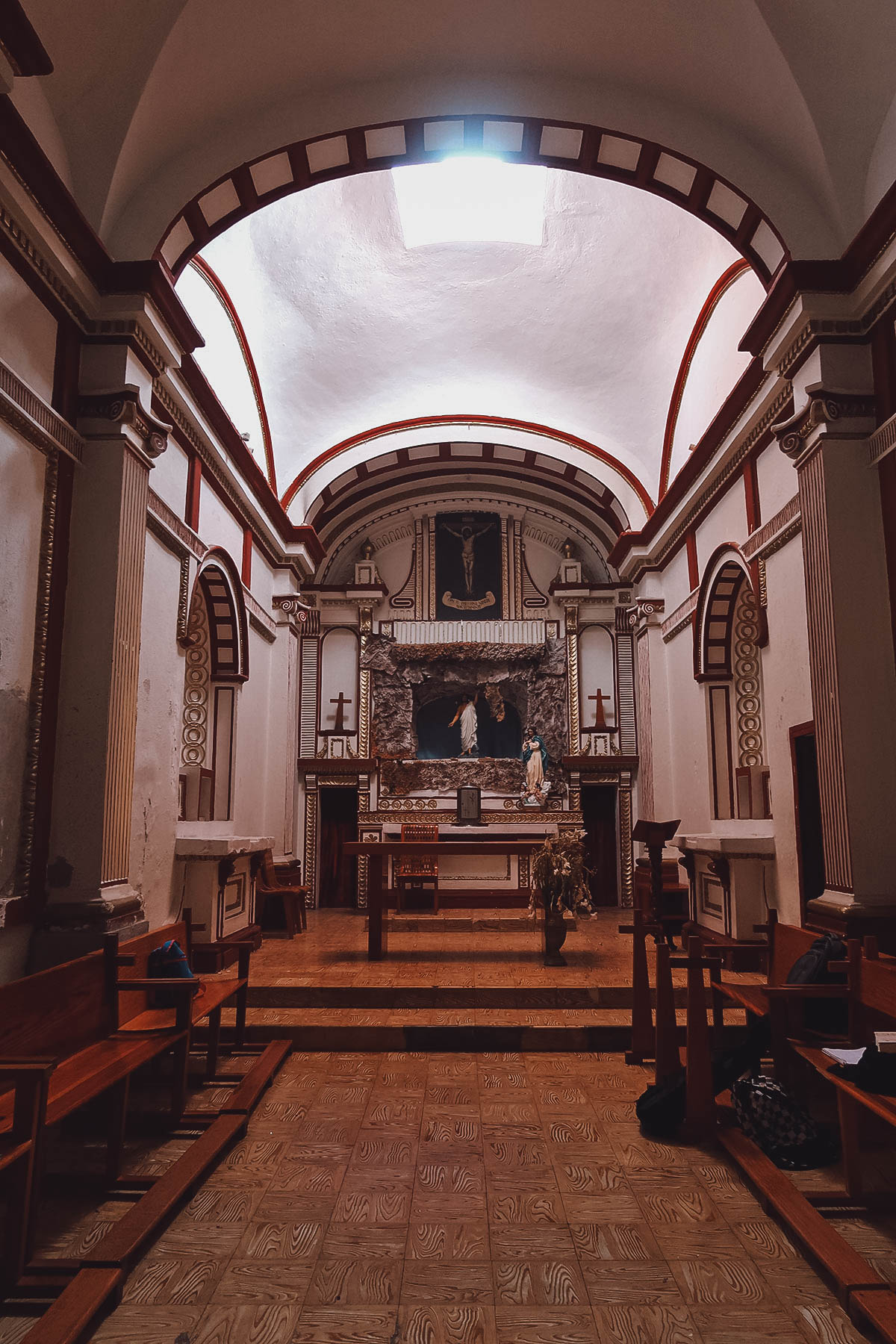
Capillas del Via Crucis
Address: Esquina 22 Oriente, Calz. de los Fuertes, Rincón del Bosque, 72290 Puebla, Pue.
13. Nuestra Señora de los Gozos
If you look closely at the restaurant to the right of this church, you’ll see that it’s called “Deliciuss”. I found that amusing since that’s exactly how Nusetra Señora de los Gozos looked to me – like a delicious birthday cake.
This chapel, dedicated to the Joyful Mysteries of the Rosary, was built in the middle of the 18th century and features a colorful facade that lives up to the church’s name – Our Lady of Joys. How can you walk by this church and not want to go in?
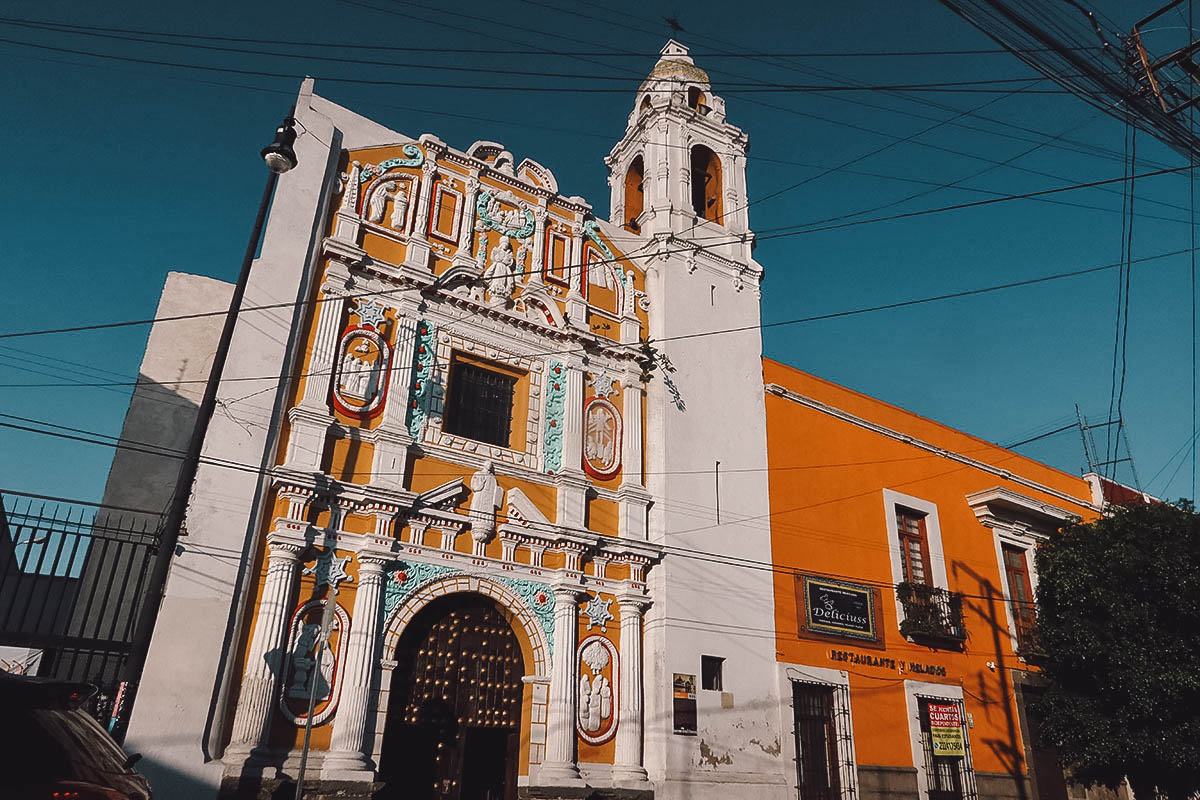
Compared to its eye-catching exterior, the church looks much simpler and more subdued from the inside. It features oval-shaped plastery medallions depicting scenes from the Joyful Mysteries.
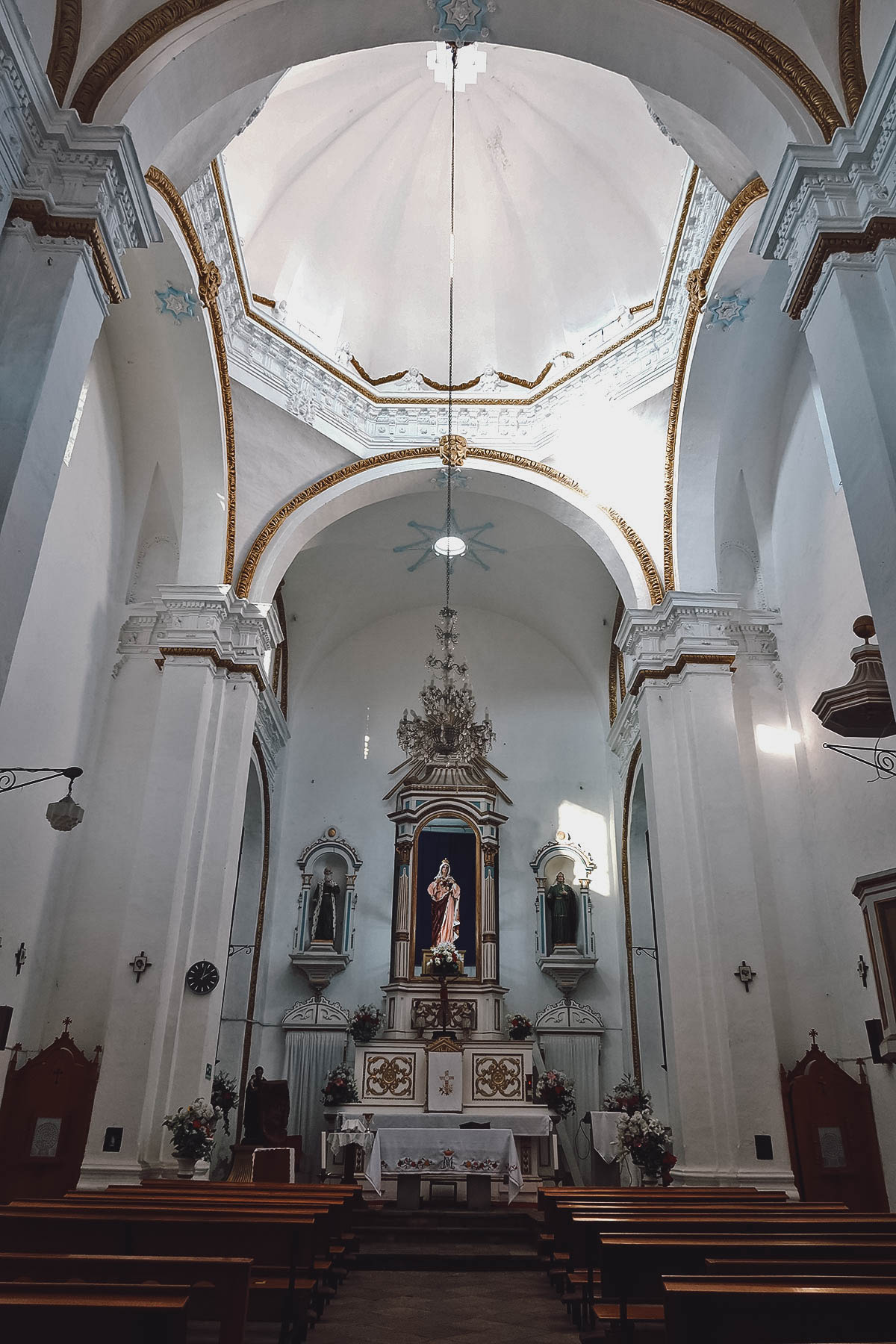
Nuestra Señora de los Gozos
Address: Av. 13 Pte. 113, El Carmen, 72530 Puebla, Pue.
12. Iglesia de San Marcos
Iglesia de San Marcos is another beautiful church that you can’t help but notice thanks to its striking Baroque facade. It consists of red Poblano bricks and nine Talavera panels representing the Four Evangelists – Matthew, Mark, Luke, and John – along with St. Joseph, the Immaculate Virgin Mary, and the three Archangels – St. Michael, St. Raphael, and St. Gabriel.
Iglesia de San Marcos is located right next Capilla de San Ildefonso, which unfortunately I’ve never seen open.
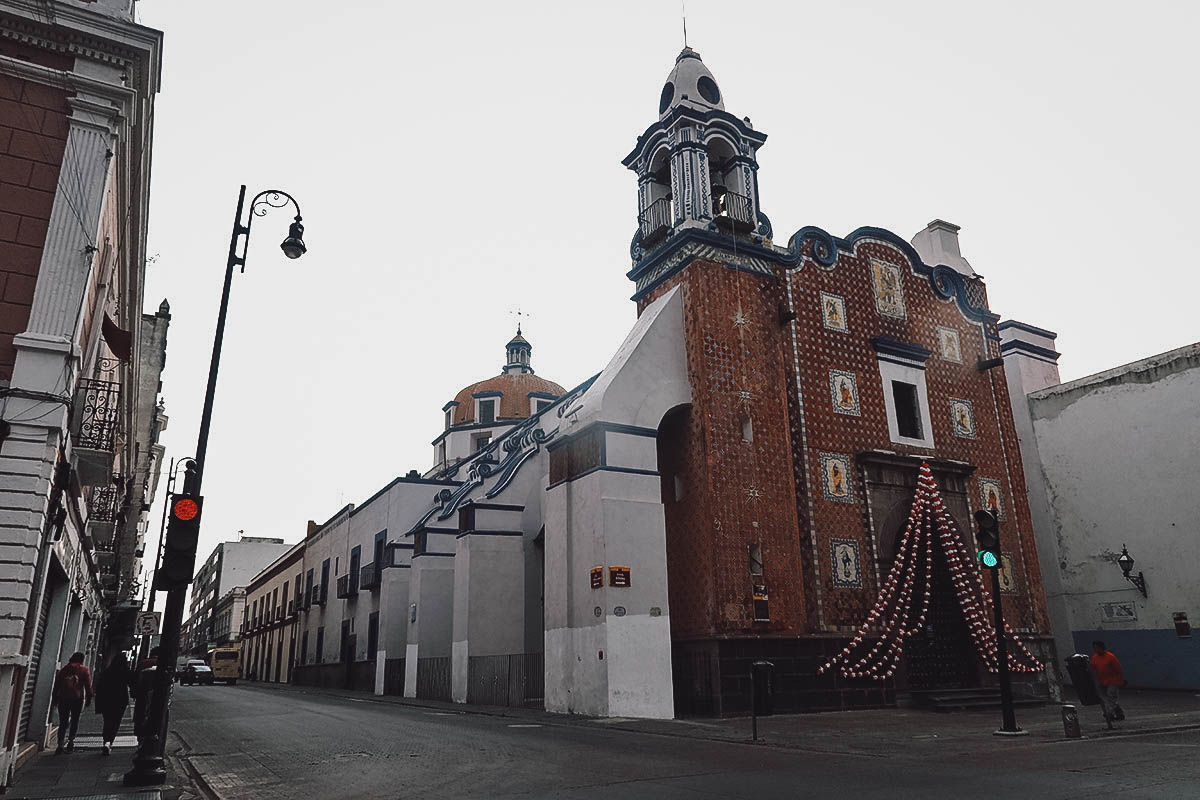
In contrast to its eye-catching Baroque facade, the interior of Iglesia de San Marcos is decorated in a more subdued neoclassical style.
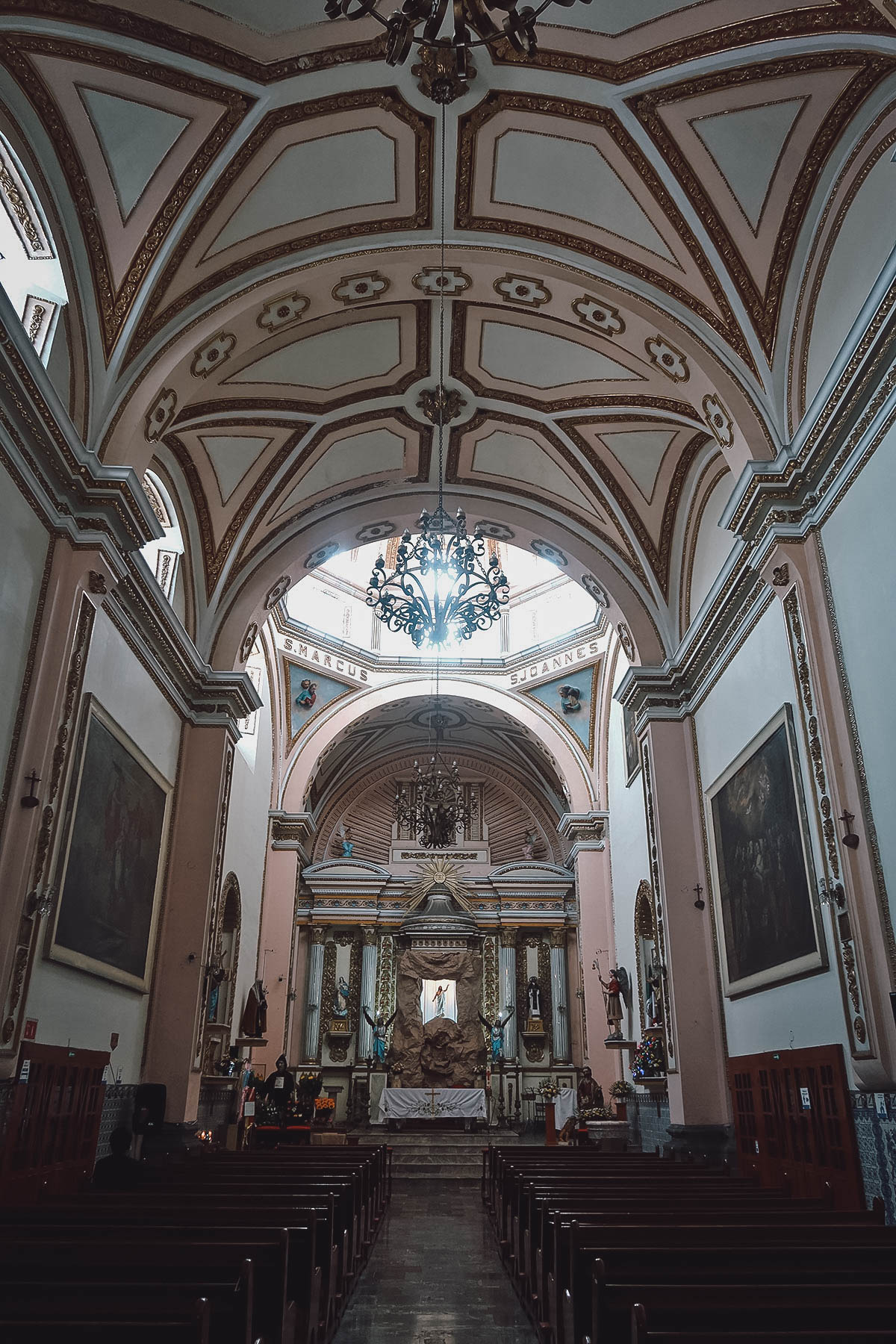
Iglesia de San Marcos
Address: 72000, Av. de la Reforma 738, San Pablo de los Frailes, 72000 Puebla, Pue.
11. Templo del Santo Ángel Custodio de Analco
I used to live in the Azcarte neighborhood so I’d often walk past this church on my way to the Historic Center. It’s a magnificent red and white church with a huge courtyard in Barrio de Analco.
For the first few weeks, I’d walk past this church at least once a day but I never saw it open. You could go into the courtyard but the church itself was always closed. I thought the church was permanently closed until I walked by one Sunday morning and found it open for 9AM mass.
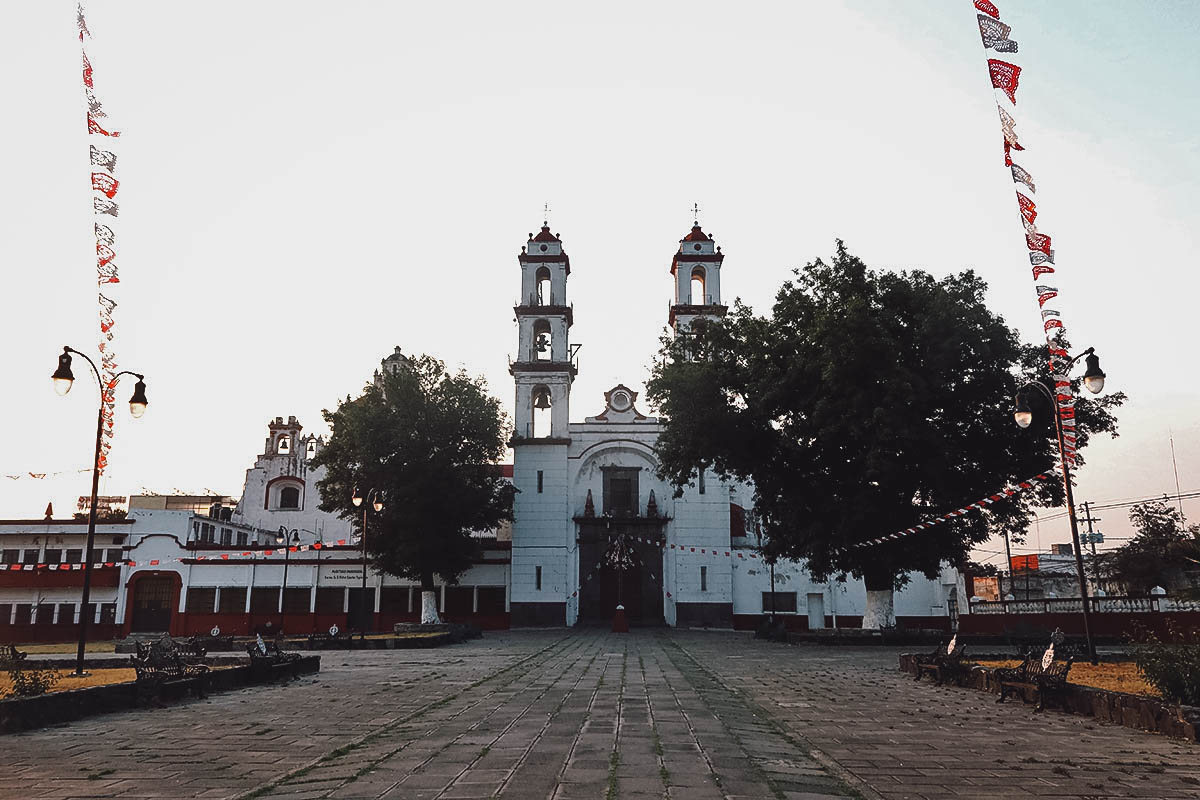
Analco in Nahuatl means “on the other side of the river”. It’s in reference to the fact that the church is located in a settlement on the other side of the San Francisco River.
The river has since been diverted but it was interesting to learn that it once served as a barrier to separate the natives from the Spaniards due to differences in language and religion.
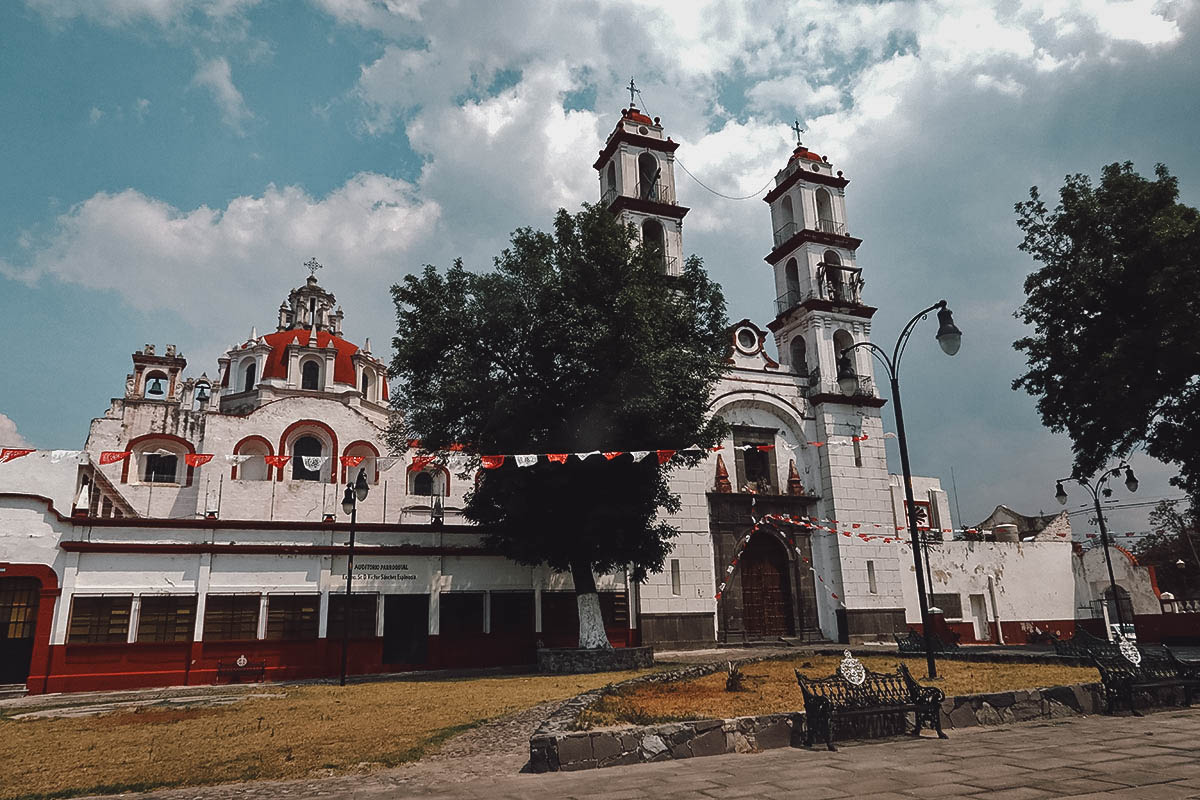
The interior of Analco Church is designed in a neoclassical style. Considering how big the church looks from the outside, I was surprised by how small and relatively unadorned its interior was.

Now this is more like it. On the left side of the nave is this side chapel that looks more elaborate than the main chapel. It features colorful and highly-detailed murals adorning almost every square inch of its domed interior. The murals look fairly new.
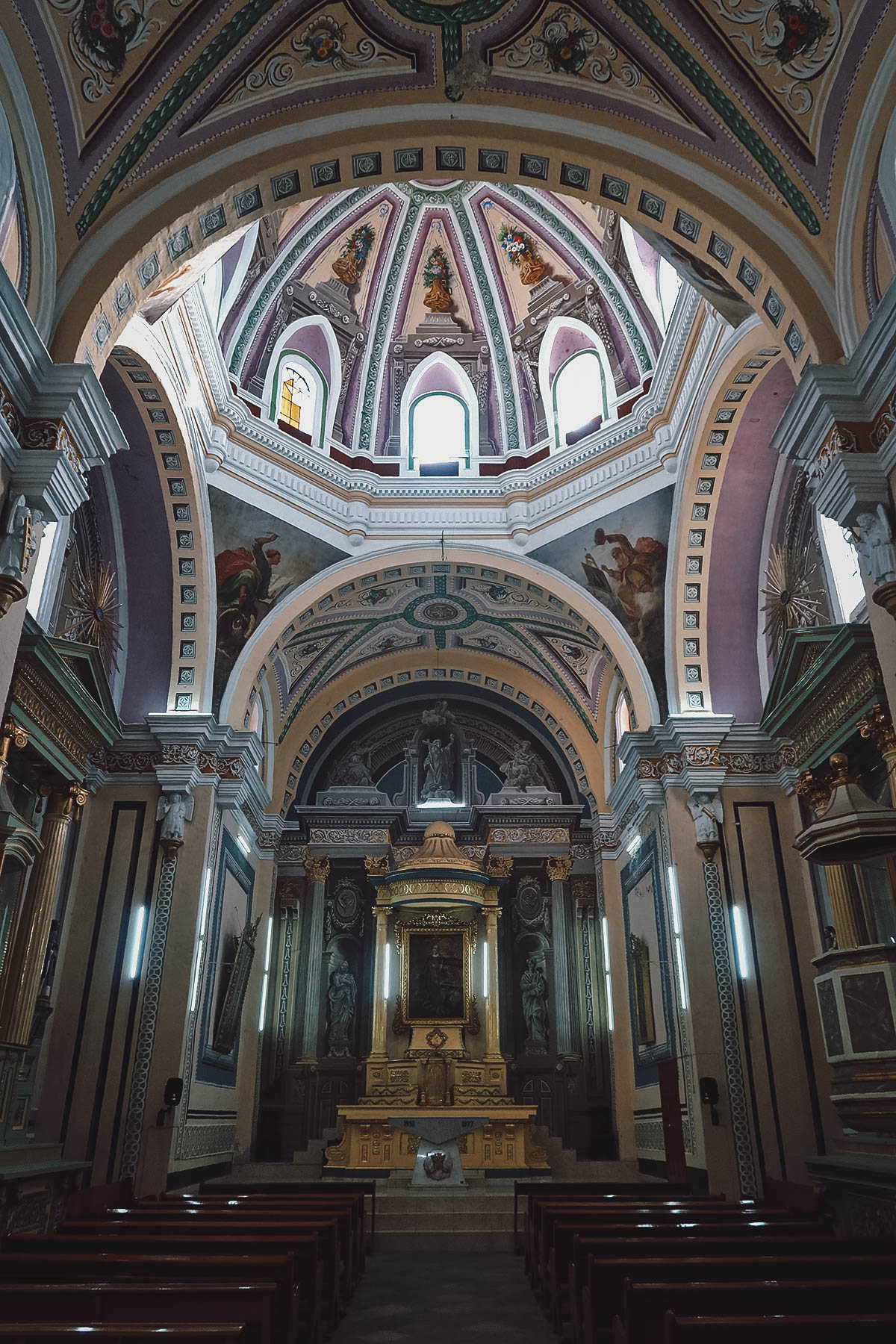
Templo del Santo Ángel Custodio de Analco
Address: Av 7 Ote 1202, Barrio de Analco, 72500 Puebla, Pue.
10. Templo de San Juan de Dios
The Temple of San Juan de Dios is a beautiful church located in the northern part of the Historic Center, near Templo de Santa Monica (#26) and Parroquia de Nuestro Señor San José (#15). Unfortunately, I can’t find any information on it other than the fact that it was built in the Herrerian style in the late 17th century and belonged to an old hospital of the same name.

Inside you’ll find a striking Baroque altarpiece and murals adorning its domed ceiling.
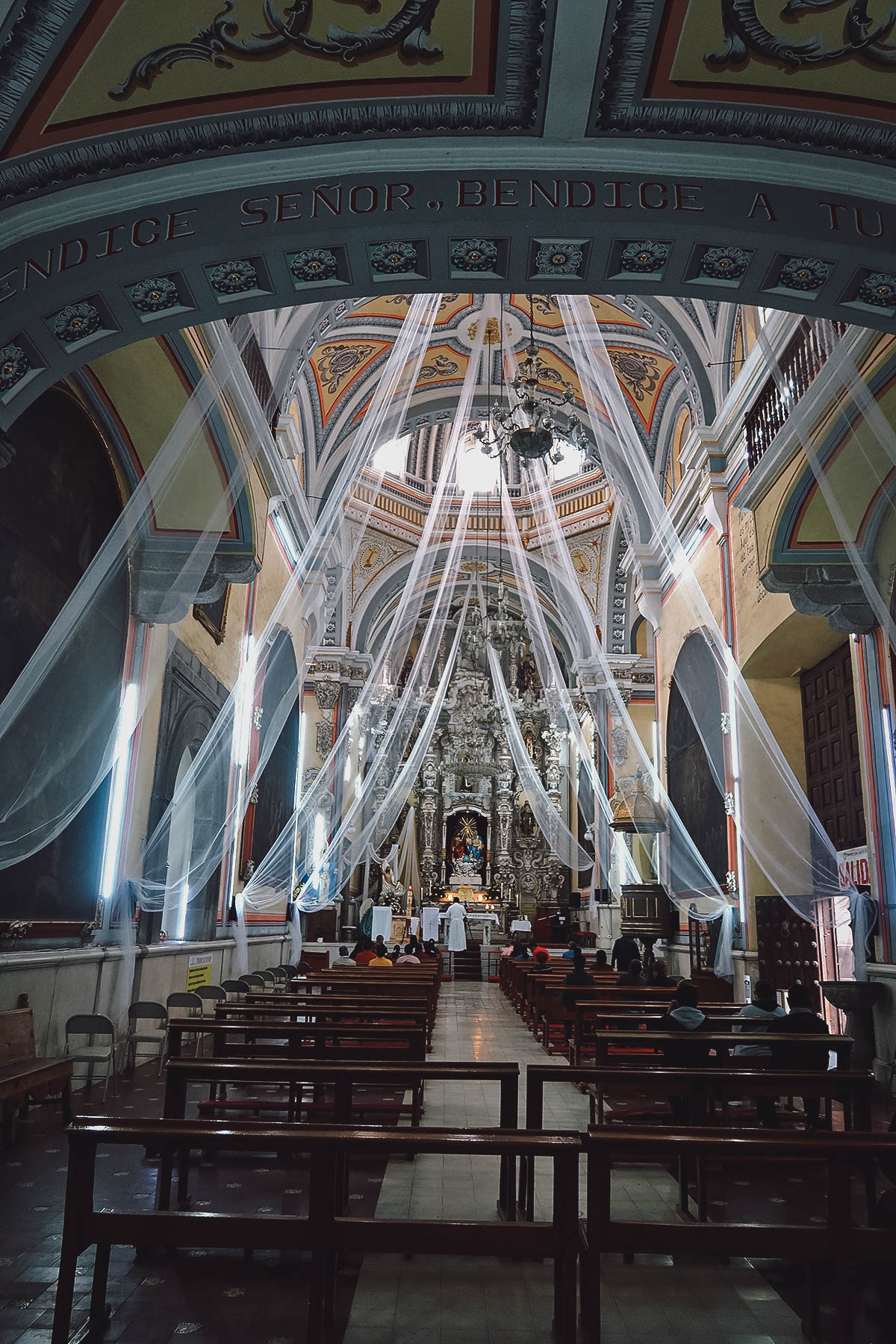
Templo de San Juan de Dios
Address: 5 de Mayo, Av 16 Ote Esquina, Centro histórico de Puebla, 72000 Puebla, Pue.
9. Parroquia de la Santa Cruz
Parroquia de la Santa Cruz is a beautiful church located in Barrio del Alto, just north of the Analco neighborhood. It’s one of the most photogenic churches on this list. It isn’t boxed in by any adjacent buildings so it’s quite easy to photograph, even from a distance.

According to the church’s history, Parroquia de la Santa Cruz was built and consecrated in the early 18th century. Parroquia de Nuestro Señor San Jose (#15) could no longer accommodate its rapidly growing congregation so Bishop Manuel Fernandez de Santa Cruz ordered this church to be built to service this part of the city.
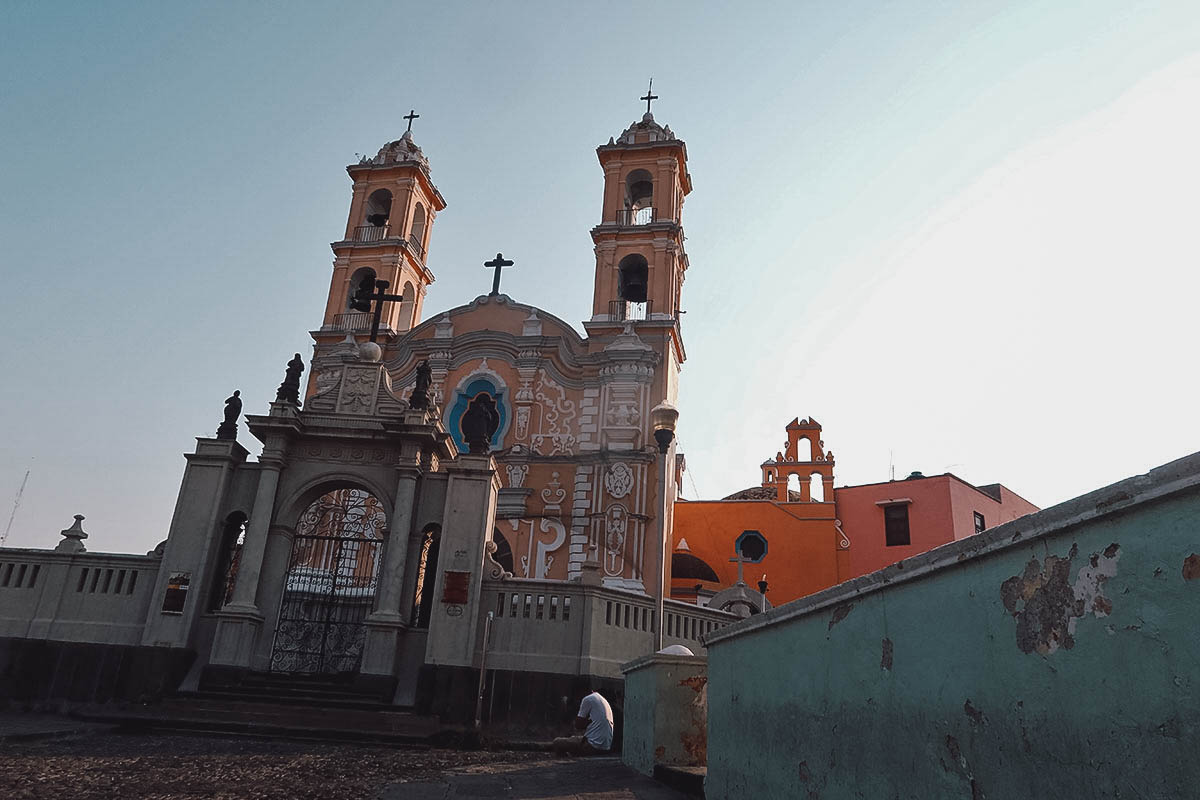
There were baptisms being held at the time of my visit so I almost couldn’t get a picture inside. Designed in a neoclassical style, the interior of the church is relatively simple but beautiful.
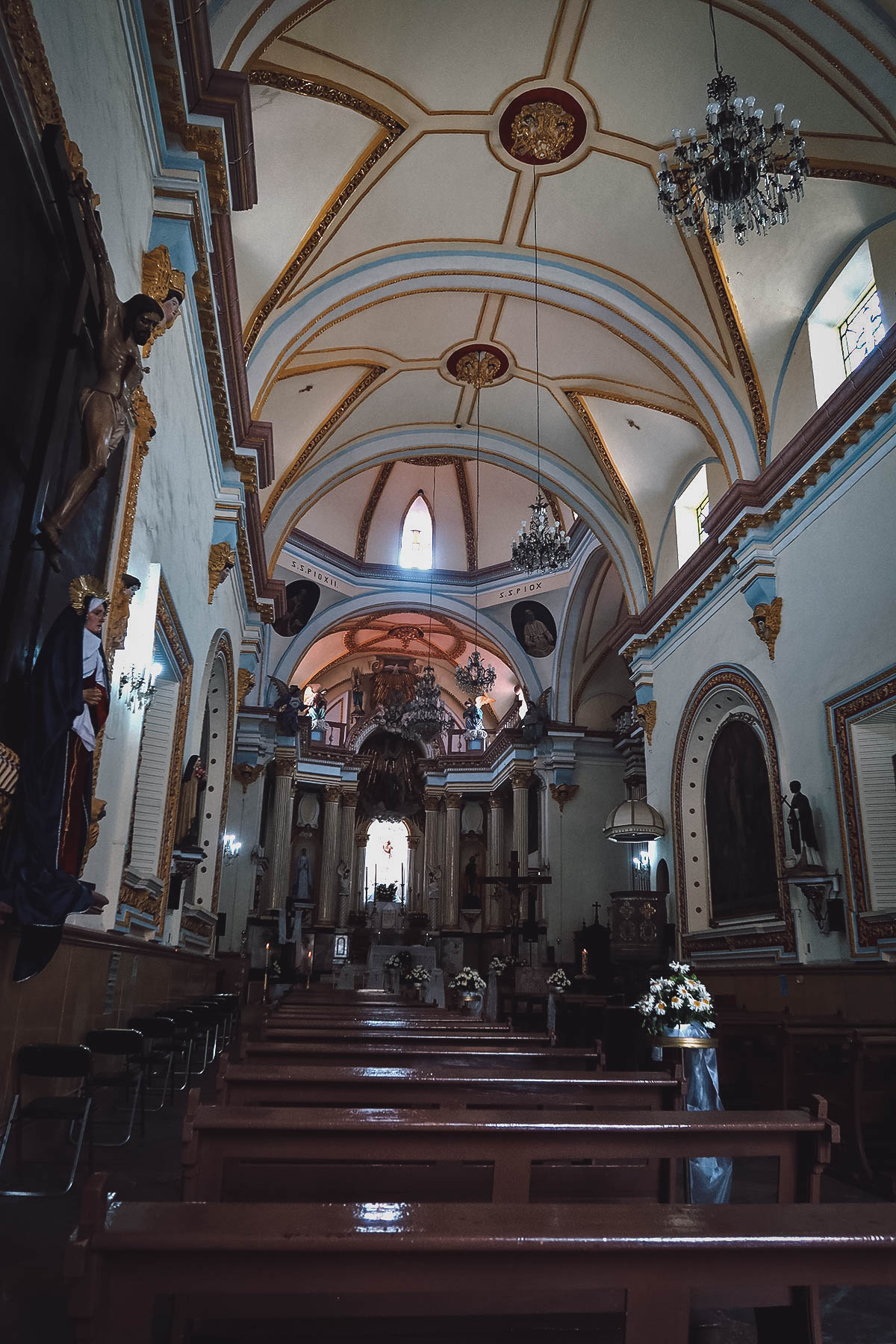
Parroquia de la Santa Cruz
Address: Av 16 Ote El, Barrio del Alto, 72000 Puebla, Pue.
8. Santuario de Nuestra Señora de Guadalupe
Santuario de Nuestra Señora de Guadalupe is a small but striking church at the north end of Paseo Bravo park. Like some of the churches on this list, it’s a great example of the Poblano Baroque style thanks to its red brick facade (petatillo) adorned with Talavera tiles.
As its name suggests, this church is dedicated to the Virgin of Guadalupe. It was built in 1714 and consecrated in 1722.
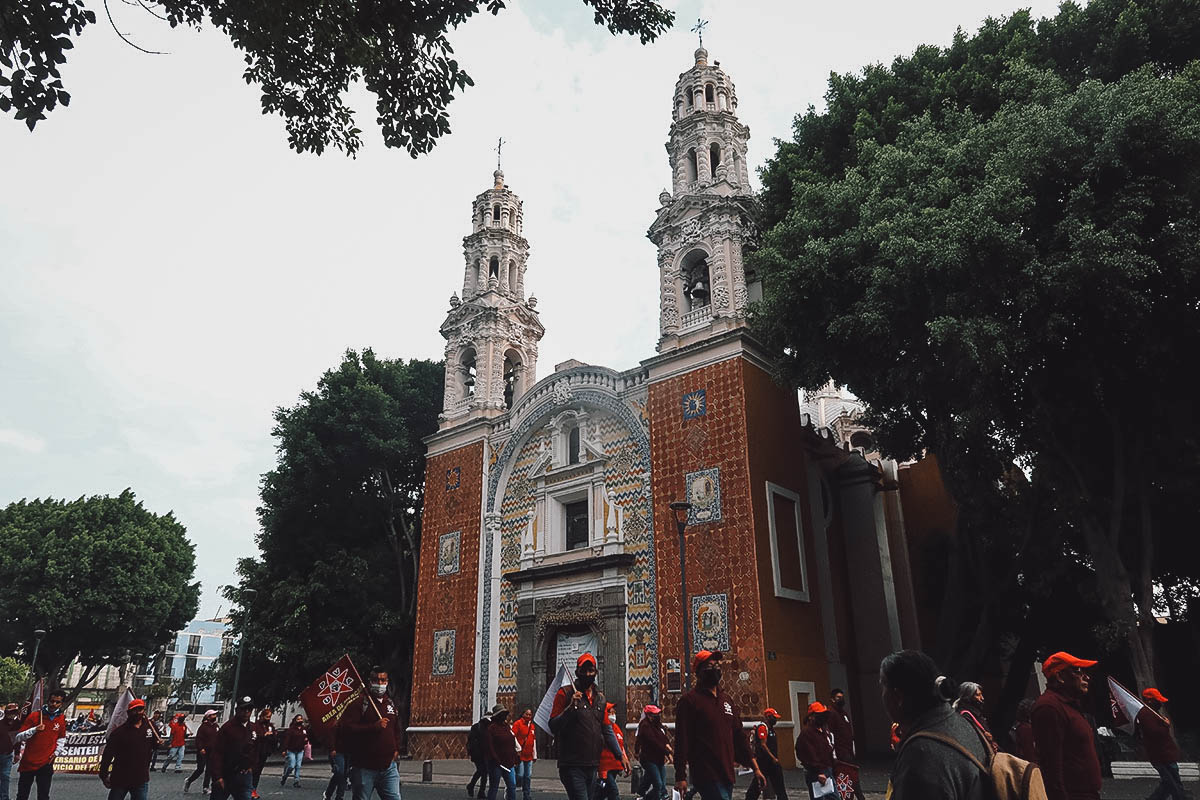
Like many of the churches in Puebla, the interior of this church was originally decorated in the Baroque style but it was given a neoclassical makeover sometime in the second half of the 19th century.
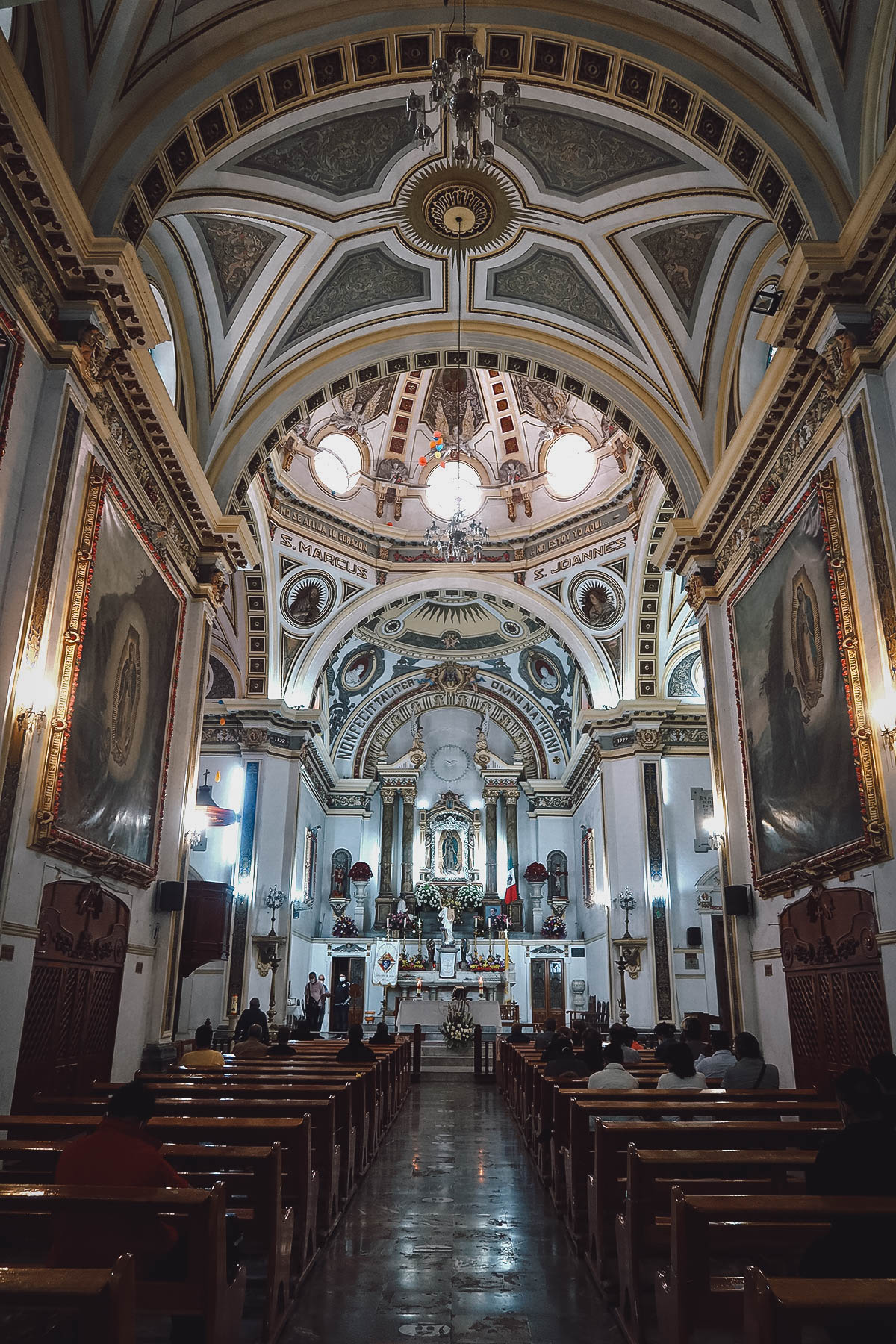
Santuario de Nuestra Señora de Guadalupe
Address: 72090, Av. de la Reforma 1108, Centro histórico de Puebla, 72090 Puebla, Pue.
7. Iglesia de Nuestra Señora de la Luz
As you can probably tell by now, I’m a sucker for this Poblano style of Baroque architecture. The combination of the red bricks with the Talavera tiles is so striking.
Iglesia de Nuestra Señora de la Luz is a small but beautiful church located in Barrio de la Luz. It was consecrated in 1804 though it wasn’t completely finished until 1818.
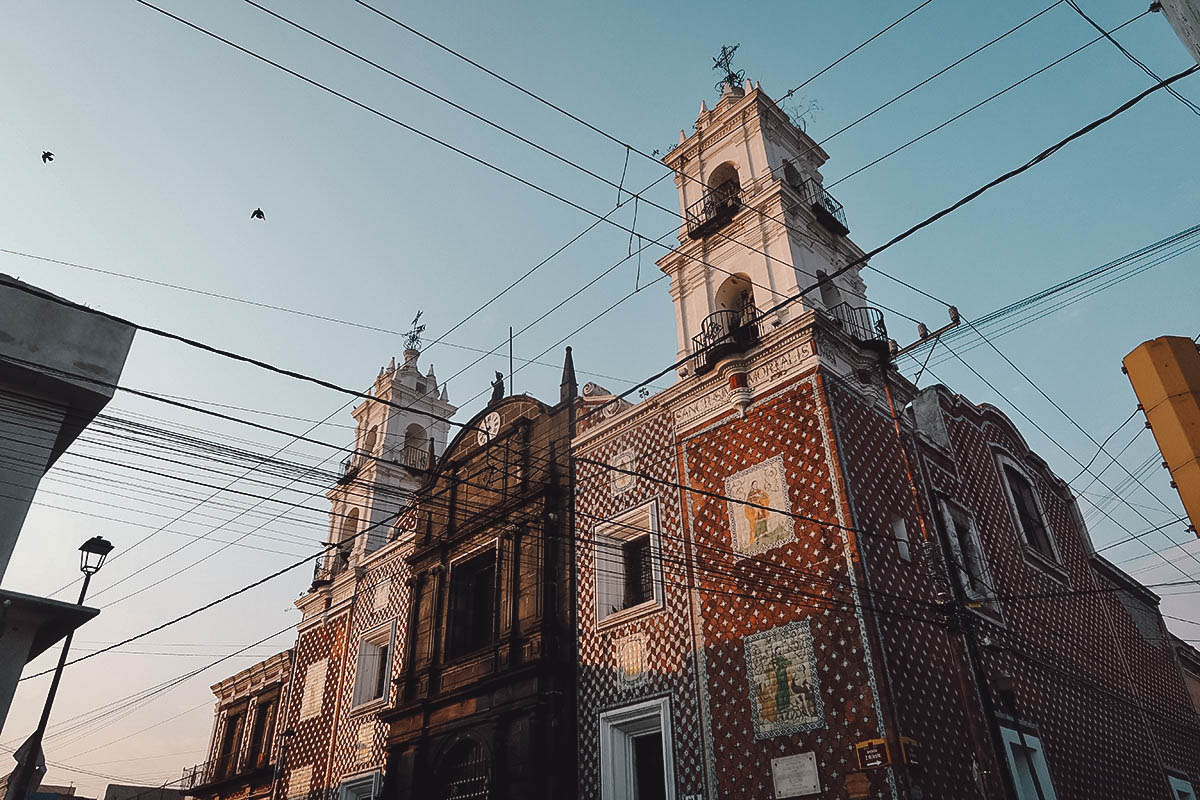
The interior of the church isn’t that big but I found it to be one of the most beautiful. The lighting is gorgeous.

Iglesia de Nuestra Señora de la Luz
Address: Av 2 Ote 1401, Barrio de la Luz, 72377 Puebla, Pue.
6. La Compañía – Templo Expiatorio del Espíritu Santo
The Temple of the Holy Spirit is one of the most well-known churches in Puebla. Aside from its striking white exterior set atop a stone base, it’s famous for being the final resting place of Catarina de San Juan, an Asian slave turned beata who’s credited for inspiring Puebla’s traditional dress – the China Poblana.
The Temple of the Holy Spirit is also known as “La Compañia” because it was founded by the Society of Jesus (La Compañia de Jesus). The church was consecrated in 1600 though it wasn’t completely finished until the mid-18th century.
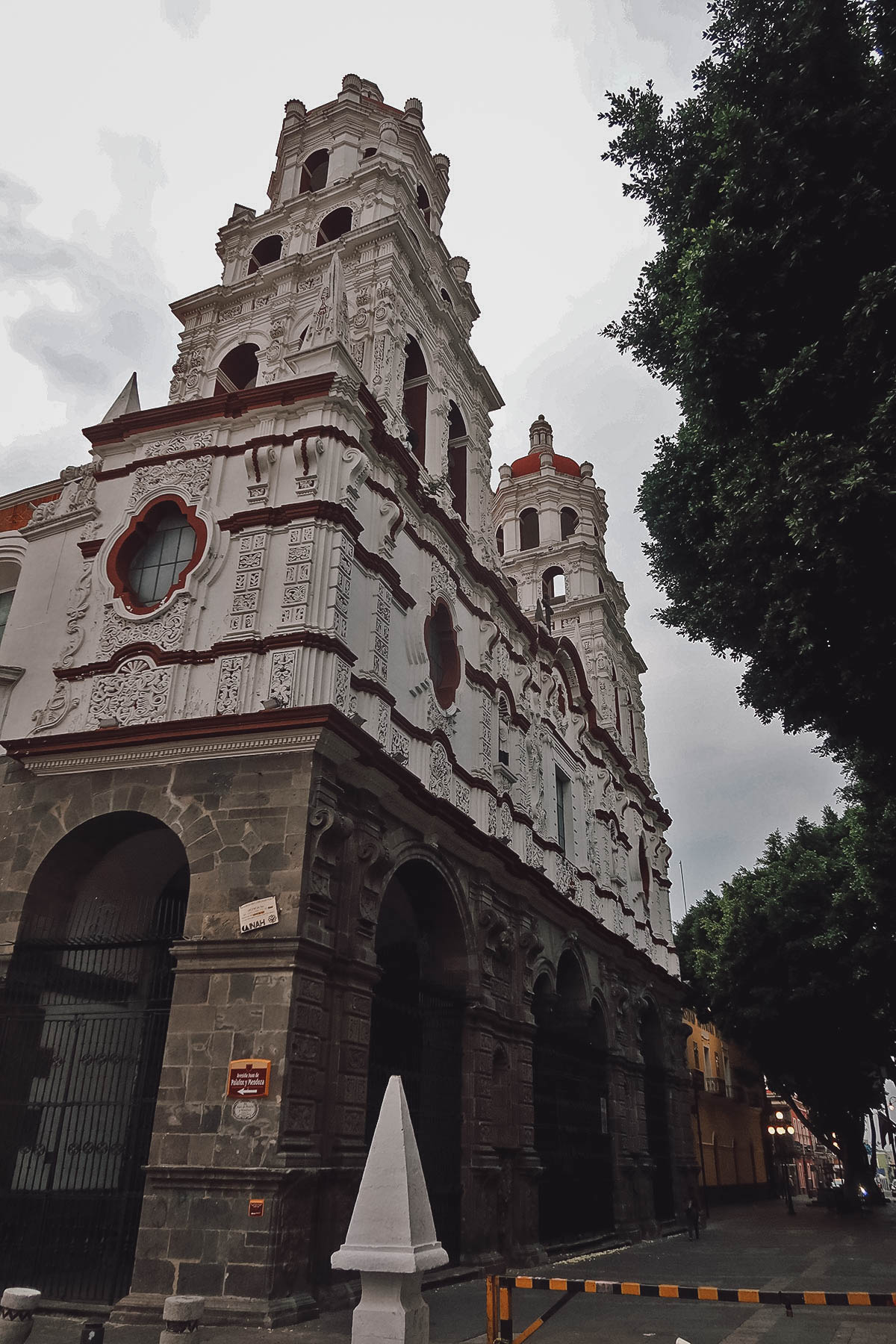
The Temple of the Holy Spirit is located just a block away from the zocalo, making it one of the easiest churches to visit in Puebla. Note its lovely petatillo brickwork, a commonly seen style of bricklaying in the Historic Center of Puebla.
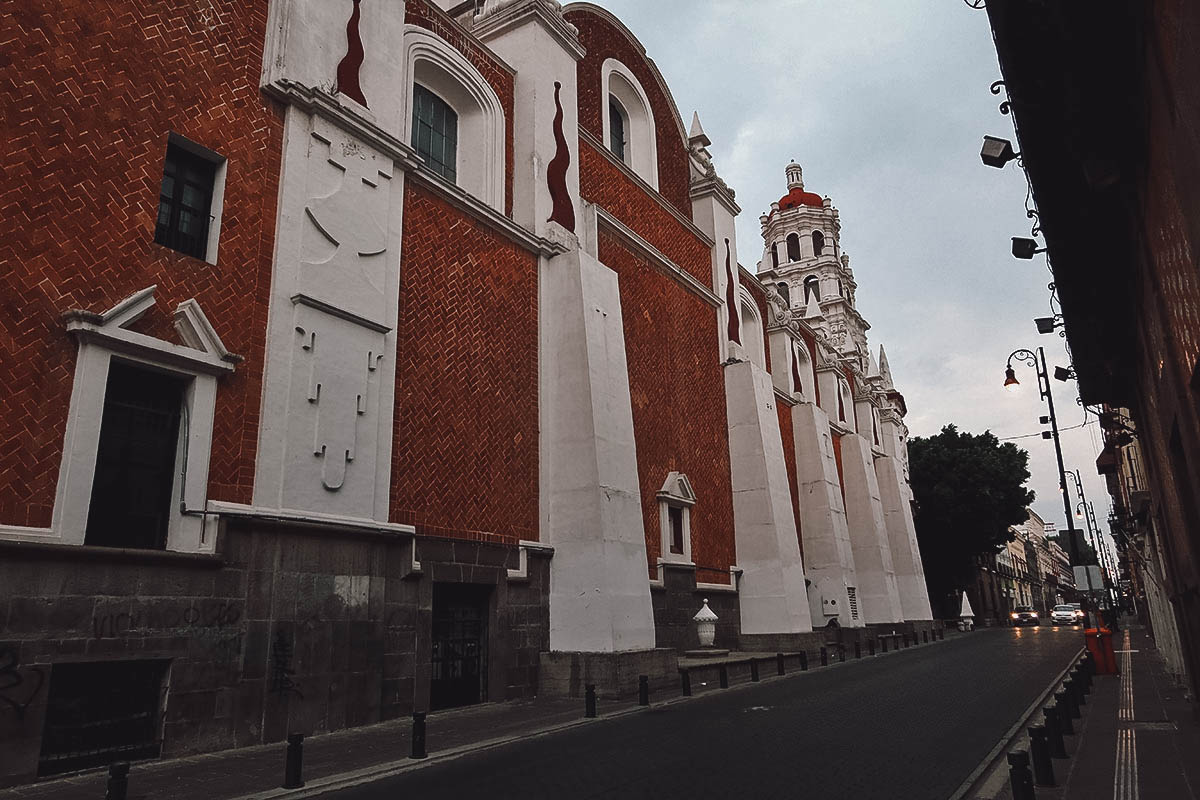
The interior of La Compañia is as impressive as its facade. I haven’t seen it but in the antechamber of the church’s sacristy, embedded in the wall, is the tombstone of Catarina de San Juan.
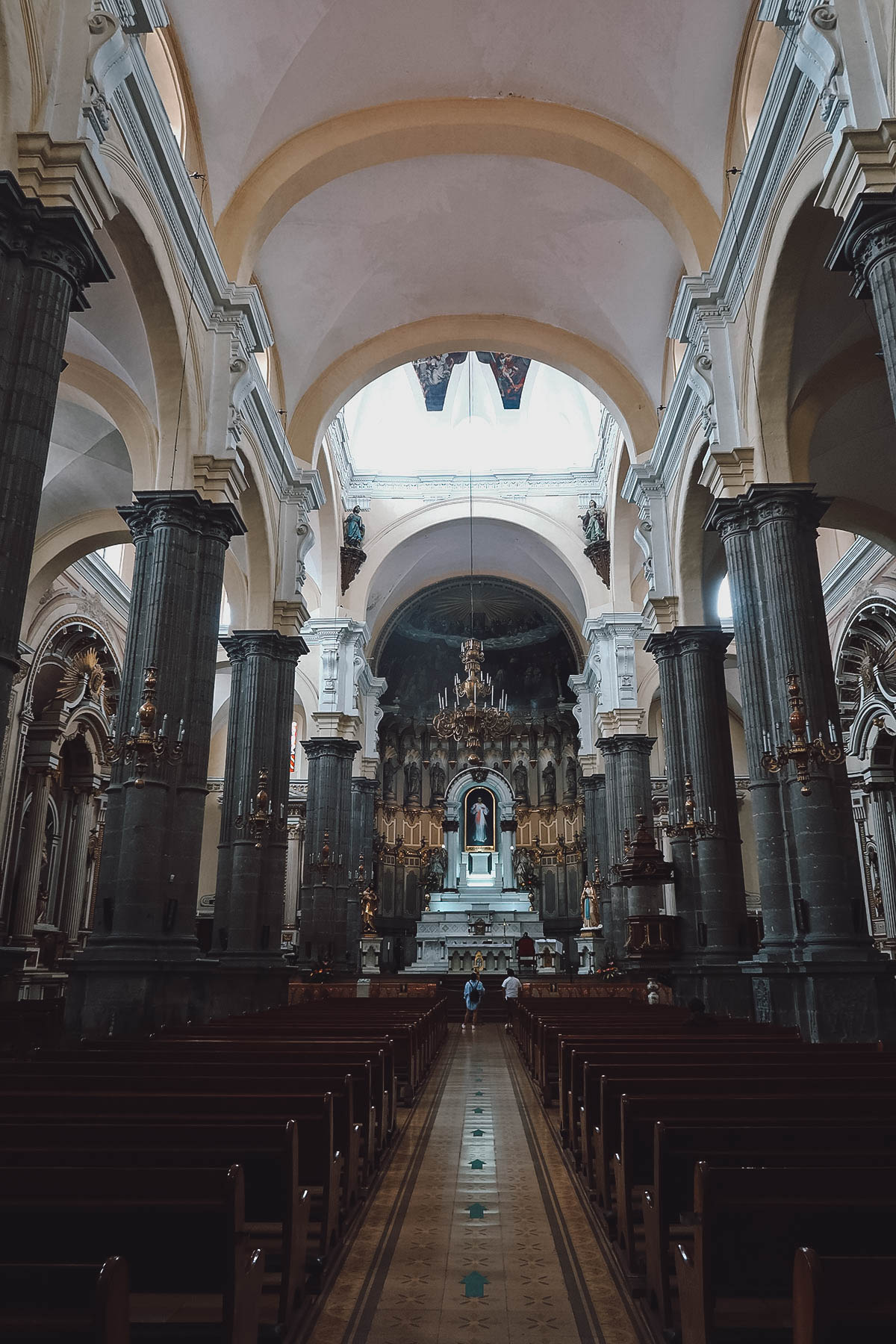
La Compañía – Templo Expiatorio del Espíritu Santo
Address: C. 4 Sur S/N, Centro, 72000 Puebla, Pue.
5. Nuestra Señora de la Medalla Milagrosa
Nuestra Señora de la Medalla Milagrosa is easily one of the most striking and visually unique churches in Puebla. It’s a modern church that looks very different from any other church on this list.
Nuestra Señora de la Medalla Milagrosa is located in the Bella Vista neighborhood, about 1.4 miles (2.2 km) southeast of the zocalo. You can get there on foot in about half an hour.
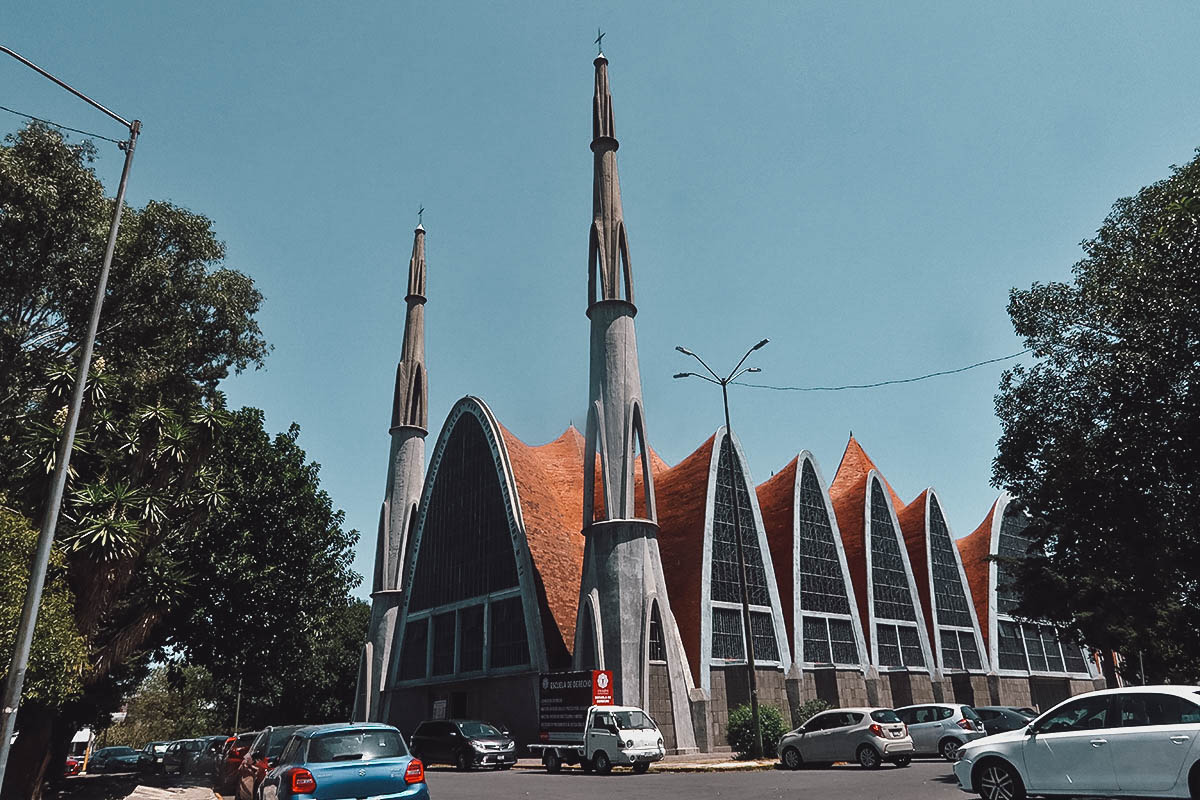
Unfortunately, there doesn’t seem to be much information about this church online. I don’t know when it was built but based on the little I’ve read, Nuestra Señora de la Medalla Milagrosa was designed in the Brutalist style.

Nuestra Señora de la Medalla Milagrosa
Address: Miguel Negrete 2107, Bella Vista, 72500 Puebla, Pue.
4. Templo de Nuestra Señora del Carmen
El Templo de Nuestra Señora del Carmen is one of my favorite examples of the Poblano Baroque style. It’s a beautiful church that once served as a bastion to help protect the city against the invading French army in 1863. It was dubbed “Fort Hidalgo” and fortified with turrets, remnants of which can still be observed today.
El Templo de Nuestra Señora del Carmen is located on the south side of Parque del Carmen, a small but pleasant park about a 10-minute walk south of the zocalo. I often sit at this park to enjoy ice cream from Mary Barragan, one of the best (if not the best) ice cream shops in Puebla.

You can really appreciate the beauty of the petatillo brickwork in this picture. Petatillo refers to a style of bricklaying where the bricks are laid diagonally to resemble an interlaced woven pattern. It’s a common sight in the Historic Center of Puebla.

Based purely on its facade, I think El Templo de Nuestra Señora del Carmen may be the most beautiful church in Puebla.
I haven’t seen it but I believe the church grounds may be home to a cemetery as well. According to the church’s description, a graveyard was built in 1844 after a law was passed prohibiting the burial of bodies inside churches.
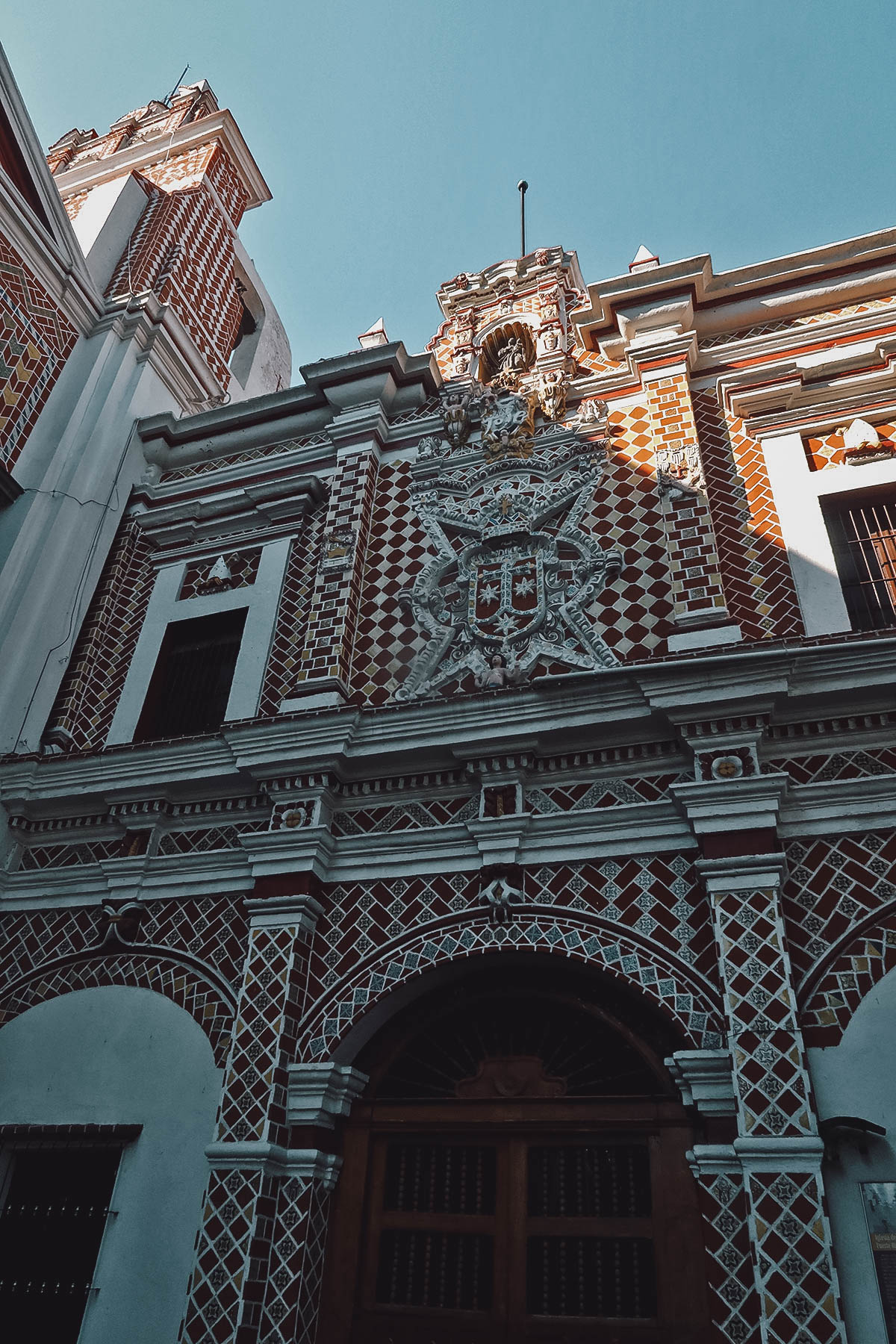
The nave is small but beautifully decorated with several large oil paintings hanging from the walls.
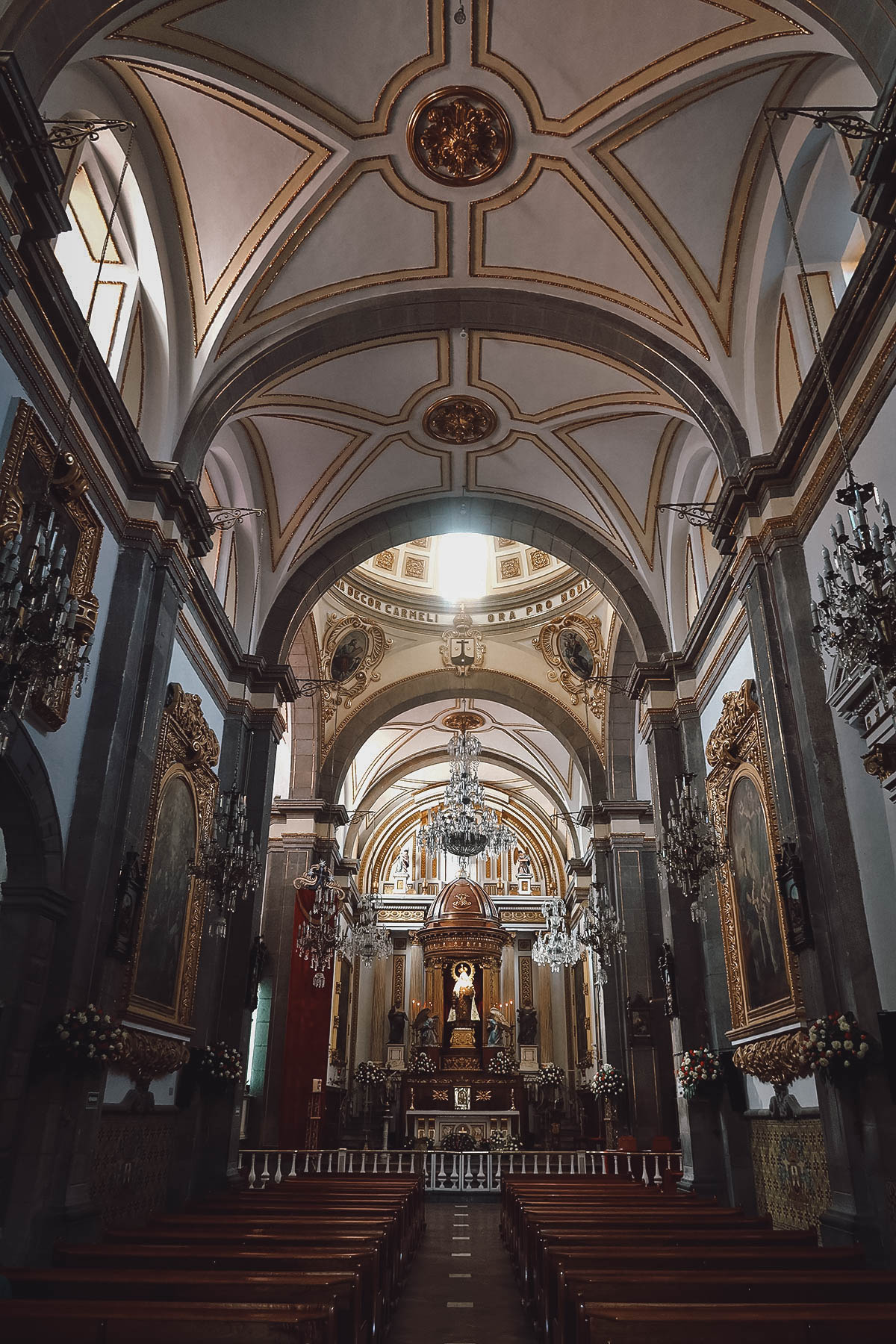
Beautiful fresco adorning the church’s dome.

Templo de Nuestra Señora del Carmen
Address: Av 17 Ote, El Carmen, 72530 Puebla, Pue.
3. Ex-convento de San Francisco de Puebla
From a distance, Ex-convento de San Francisco de Puebla has to be the most visually striking churches in Puebla. It can physically make you gasp the first time you see it.
Ex-convento de San Francisco de Puebla is the very first convent established in Puebla. It was founded in 1535 in the oldest part of the city, though it wasn’t consecrated until sometime between 1615 and 1697.
The most striking feature of the church is its bell tower which wasn’t completed until 1767. It stands at an impressive 207 ft high (63 m).
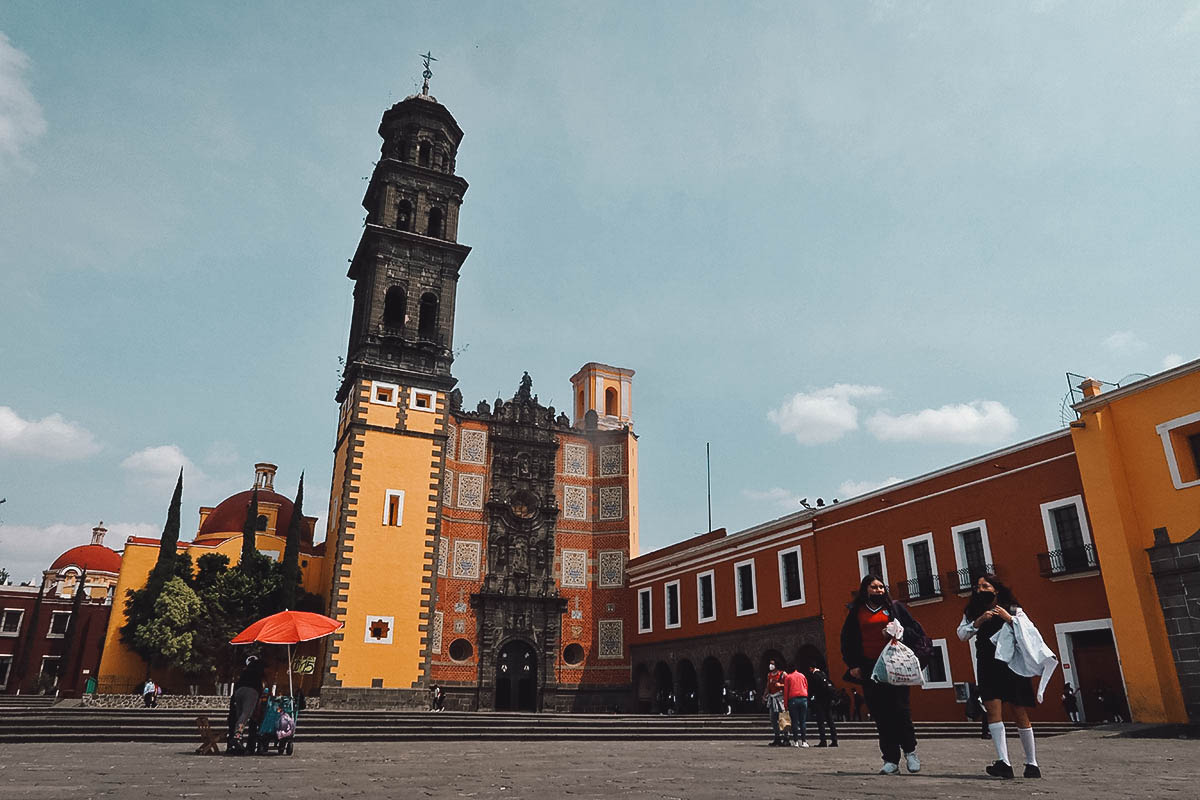
Adorning the church’s facade are these large Talavera panels. Fourteen depict vases with flowers while two smaller panels represent God the Father and the Virgin Conqueror.
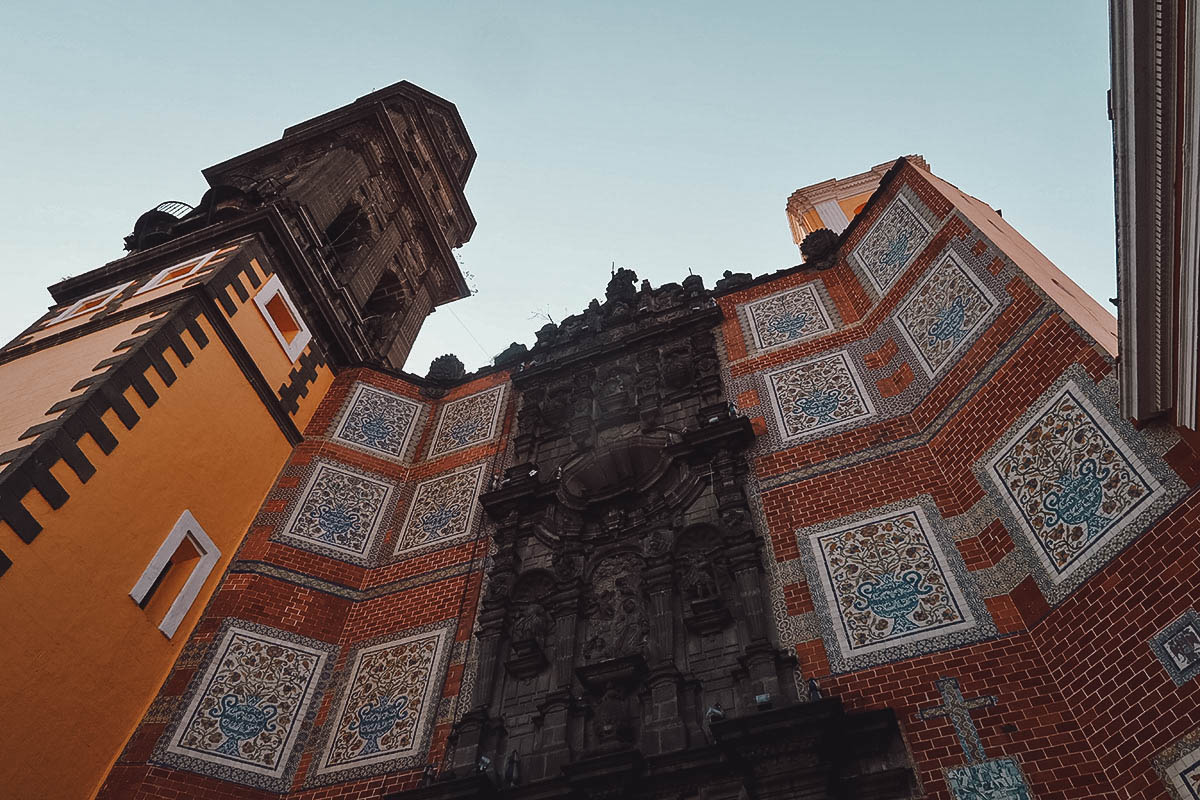
Compared to its magnificent facade and tower, the church’s interior is more subdued and understated in its design.
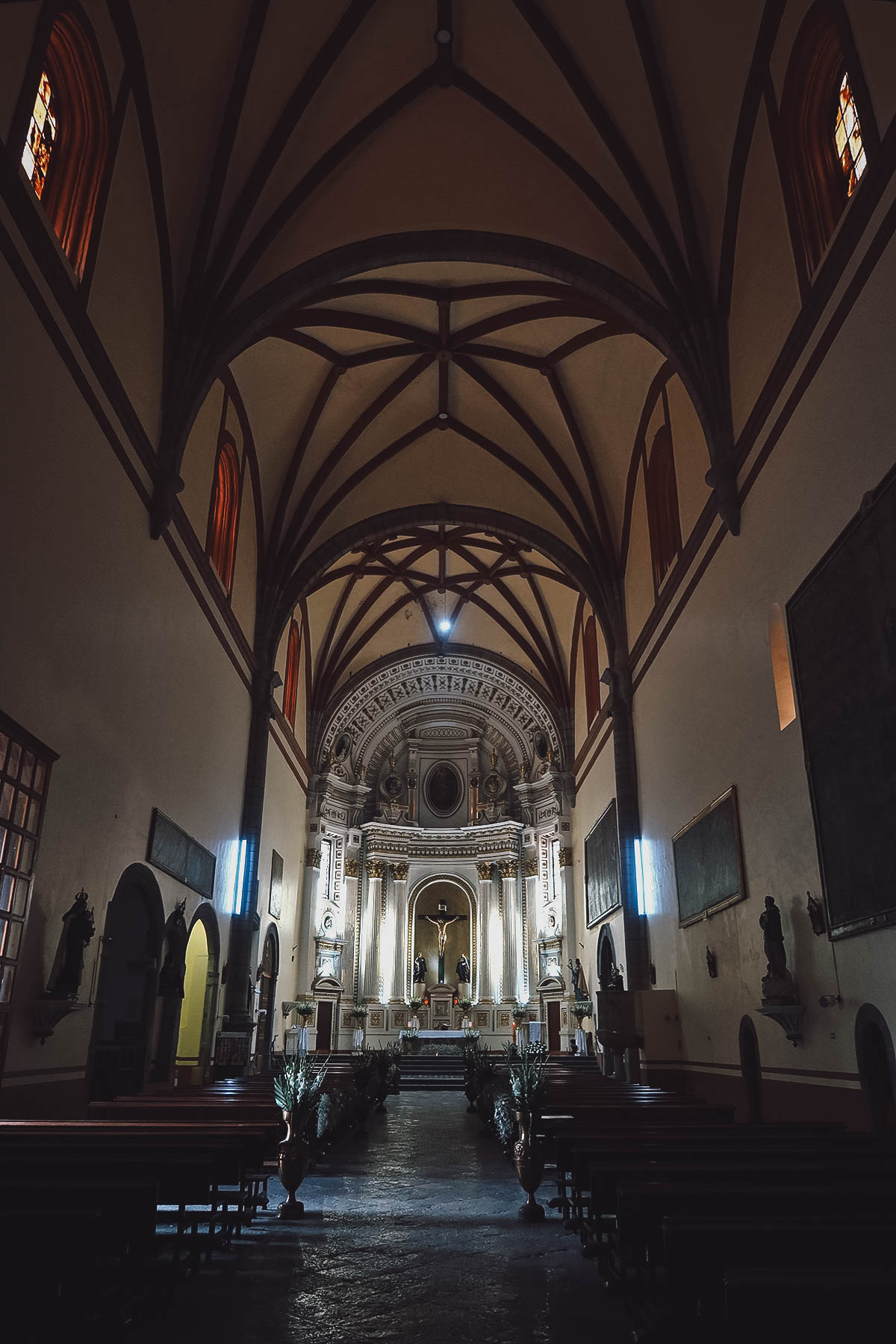
Ex-convento de San Francisco de Puebla
Address: Av 14 Ote 1009, Barrio del Alto, 72290 Puebla, Pue.
2. Capilla del Rosario, Templo de Santo Domingo
If you look up the most beautiful Baroque churches in Mexico, the Rosary Chapel inside the Church of Santo Domingo will surely come up. Praised for its architecture, it’s considered a masterpiece of the Mexican Baroque.
In its time, it was described as the “eighth wonder of the world” by Friar Diego de Gorospe. In 1979, Pope John Paul II famously dubbed it “America’s shrine”. You’ll see why in the following pictures.
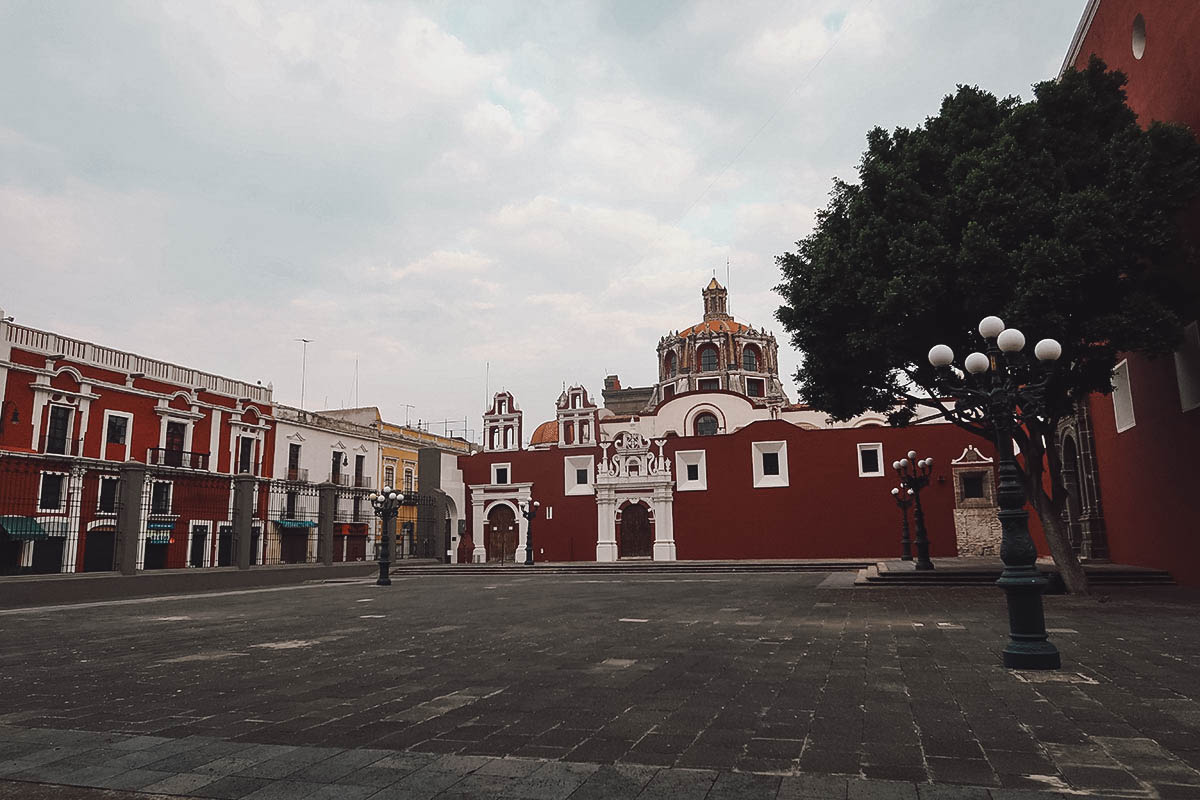
This is the nave of Santo Domingo Church. If you think this is impressive, wait until you see the Rosary Chapel.
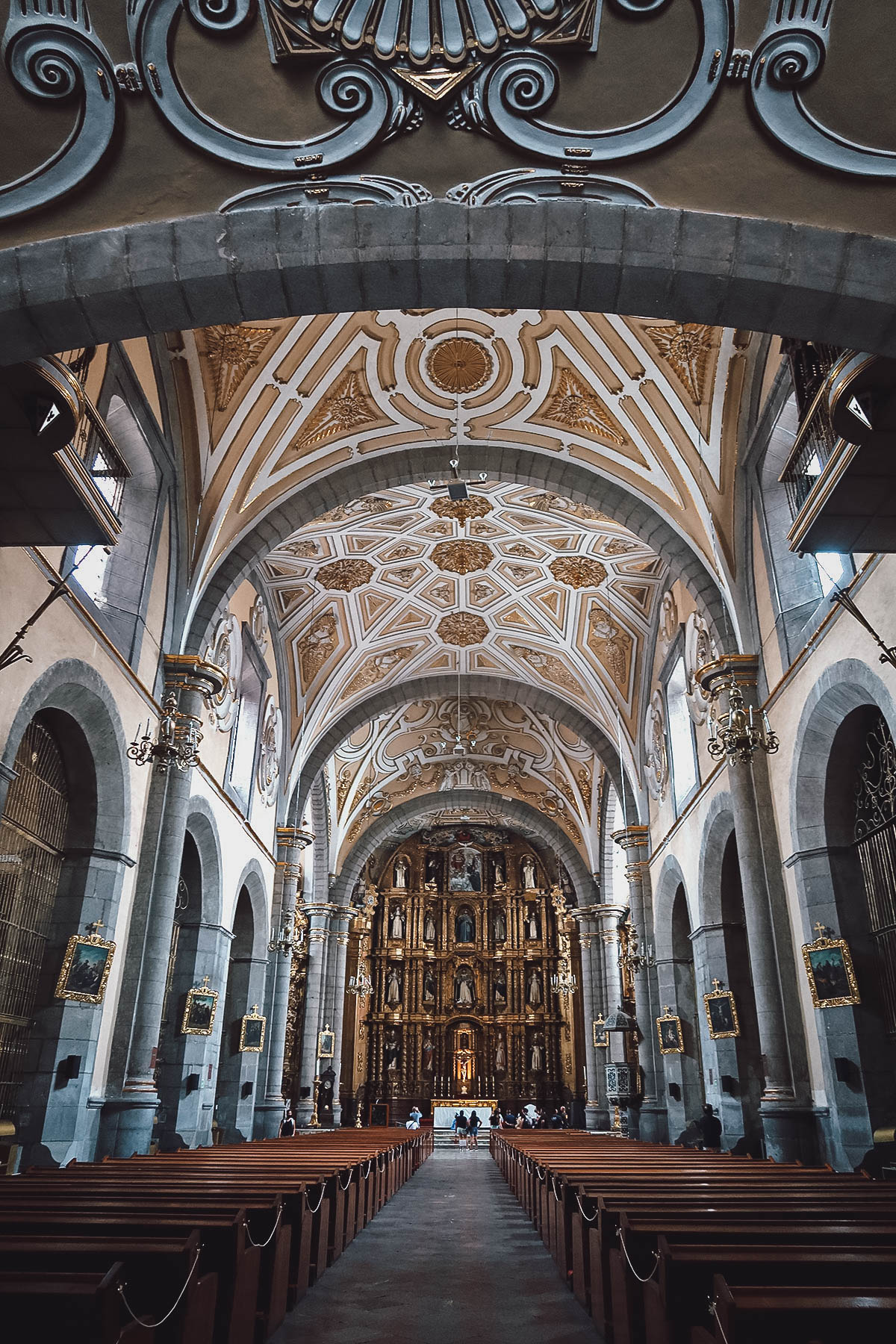
Behind the altar is this magnificent reredos featuring the Crucified Christ and about two dozen other sculpted figures.

This is what people come here to see. Also known as “The Golden House”, the Rosary Chapel has to be the most visually striking chapel in Mexico. Its interior is covered in 24K golden stucco and features numerous details in onyx and Talavera.
To describe the interior of this chapel as breathtaking would be an understatement. I’ve never seen anything quite like it.
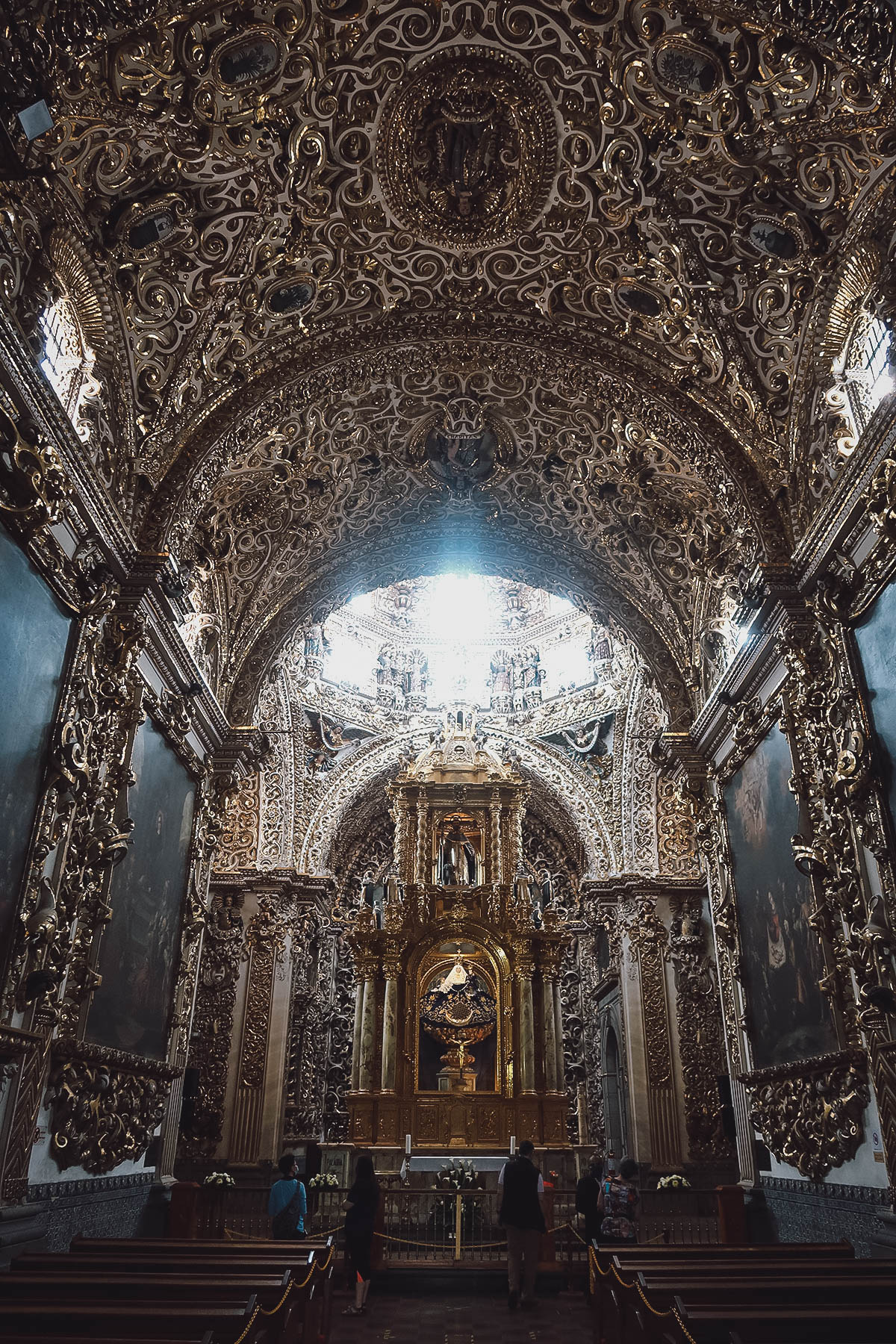
On either side of the nave are six large oil paintings by José Rodríguez Carnero. They depict key moments in the earthly life of the Virgin Mary.
Every church in Puebla is free to enter, including the Church of Santo Domingo, but there’s a MXN 20 admission fee to enter the Rosary Chapel. A nominal fee to see what many people describe as one of the greatest artistic-religious achievements in Mexico.
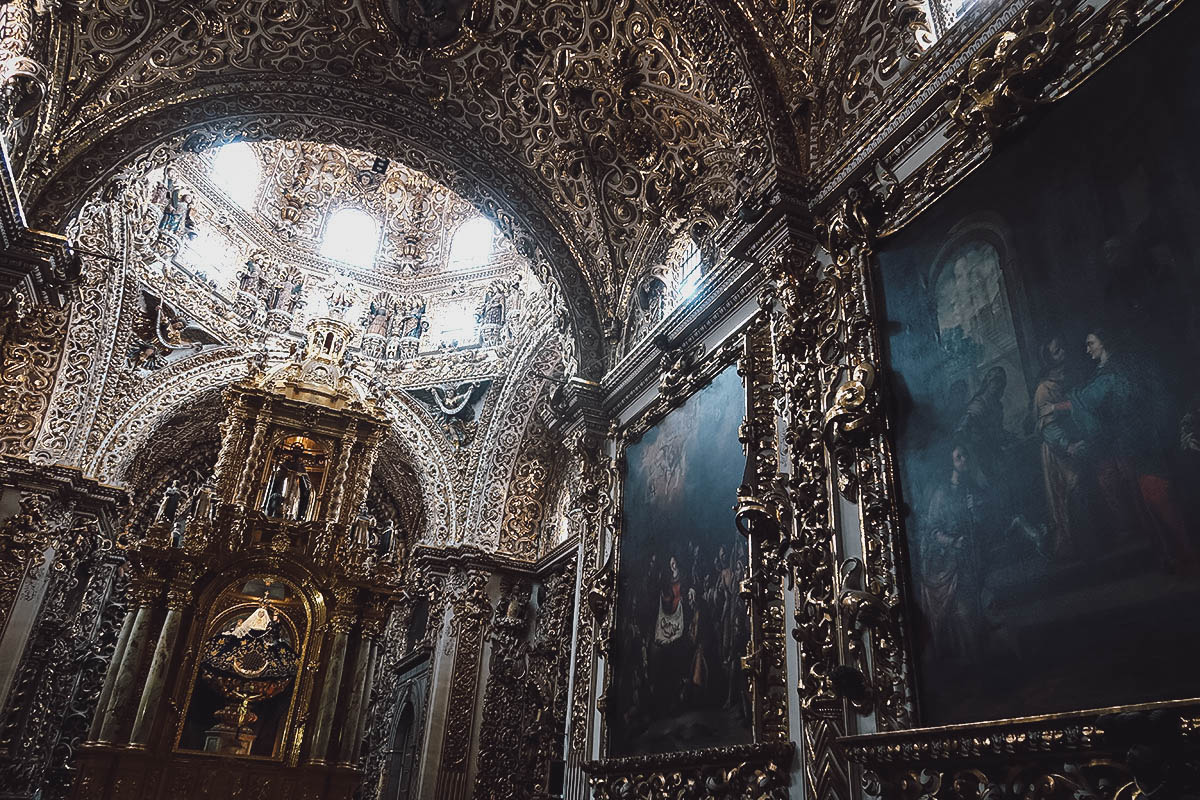
Capilla del Rosario, Templo de Santo Domingo
Address: Av. 4 Pte., Centro histórico de Puebla, 72000 Puebla, Pue.
1. La Catedral Basilica de Puebla
No discussion on the best churches and cathedrals in Puebla can ever be complete without mentioning this one. The lavish interior of the Rosary Chapel may be second to none, but as a whole, I still find Puebla Cathedral to be the most impressive.
This massive cathedral on the south side of the zocalo features five naves and two towers measuring 230 ft (70 m) each. One of the towers contains a total of ten bells.
As described at the top of this article, the heaviest bell is called “Campana Maria” and weighs in at a staggering 8 tons, 572 kilos, and 572 grams.
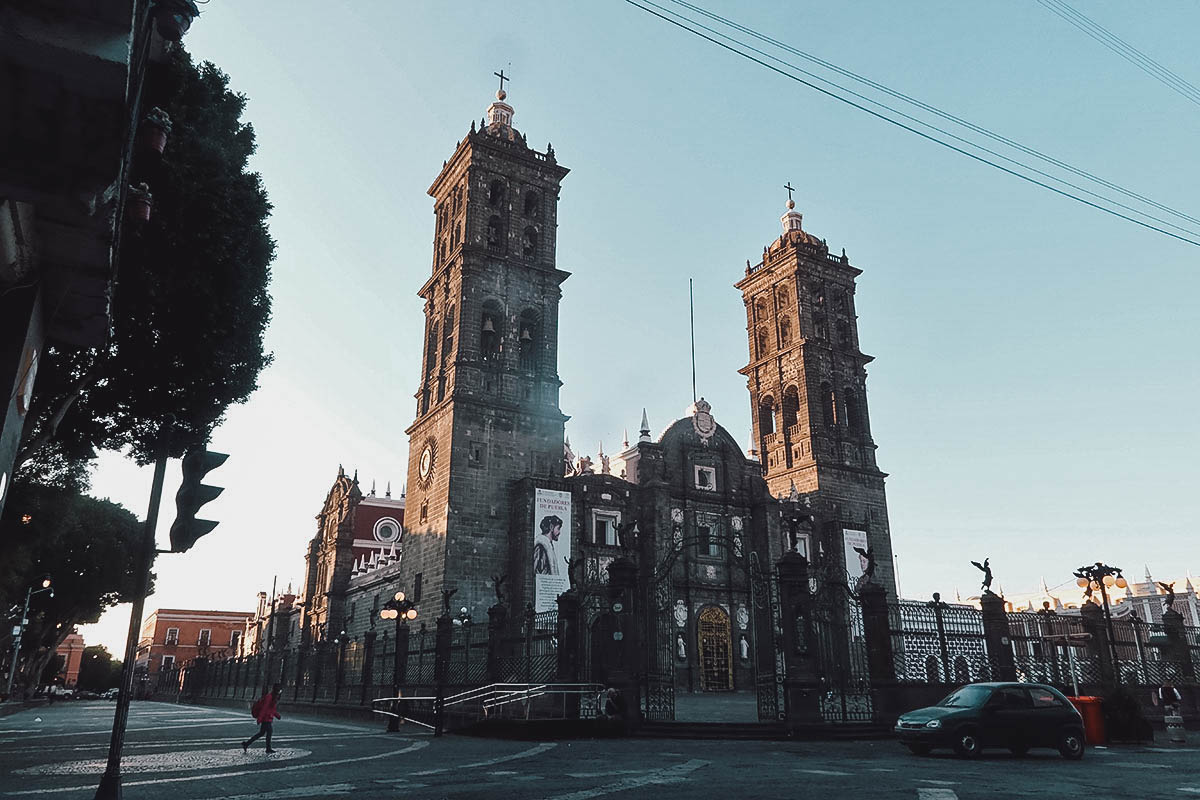
The current version of Puebla Cathedral was consecrated in 1649 but it wasn’t completed until 1737, 162 years after construction began.
The church’s interior is 322 ft long and 167 ft wide (98 m x 51 m). It features five naves in the shape of a Greek cross, fourteen columns measuring almost 49 ft high (15 m), two domes, and over two dozen cupolas.
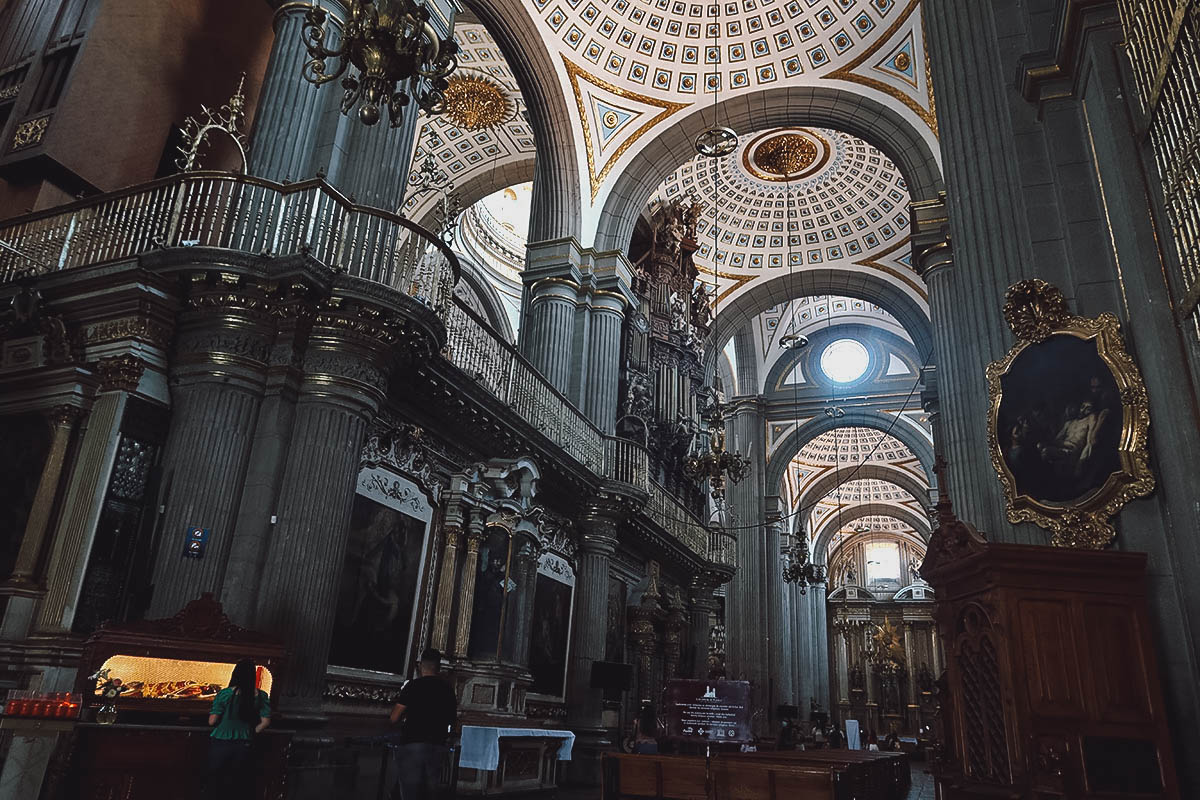
Puebla Cathedral is home to three massive organs. This one was built in 1737.
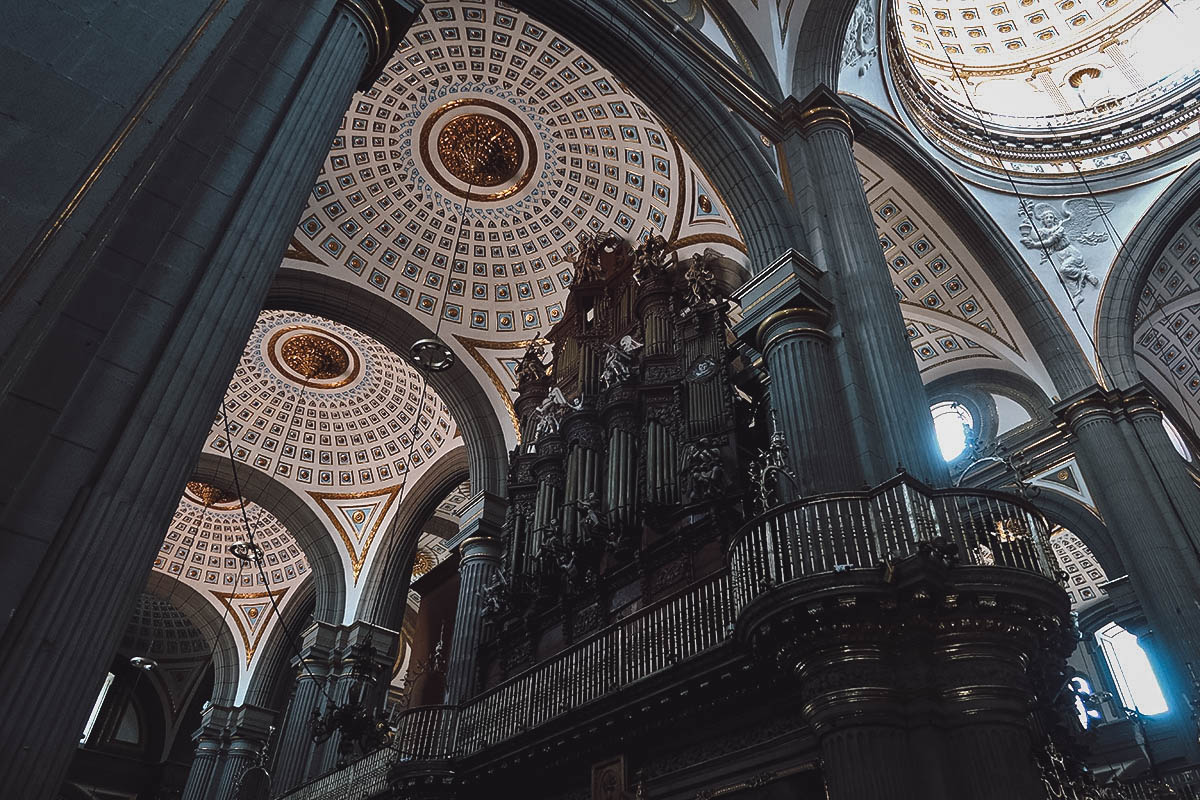
I’ve visited many churches throughout Mexico and for me, Puebla Cathedral is the most impressive. It truly is awe-inspiring.
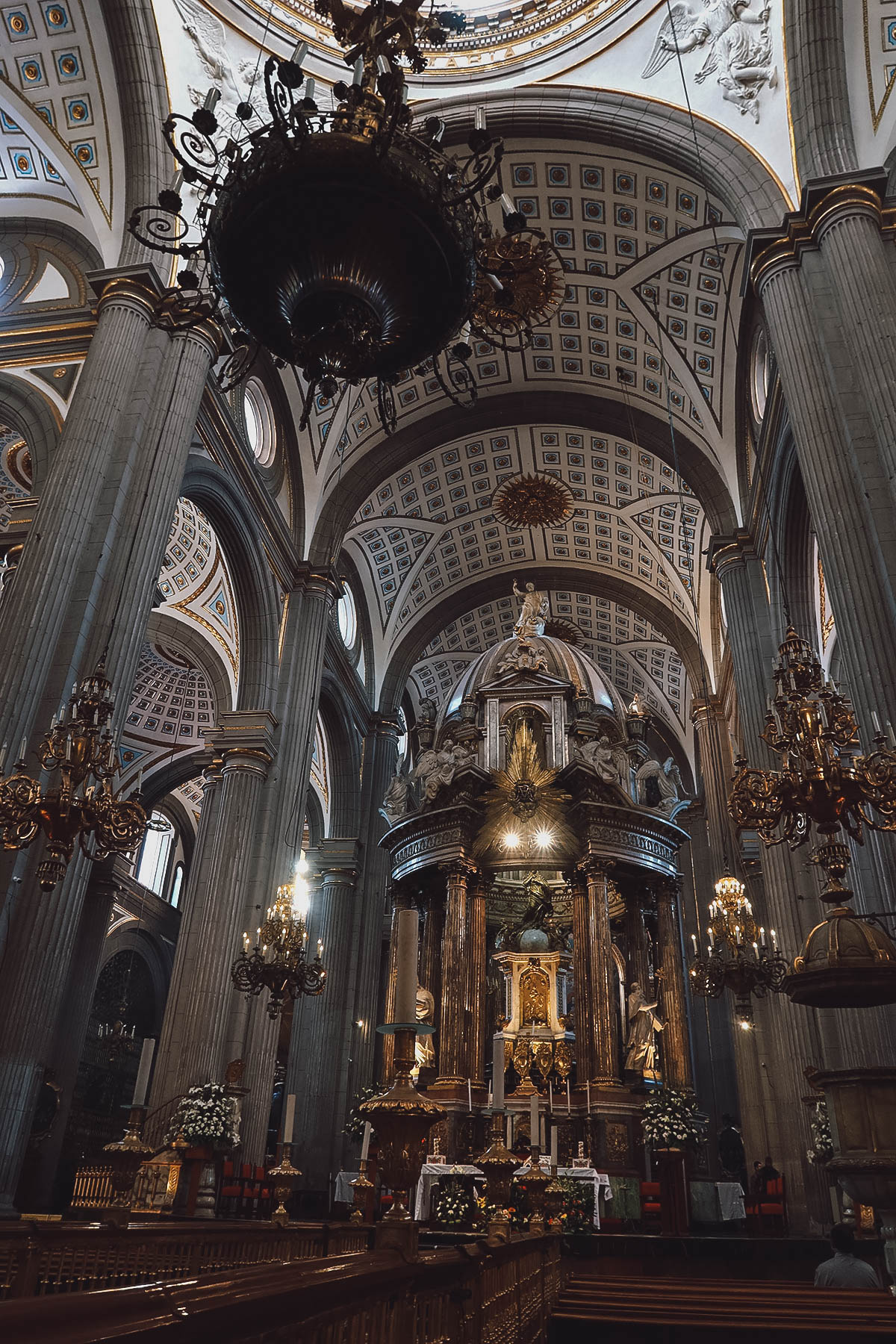
La Catedral Basilica de Puebla
Address: C. 16 de Septiembre s/n, Centro histórico de Puebla, 72000 Puebla, Pue.
RELATED ARTICLE: Discover Cantona Ruins, the Most Well-Preserved Archaeological Site in Mexico
PUEBLA CHURCHES LOCATION MAP
To help you navigate to these churches and cathedrals in Puebla, I’ve pinned them all on this map. Click on the link for a live version of the map.
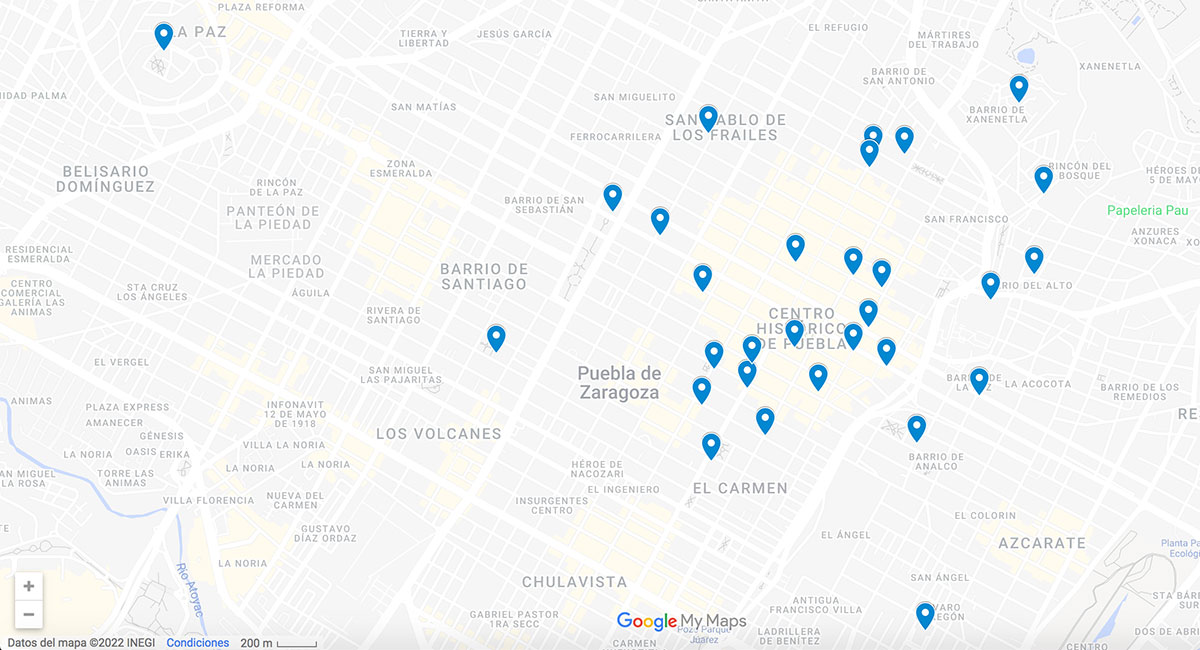
FINAL THOUGHTS ON THE CHURCHES IN PUEBLA, MEXICO
Regardless of your religious beliefs, the churches and cathedrals in Puebla are definitely worth adding to your itinerary. Aside from its many delicious regional dishes like mole poblano and chiles en nogada, religious tourism is one of the biggest draws to this beautiful city in east-central Mexico.
If you’re taking a day trip to Puebla from Mexico City, then you won’t have time to visit more than a few churches. Based on location, architectural beauty, and religious significance, I’d say the must-visits are Puebla Cathedral (#1), the Rosary Chapel (#2), and La Compañia (#6).
If you have time, then I suggest visiting Templo de Santa Monica (#26), Ex-convento de San Francisco de Puebla (#3), and Templo de Nuestra Señora del Carmen (#4) as well.
Just remember that these are active churches so always be respectful when you visit. Don’t go when there’s a mass going on (unless you plan on attending) and wait until after the mass to take pictures. Dress appropriately, keep your voice down, and take off your hat or sunglasses before entering the church.
And don’t forget to make your three wishes.
Disclosure
Some of the links in this guide to the most beautiful churches and cathedrals in Puebla are affiliate links. What that means is that we’ll earn a small commission if you make a purchase at no additional cost to you. Authenticity is important to us so we only recommend products and services that we use ourselves. We really appreciate your support as it helps us keep this free Puebla travel website going. Thank you!

